Welcome to the Tour du Mont Blanc (TMB)
3 countries, one identity, 10,000 m in altitude and about 60 hours of walking, 170 km of discovery for a total of 10 days of satisfaction!
Online bookings of huts, rooms, hotels

Trails conditions
The Tour du Mont Blanc trail conditions
The itinerary of the TMB and trail stages
The hikers diary
The Tour du Mont-Blanc hikers diary
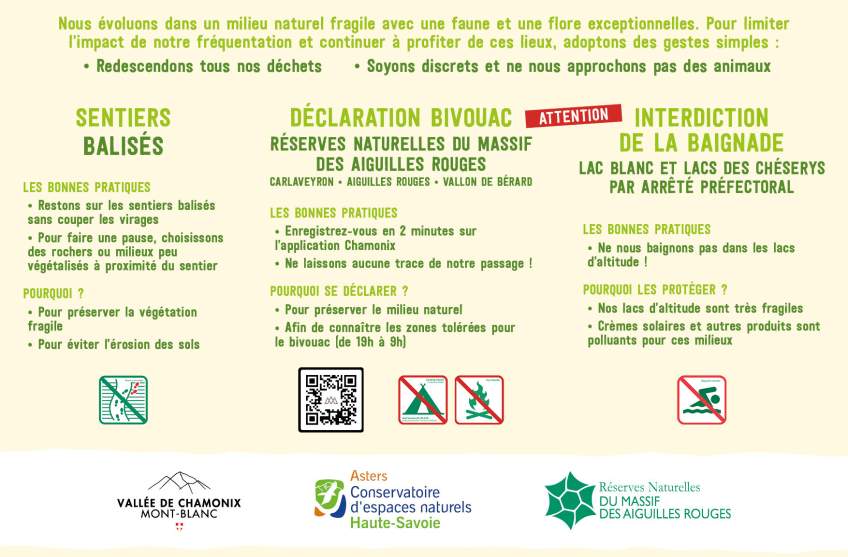
Focus Nature Reserves : good and banned practices summer 2023
Get ready to go.
The route, the safety, the conditions, the equipment: everything you need to know about the Tour du Mont-Blanc
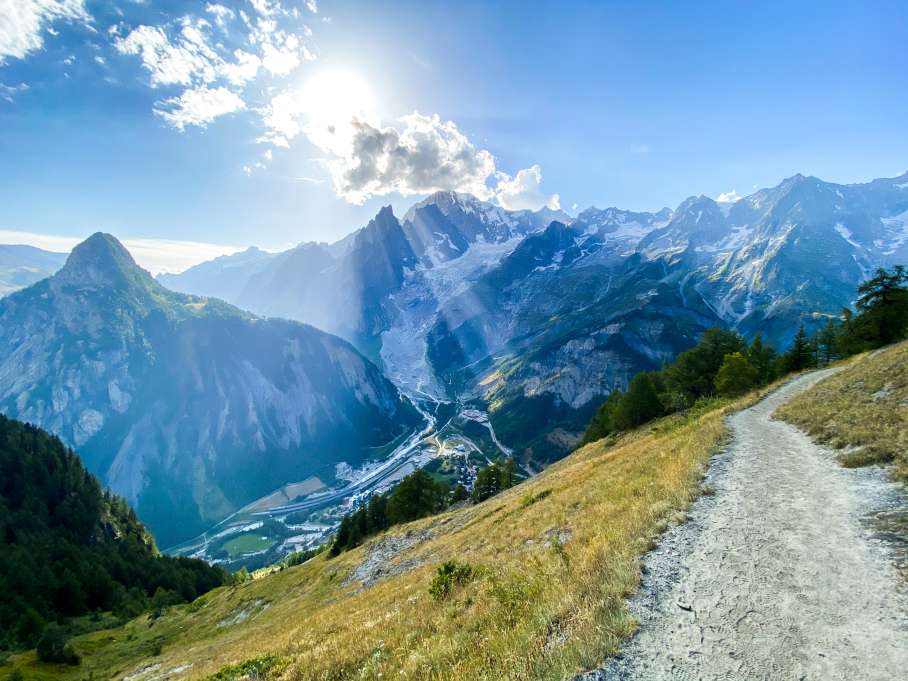
The TMB and the trails around Mont Blanc
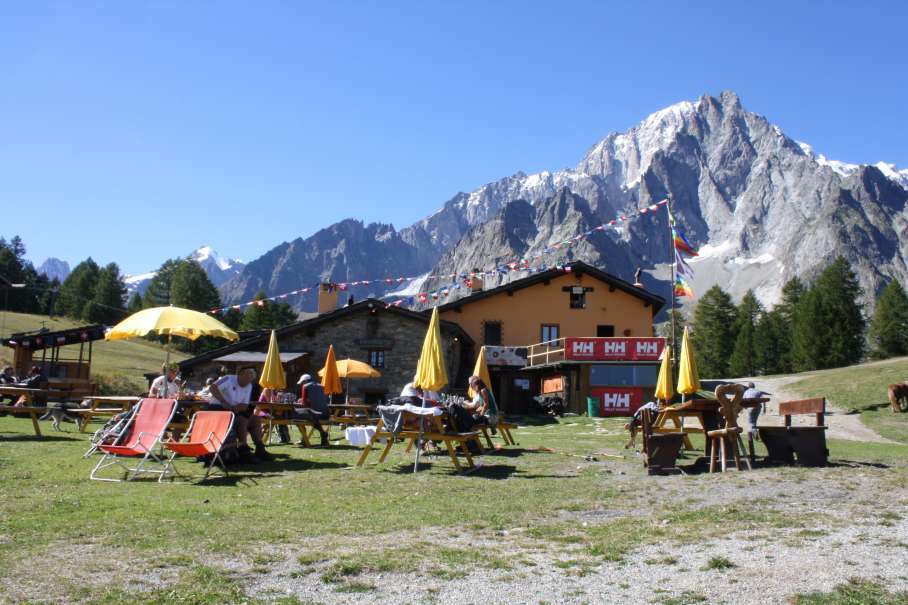
Accomodations
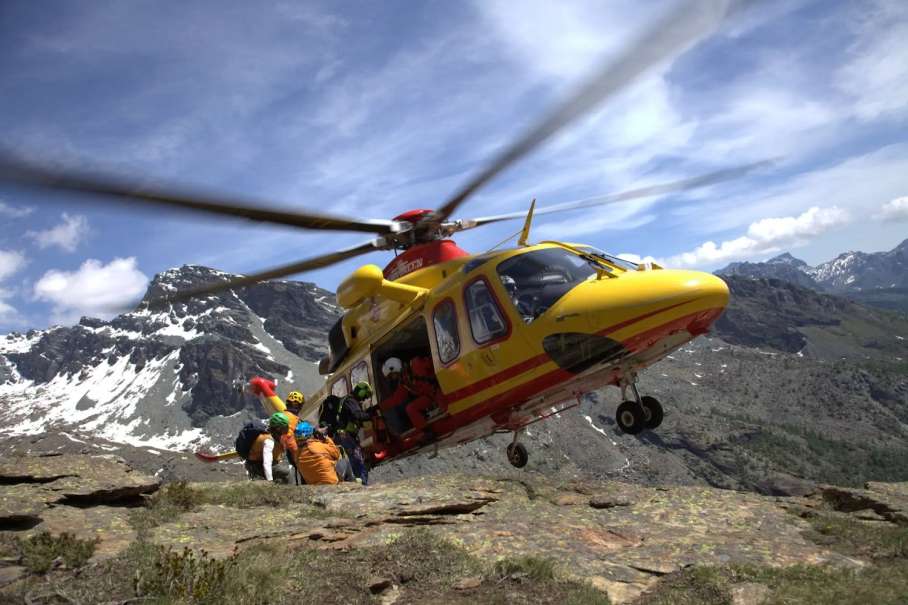
Cartography
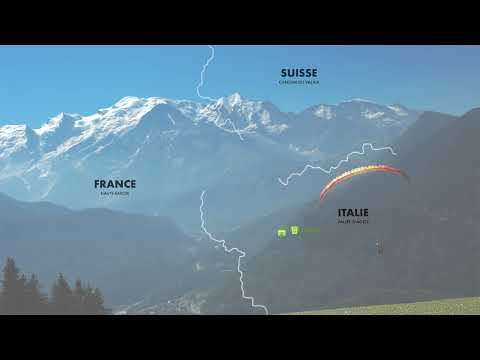
8 wonders around Mont Blanc
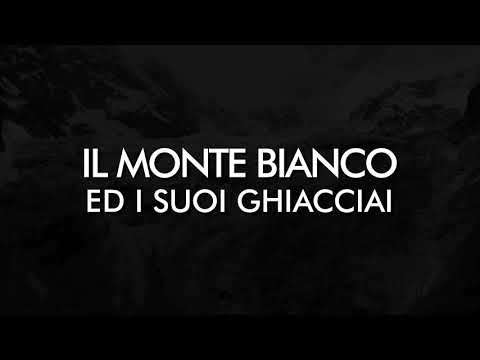
Il Monte Bianco ed i suoi Ghiacciai
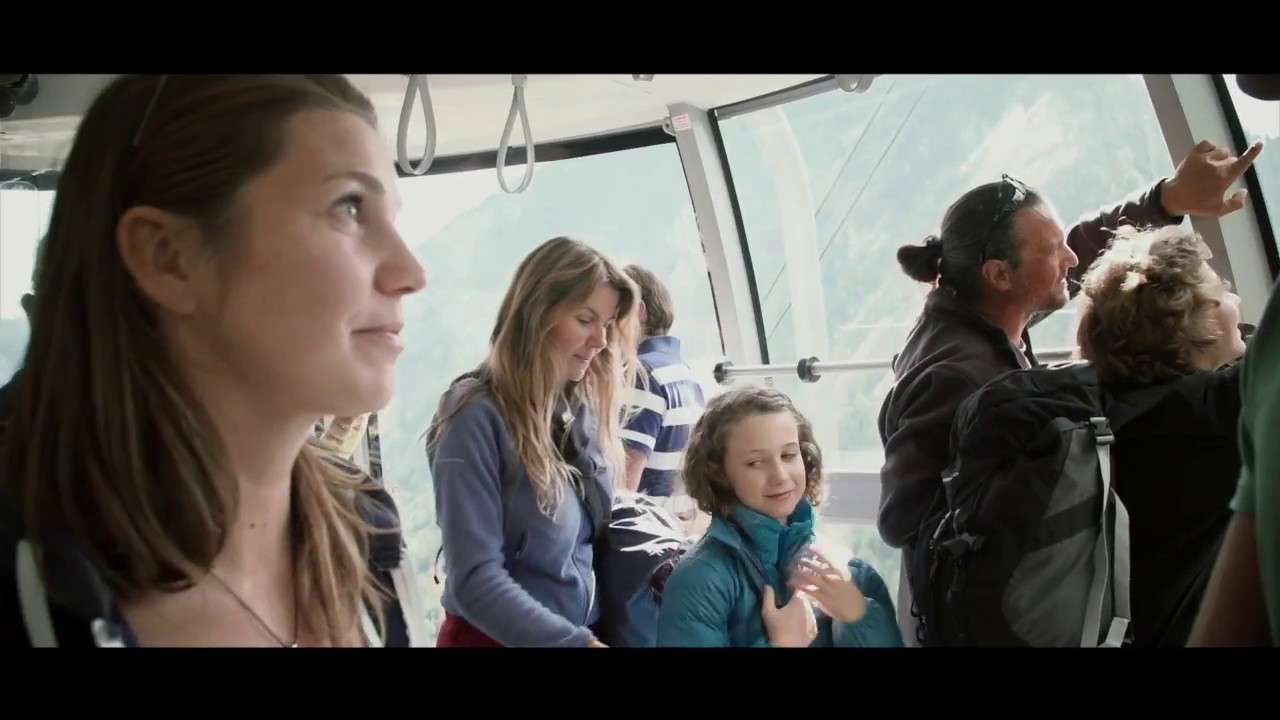
Video Tutorial Summer
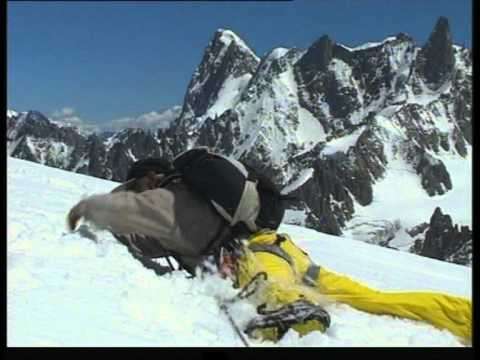
Prudence - Sécurité en montagne par la Chamoniarde
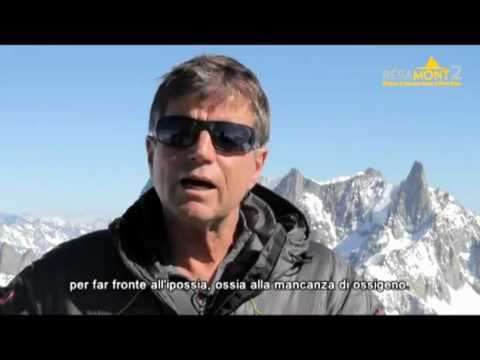
Age and altitude
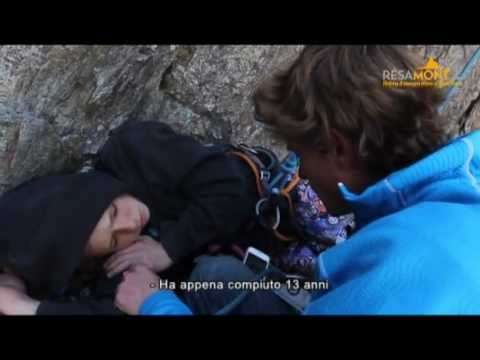
Telemedicine
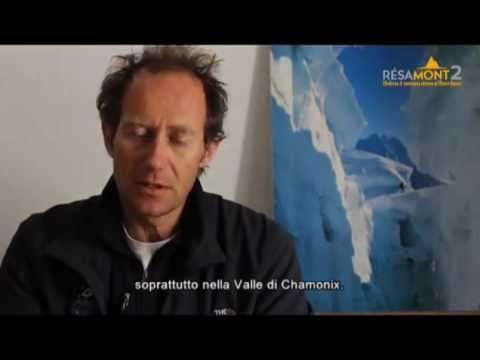
Séjours Transfrontaliers Espace Mont Blanc 2013
A collection of videos on the theme of the mountains
Come and discover the paths around Mont Blanc
Tour du Mont Blanc
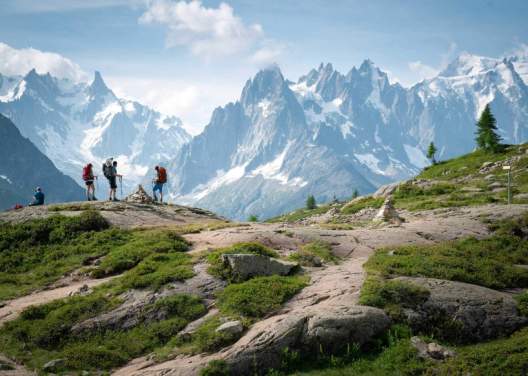
Alpage de Porcherey
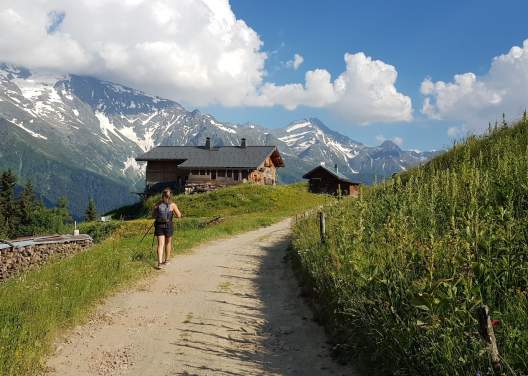
Alpage de la Peule
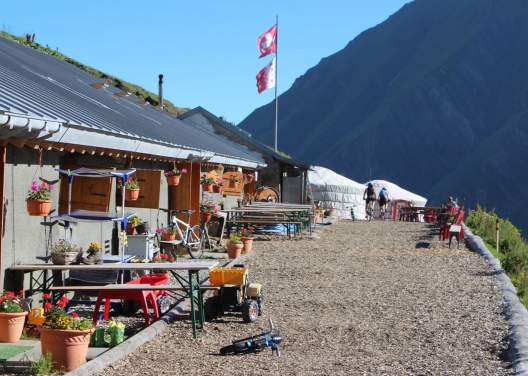
Rifugio Bertone
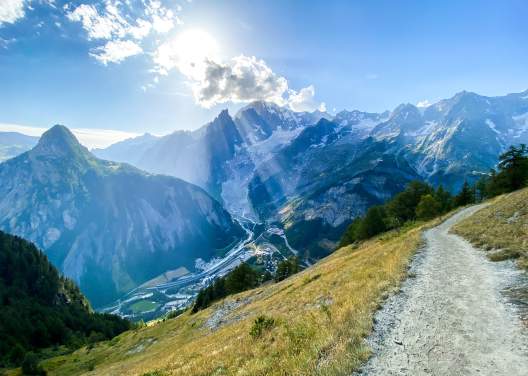
Update on the condition of the trails around Mont Blanc
Our mountains are a fragile environment with an exceptionnal fauna and flora.To limit our impact …
Mild weather and pleasant temperatures in this period of mid-june. the snowfields are rapidly …, starting from july 14th and until 30/10/21 it is forbidden to circulate by bicycle (including mtm ….
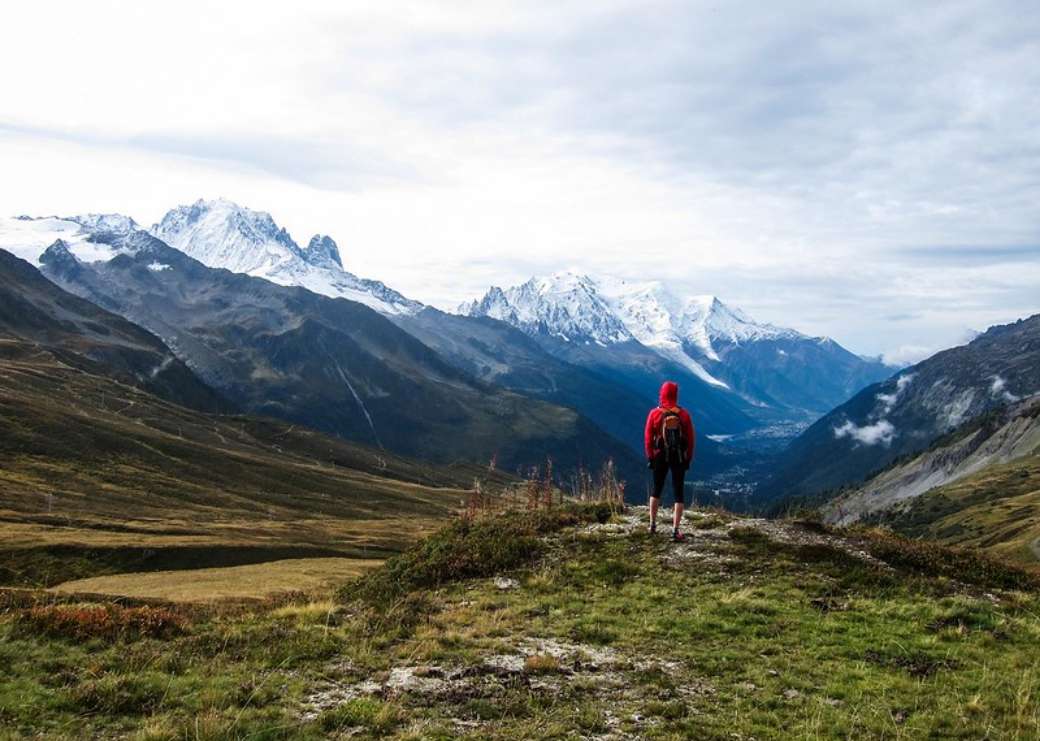
Una bella esperienza ad ovest
Gran bel trekking, non troppo impegnativo (dipende dai tempi e dal passo). Una bella occasione per godere di un panorama incredibile che ad ogni versante regala emozioni nuove. Noi l'abbiamo fatto tranquillamente in 8 giorni in …
Bonjour On vient de terminer le tour du mont blanc en famille avec 3 enfants de 10/11 et 13ans. Les conditions étaient excellentes. Juste un névé au Brevent où on a mis les crampons pour assurer la sécurité des enfants. …
Bonjour Je viens de terminer le TMB . Excellentes conditions météorologiques. 1 jour de pluie et col de balme brouillard et vent Des névés par endroits donc attention : col du bonhomme et brevent.et par ci par la Pour ma…

- Best Hikes In The World
- Appalachian Trail
- European Hikes
- Nepal Hikes
- Patagonia Hikes
- See All Hikes
- Mount Kenya
- Mount Kilimanjaro
- Mount Toubkal
- See All Mountains
- South Africa
- New Zealand
- Switzerland
- United Kingdom
- Packing Lists
Tour du Mont Blanc (Expert Guide)
Europe , France , Hikes , Italy , Mountains , Switzerland
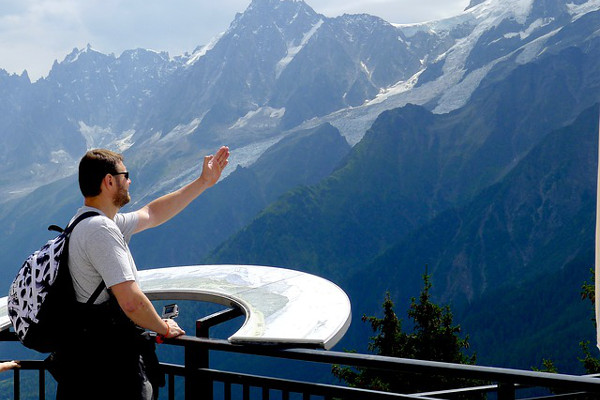
The Tour du Mont Blanc is one of the most popular treks in Europe. It covers a distance of roughly 170 kilometres and gains more than 10,000 meters of altitude over 11 stages.
In this guide we cover: what weather to expect and the best time to hike the Tour du Mont Blanc, which huts to book, what gear you might need, and much more...
Join a Tour du Mont Blanc Highlights Hike
Book with our recommended local guide
Tour du Mont Blanc
Route overview.
The Tour du Mont Blanc covers a distance of roughly 170 kilometres and gains more than 10,000 meters of altitude over 11 stages. Most people start their hike in Les Houches, France going in an anti-clockwise direction.
During this trek you will hike in the French, Italian and Swiss Alps and spend the night in mountain huts. This is one of Europe's best hikes and is a classic alpine trek. On the hike you will get splendid views of some of the highest mountains in Western Europe, as well as glaciers and alpine meadows.
The highest point reached is 2,665 meters.
The hike passes seven valleys along the way, which means there is a lot of altitude to be gained, making the Tour du Mont Blanc a physical challenge.
Fortunately, walkers are rewarded with some of the best views you can get of Mont Blanc . The route is not only one of the most beautiful long-distance treks in Europe (up there with the Walker's Haute Route ), but one of the most popular ones as well.
Nights can be spent in either mountain huts along the route or back in the valley, where you can have the luxury of a warm bed in a hotel.
What we like and dislike about the hike
- Incredible views of the Mont Blanc massif
- Hike in three countries
- Visit the beautiful villages of Chamonix and Courmayeur along the way
- Spend the night in some of Europe's most iconic mountain huts
- More expensive than other treks in Europe due to the cost of mountain huts
- Physically challenging
- Can be crowded during the summer months
Join the full Tour du Mont Blanc Hike (10-Days)
Tour du mont blanc circuit.
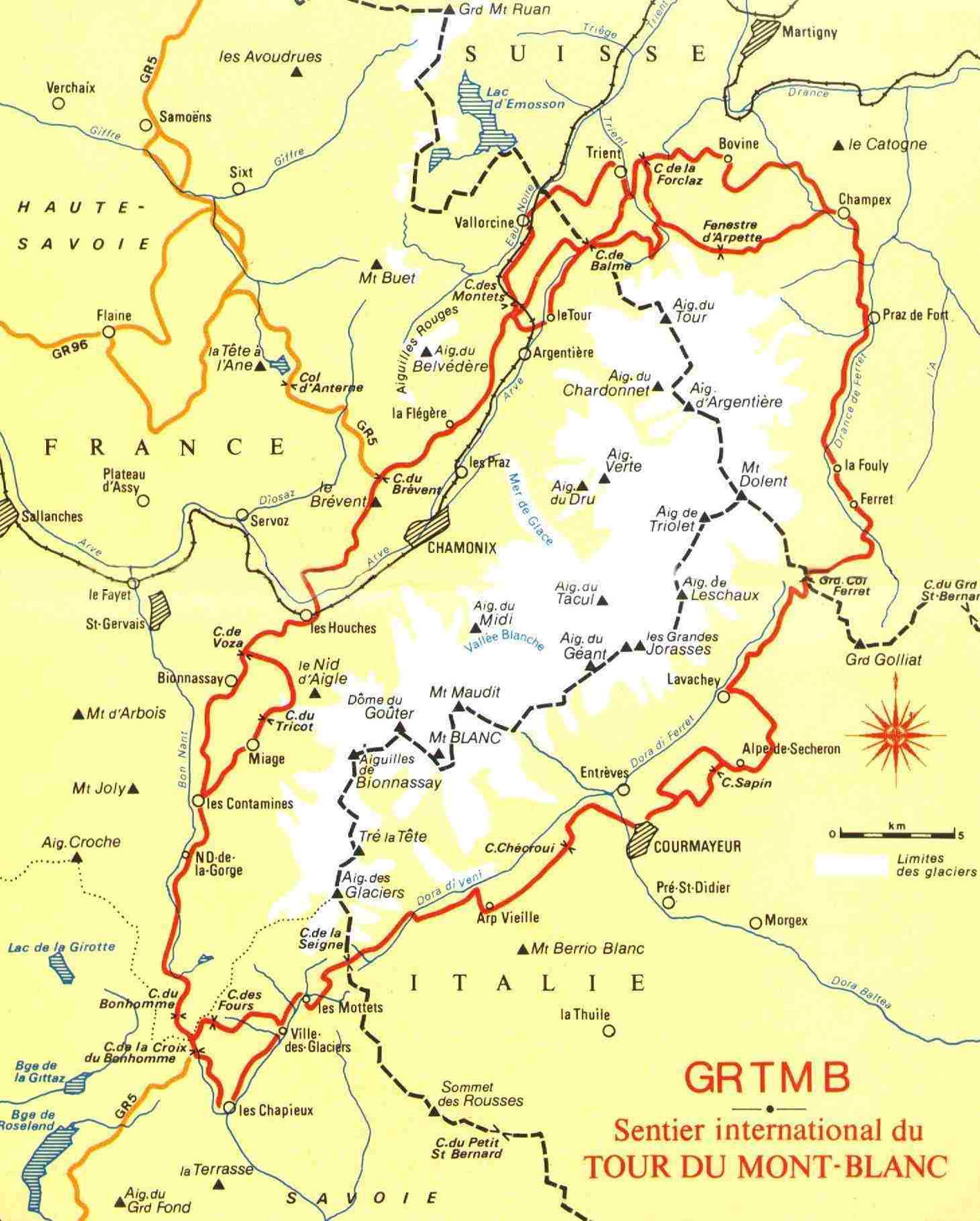
Source: chamonix.net
This map illustrates the Tour du Mont Blanc route. It starts off at Les Houches, France close to the Swiss and Italian border before heading west towards the Italian side of Mont Blanc.
There are 11 stages depending on your physical level. The route is circular around the Mont Blanc Massif, crossing the borders of France, Switzerland and Italy.
In terms of a trekking map we recommend:
- Chamonix, Mont-Blanc ~ IGN Top25 3630OT 2012 (English and French Edition)
And in terms of a trekking guide we highly recommend:
- Cicerone's The Tour du Mont Blanc: Complete two-way trekking guide
Altitude Profile
In the chart below you see the altitude profile of the full hike. It is quite clear there is a lot of altitude to be gained over the 11 stages, with the highest point reached just above 2500 meters. You can see that there are a few strenuous stages reaching high mountain passes that will require great effort.

Mont Blanc Route Itinerary
Below we have laid out the most popular version of the Tour du Mont Blanc Route – 11 days, starting and finishing in Les Houches. The itinerary includes approx. distances, hiking times and elevation changes.
Day 1: Les Houches – Les Contamines
Distance: 16 km Ascent: 646m Descent: 633m Hiking time: 5hrs
Easy first stage along, this is the most roadway you will see during the trek. The best views are to be seen at Col de Voza, where you get a look at Dome du Gouter and Aiguille de Bionnasay, with the glacier splitting it in half.
Day 2: Les Contamines – Les Chapieux
Distance: 18 km Change in elevation: 1316m+, 929m- Hiking time: 7.5hrs
A bit tougher than the first stage. Especially, since there is quite some altitude to be gained and distance covered.
Day 3: Les Chapieux – Rifugio Elisabetta
Distance: 15 km Change in elevation: 1004m+, 258m- Hiking time: 4.5hrs
This is the day you will leave France and enter Italy via Col de la Seigne. Despite being a short day, there still is some elevation to be gained as you will pass Col de la Seigne. At the highest point, you will gain some great views of both France and Italy and gaze into Val Veni. This is the first night you will spend in a mountain hut.
Day 4: Rifugio Elisabetta – Courmayeur
Distance: 18 km Change in elevation: 460m+, 1560m- Hiking time: 5hrs
Another short day, since you will mainly be descending. Still, some great views will be shared before reaching Courmayeur, the Italian equivalent of Chamonix.
Day 5: Courmayeur– Rifugio Bonatti
Distance: 12 km Change in elevation: 860m+, 101m- Hiking time: 4.5hrs
Often described as the most scenic stage of the Tour du Mont Blanc. With views on the glaciers of Planpincieux and Frebouze it’s not hard to see why. The high route along the Mont de la Saxe Crest is thought of as one of the best viewpoints of the southside of the Mont Blanc.
Day 6: Rifugio Bonatti – La Fouly
Distance: 20 km Change in elevation: 895+, 1410m- Hiking time: 6.5hrs
Today will cross another border and enter Switzerland. Cowbells and tiny villages that have been stuck in time are your scenery for the next few days.
Day 7: La Fouly - Champex
Distance: 15 km Change in elevation: 420m+, 565m- Hiking time: 4hrs
This probably is the easiest stage of the Tour du Mont Blanc since there are no cols to be conquered. This stage mainly is a valley trek with some great charming villages along the way. However impressive views of the mountains remain.
Day 8: Champex – Col de la Forclaz
Distance: 16 km Change in elevation: 742m+, 682m- Hiking time: 4.5hrs
There are two ways to reach Col de la Forclaz. A lower route via Alp Bovine, or the more scenic and higher route along the Trient Glacier. This latter passes the Fenetre d’Arpette, the highest point on the Tour du Mont Blanc, and should only be considered in good weather.
Day 9: Col de la Forclaz – Tre le Champ
Distance: 13 km Change in elevation: 1069m+, 1168m- Hiking time: 5.5hrs
From this point you re-enter France via Col de Balme. A lot of elevation is to be gained and lost, which makes the stage a strenuous one.
Day 10: Tre le Champ – Refuge Flegere
Distance: 8 km Change in elevation: 733m+, 257m- Hiking time: 3.5hrs
Short stage, but with some ascent. You will spend another night in a mountain hut. Refuge Flegere offers great views and is a perfect last night in the mountains before arriving in Les Houches the next day. There are some ladders to be climbed before reaching the refuge however.
Day 11: Refuge Flegere – Les Houches
Distance: 17 km Change in elevation: 772m+, 1546m- Hiking time: 6.5hrs
This last stage of the Tour du Mont Blanc goes along Le Brevent in the Aiguille Rouge. There are some splendid views of the Chamonix Valley before finally descending and arriving back in Les Houches.
Video Overview
A beautiful video overview, filmed with a GoPro, of the Tour du Mont Blanc by Eugenio psnt .
Join a Tour du Mont Blanc Hike
Frequently asked questions, how much does the tour du mont blanc trek cost.
The cost of the Tour du Mont Blanc trek is dependent on whether you plan to do a self-guided hike or join a planned tour. Self guided hikes cost in the region of $1500 (estimate of $50-$75 dollars a day). Most mountain huts / gites are around $50 (incl. breakfast).
Guided trekking tours can be quite expensive since not only do you pay for the guiding service, but you eat and spend most nights in hotels or mountain huts. This mostly includes a luggage transfer to your next accommodation as well, so you can hike with a small backpack. Guided tours range from $2000-$3500, depending on the company / season / size of the group.
Self guided is the cheaper option, however, it does mean you carry more weight in your backpack and some planning of logistics in the weeks / months before.
Are permits required for the Tour du Mont Blanc trek?
No permits are required for the Tour du Mont Blanc trek.
When is the best time to trek the Tour du Mont Blanc Route?
The best time to trek the Tour du Mont Blanc is between July-September, but exact start and end dates depend on the amount and timing of the previous winter’s snowfall and the onset of cold weather in the Autumn.
Since the Tour du Mont Blanc crosses high passes, snow could create problems / dangerous conditions. Therefore in a normal year it is not advisable to set out before July. In the summer months, mid-July through to end of August, are the busiest, and temperatures during the day can rise to 25 degrees. Nonetheless, thunderstorms or a dump of snow is possible as well.
By the end of September, huts will close and it might get a lot harder to complete the trek.
Is altitude sickness a risk?
No, you will cross passes slightly higher than 2500 meter and since you’re hiking slowly to this altitude, you have more than sufficient time to acclimatize. Most people don’t feel any symptoms of altitude sickness before reaching 3000-3500 meter.
How difficult is the Tour du Mont Blanc trek?
Hiking the Tour du Mont Blanc comes with great rewards. Rewards that will be more easily gathered when physically fit and mentally attuned. There are many steep and uphill sections to conquer, so exercising regularly at home before the trek is necessary to get in shape for the physical demands of this route. Mental fitness is as important and often go hand in hand.
The Tour du Mont Blanc is doable for any fit mountain walkers who are able to hike between 5h and 7h30 min per day for several days in a row.
If you are finding the trek tough there are a few sections where you can use public transport to shorten your hike.
What gear do I need?
To do a serious trek like the Tour du Mont Blanc, appropriate clothing and equipment is a must.
Some comfortable lightweight trekking boots are a must to enjoy this trek, while good waterproofs might be essential, not only to protect you against rain or snowfall but to double as wind-proofs. Since you’ll be crossing passes of more than 2500 meters, gloves and several layers will prove useful. Trekking poles are a good way to not overload your knees and ankles
To help you plan and prepare for your trek we recommend our Tour du Mont Blanc packing list .
What travel insurance do I need?
Trekking insurance is important when going into the mountains. See our article on insurance for more information.
Do I have to carry my own gear all the way?
It’s up to you. There are many organisations offering guided trips for this hike, meaning they do all the logistics for you. This often includes a luggage transfer to your next accommodation in the valley, so you only need to carry a small backpack with some lunch, snacks and clothes.
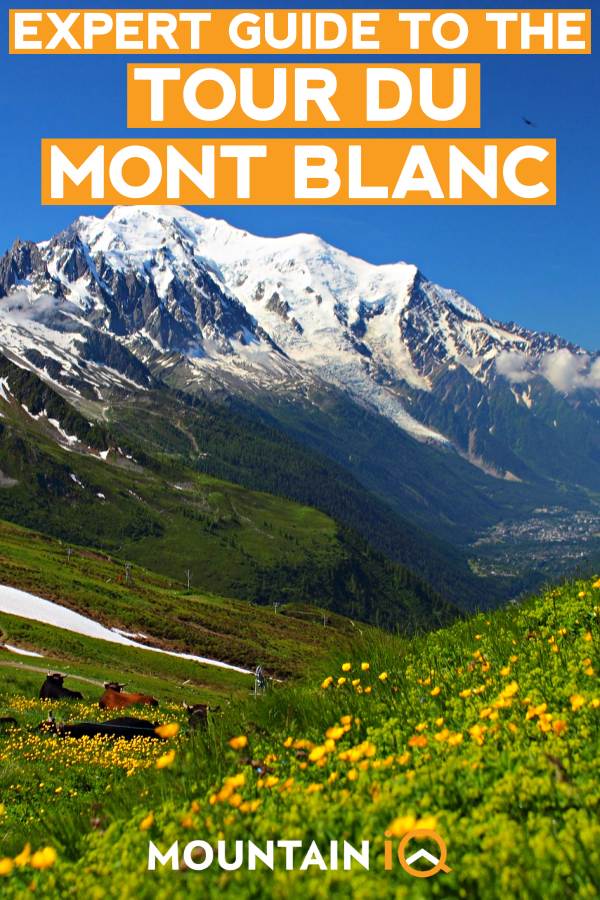
Browse more hikes in Europe
See our top European hikes picks, or check out these popular hikes.
- Tour de Monte Rosa
- Walkers Haute Route
- Camino de Santiago Routes
- Cinque Terre Hiking
- West Highland Way Hike
- El Caminito del Rey
- Laugavegur Trail
- Kungsleden Trail
- Rota Vicentina
- Slovenian Mountain Trail
About the author
Mark Whitman
Mark has trekked extensively in Asia, Europe, South America and Africa. He founded Mountain IQ in 2014 with the sole aim to be the best online information portal to some of the most popular mountain destinations around the world. When not writing for Mountain IQ, Mark is out exploring the outdoors with his wife!
Leave a Reply
Your email address will not be published. Required fields are marked
Hi Dempsey,
I’ve been thinking about doing that hiking for a long time and I think, after this pandemic crisis, it’s the time to see my dream coming true. I hope to do it as soon as possible, and to see it how beautiful the nature around is. Stay safe,
João Leite.
Wife and I are interested in doing this in last half of August. I know it is (too) late to reserve now. We plan to show up and hope for the best, perhaps taking advantage of late cancellations on a guided/luggage transfer arrangement. Any advice?
Hi Mike, there are a few dates available on this TMB highlights tour, which is amazing if you’re looking for a short circuit: https://www.skyhookadventure.com/trips/tour-du-mont-blanc-highlights
We work with local guides to offer great value adventures at unbeatable prices
Why the Tour du Mont Blanc is the ultimate mountain hike

Nov 9, 2023 • 6 min read
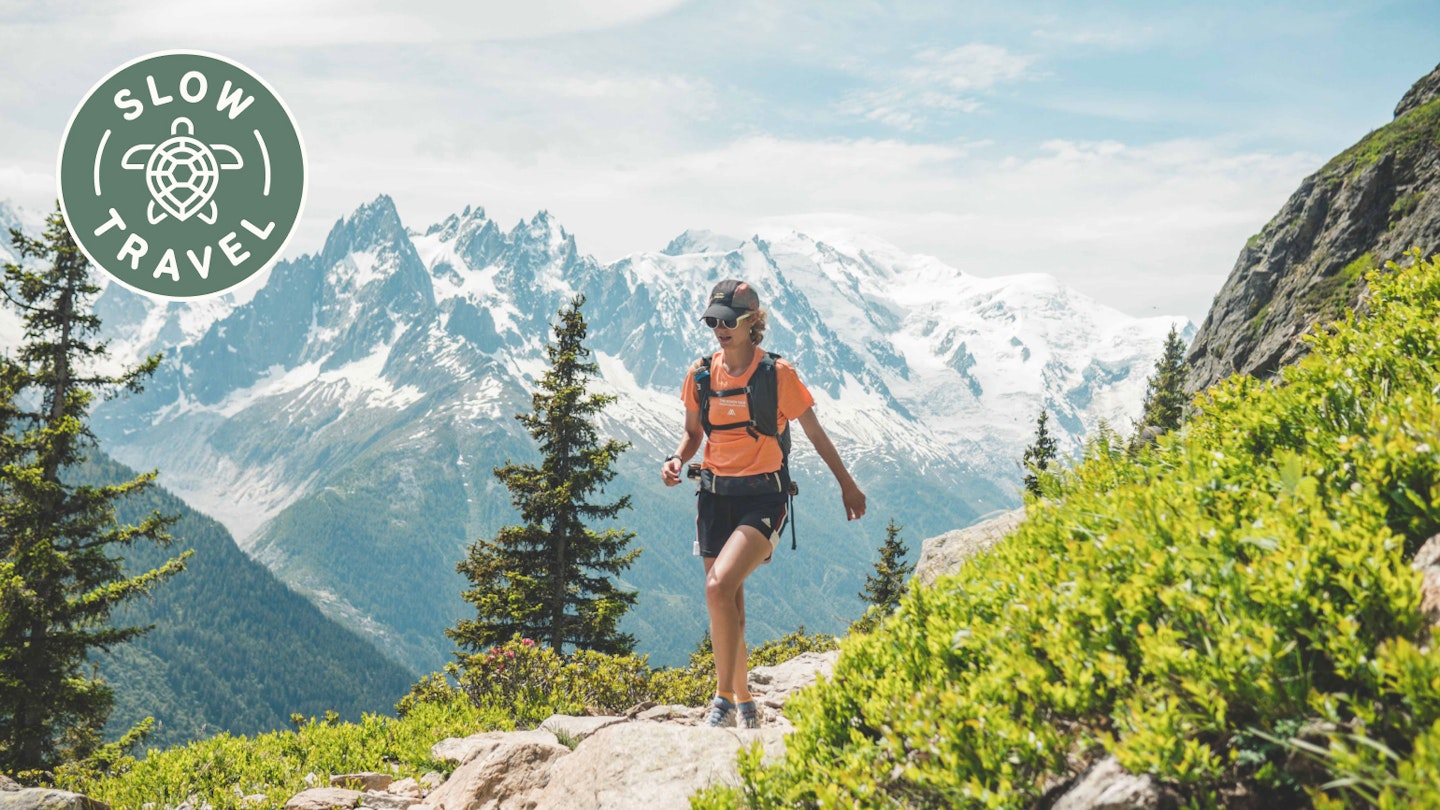
Few multiday mountain hikes rival the Tour du Mont Blanc © Quentin Boehm
If you’ve got one European long-distance hike on your bucket list, it’s probably the Tour du Mont Blanc. It was on mine, too.
Views over sparkling glaciers, Alpine prairies and lots (and lots!) of cheese await anyone who embarks on this border-crossing trek. Circling the largest peak in the Alps , Mont Blanc, the trail covers 170km (105 miles), climbs more than 10,000m (32,800ft) in cumulative altitude, and weaves through three Alpine countries: France , Italy and Switzerland . Typically, the route begins and ends in Les Houches, France, and follows a counterclockwise loop around the mountain range.
Every dream feels far away – until we start to break down what we need to do to achieve it. Here’s what it takes to hike or run the Tour du Mont Blanc.
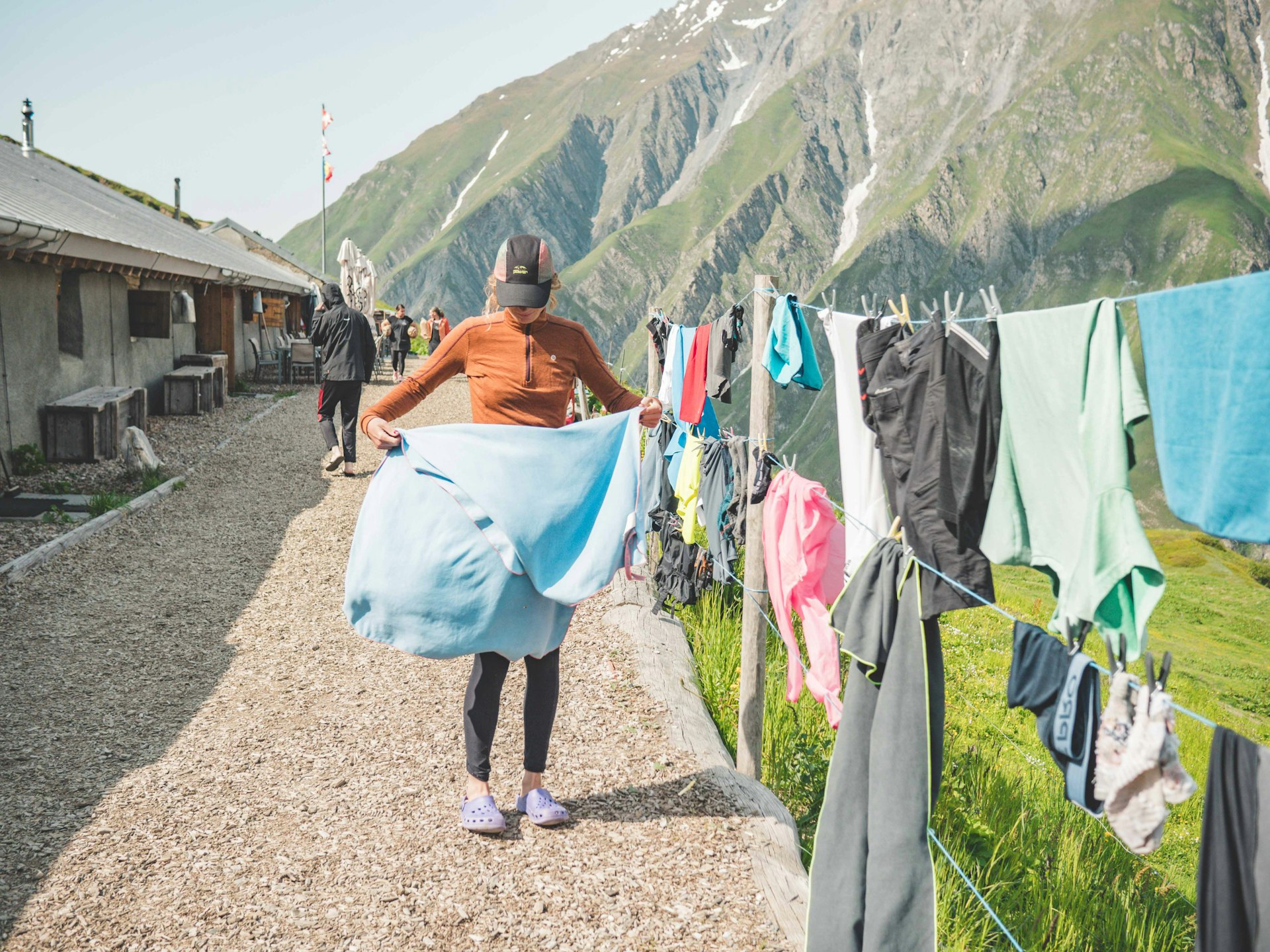
How I prepared for the Tour du Mont Blanc
Don’t laugh at the folks who’ve sawed off the handle of their toothbrush to save on weight. Many of the climbs along the Tour du Mont Blanc are arduous, and every gram really does count.
My first question as I prepared my bag was, Where would I sleep? Opting for camping would make the trek feel really wild, let me spend more time in nature and give a bit more flexibility about where and when I’d arrive each night. On the flip side, this would mean my home would be on my back (like a turtle), and heavy enough to reduce my walking speed significantly.
The other option was to sleep in refuges , or mountain huts. Refuges can range from rows of bunk beds to rooms that are almost luxurious – yet what they all offer in common is a dry place, sheltered from the elements. Plus (with rare exceptions), the dinners are delicious. Staying in refuges means no need to pack any camping or cooking gear, freeing up a lot of room in your backpack.
Each refuge has its own culture and way of working, says Céline Mila, the gardienne (caretaker) of Refuge des Prés in the Contamines Valley. “Usually that means taking off your shoes before entering, and taking your trash away with you. The best way to get oriented at the refuge is by coming to see us when you arrive – it’s our job to share the mountain culture with you.”
For my 2023 Tour du Mont Blanc, I decided to stay in refuges the whole way.
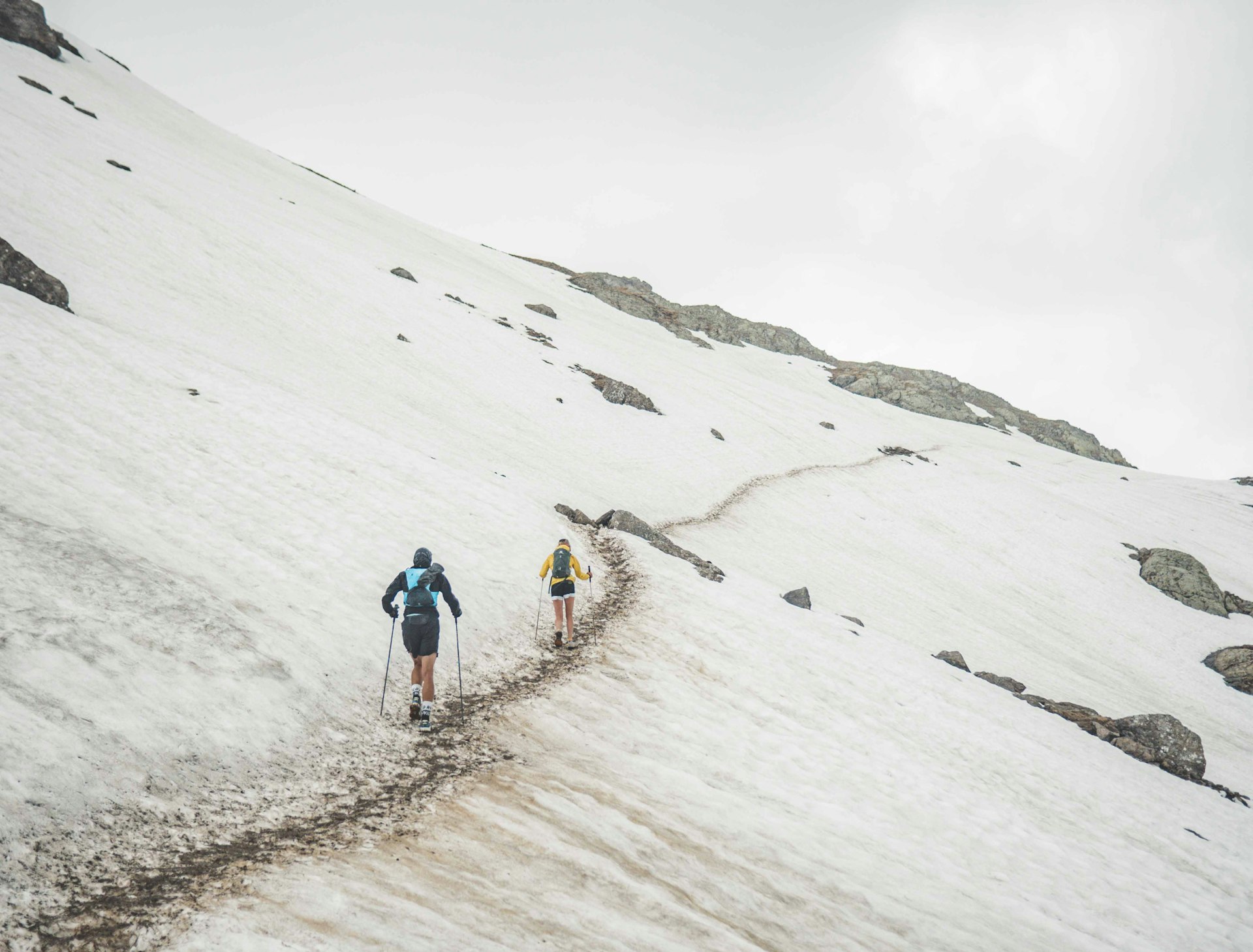
What is the best time to do the Tour du Mont Blanc?
To beat the crowds, I decided to run the tour in mid-June. Even at the onset of summer, there was still quite a bit of snow above 1800m (5900ft), and many hikers brought along small snow chains to keep from slipping. I loved the extra challenge of the snow and the cooler daytime temperatures. July and August are the busiest months for the route, when the trail can sometimes feel like a highway. By September, things slow down again – but the huts also start to close up for the winter. While weather in the mountains can vary each year, usually July and August have the highest number of stable, rain-free days.
How long does the Tour du Mont Blanc take? And what do you eat along the route?
Hikers typically complete the loop in between seven and 10 days, and the fastest trail runners complete the journey in a staggering 20 hours. Regular trail runners tend to take things a bit slower, between three and four days.
Since I was running the loop in four days, I packed only the barest essentials so as not to weigh myself down: a pair of leggings and a long-sleeve shirt to sleep in, a thin fleece for the mornings, a light raincoat, a pair of light gloves, a change of socks, my toothbrush, sunscreen, sunglasses and a headlamp. Plus, I wanted to eat as much local food as possible: crozets (cheesy pasta) in France, pizza in Italy and croûtes (a cheesy bread melt) in Switzerland.
Dinners were included in my demi-pension , or half-board. For lunch, I usually ordered the refuge ’s picnic to eat along the way. While they’re nothing fancy, the sandwiches or even just bread, smoked meat and cheese always hit the spot.
Alix Noblat , an ultra-trail runner and specialist in nutrition in endurance sports, once told me to eat every half hour – before my stomach starts rumbling. So I always keep a snack on me, like protein bars or Snickers. Anything that can give me an energy boost is always in my pack.
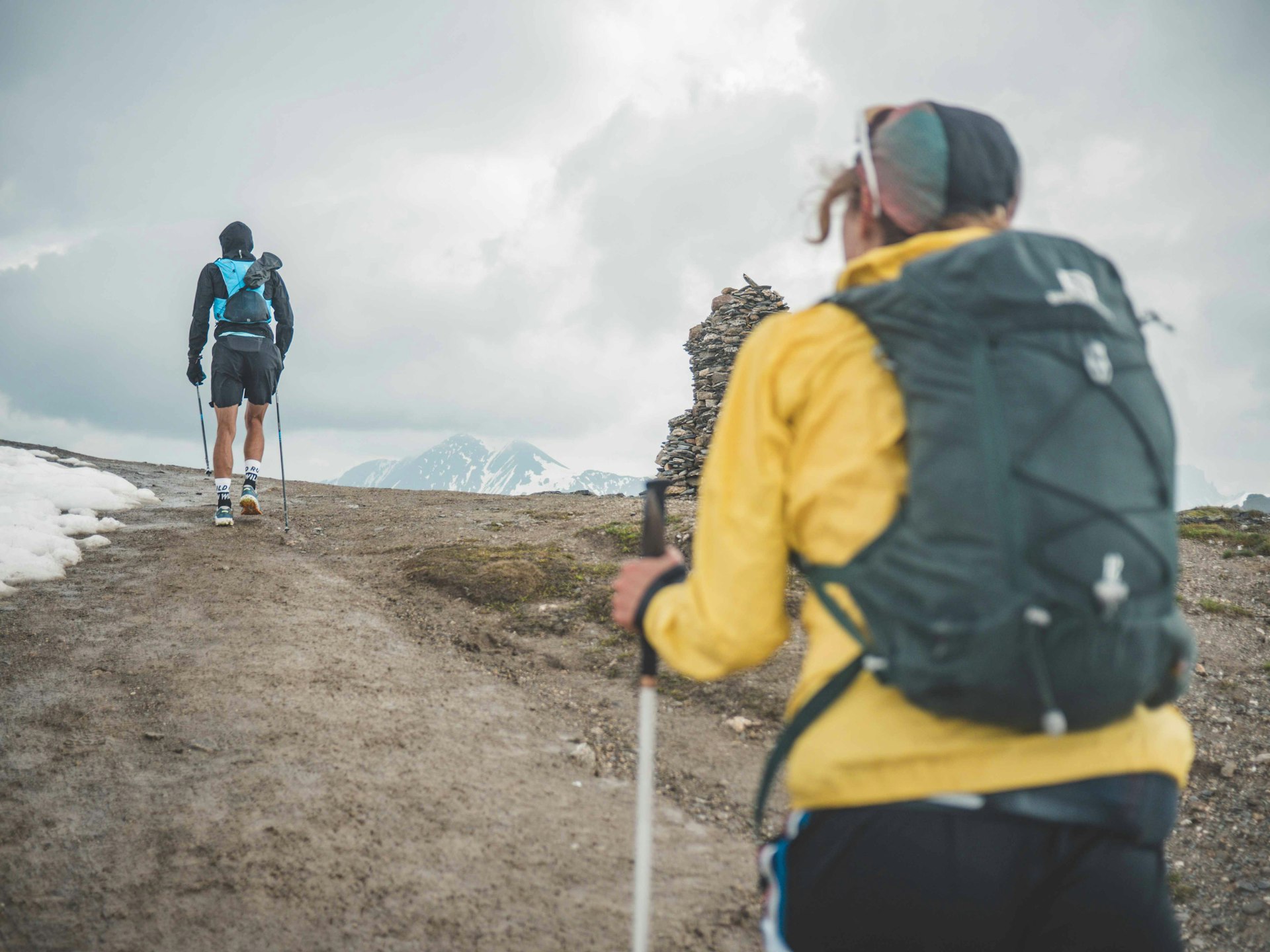
The highs and lows of the Tour du Mont Blanc
After a few days on the trail, your sense of time and distance changes. Hikers will no longer measure their day by kilometers or hours traveled – but rather by the cols , or mountain passes, that they’ve reached. The most famous ones are:
- The Col du Bonhomme, which connects the lush Contamines Nature Reserve with the Alpine pastures of the Beaufortaine.
- The Col de la Seigne, at the border between France and Italy, with a spectacular view of Mont Blanc, Aiguille du Peuteurey, Dent du Géan and the treacherous Grandes Jorasses.
- The Col Grand Ferret, at the end of the remote Val Ferret, which brings a long, steep climb – and a descent on the other (Swiss) side that’s rolling and blissful.
- The Col de la Balme, overlooking Chamonix valley, which brings hikers back into France for the final few legs before the finish.
And don’t forget the valleys. The TBM passes through winter-sports hubs like Chamonix and Courmayeur , as well as through smaller Alpine valleys. A standout valley is the Val Ferret: the trail runs high above the lush green pastures on the valley floor, giving a splendid view of the mineral rock faces of the range on the other side. Plus, the Rifugio Walter Bonatti ’s cappuccinos are the best you’ll find anywhere above 2000m (6500ft).
Do you need to be in great shape to hike the Tour du Mont Blanc?
You should physically prepare for the hike, yes. Getting in shape for the TMB is a question of cardio training and foot preparation. Hikers should be fit enough to cover their desired distance each day, of course. But don’t forget to prepare your feet to avoid blisters: break in hiking shoes before the first day of the hike, and bring along anti-chafing cream if you’re worried you might have rubs.
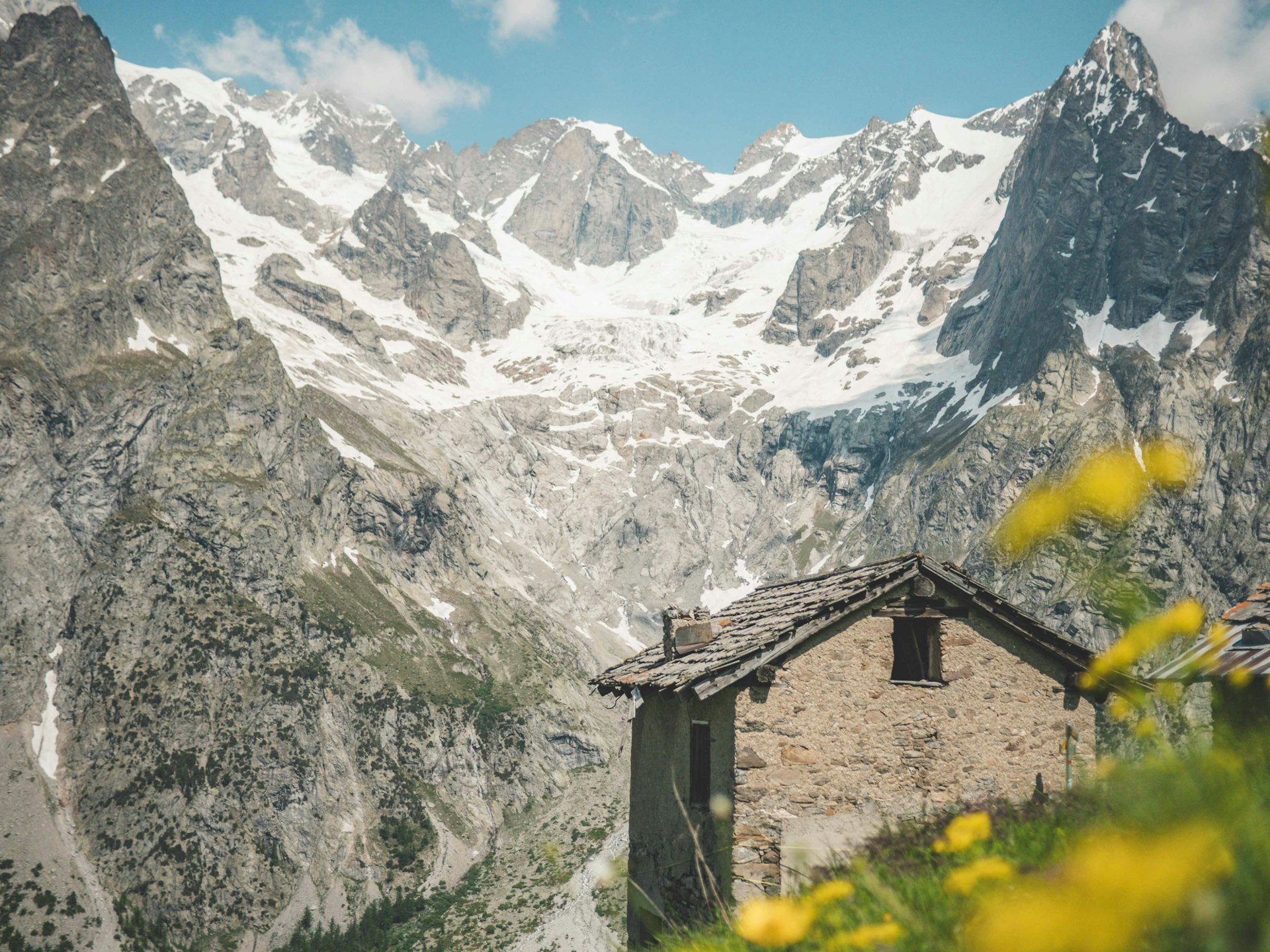
Ready to make it happen?
This is a trek you should book early – at least two months out – to find secure space at the refuges . Yet it can be planned at the last minute for those who prefer camping. Autour du Mont Blanc is an easy-to-use website that helps plan daily stages. You can also reserve huts here.
The views…the food…the marmots! The Tour du Mont Blanc delivers at every step.
Explore related stories
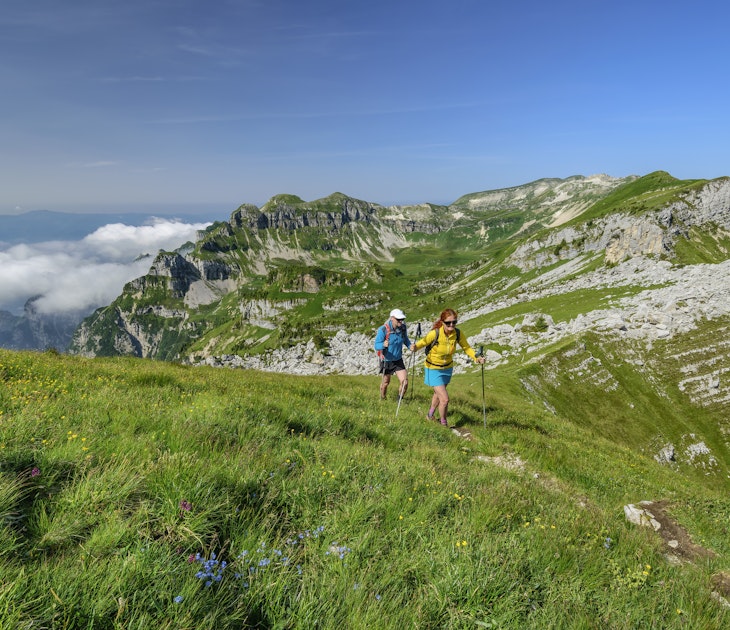
Mar 14, 2024 • 16 min read
Experience some of Europe's best wildlife, nature and landscapes this summer at these national parks.
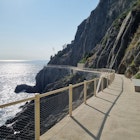
Jul 27, 2023 • 2 min read
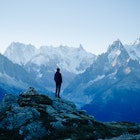
May 20, 2023 • 8 min read
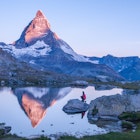
Dec 1, 2022 • 11 min read
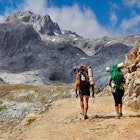
Jul 17, 2022 • 6 min read

Jul 13, 2022 • 8 min read
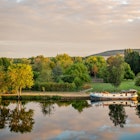
Jun 29, 2022 • 5 min read
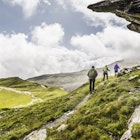
May 24, 2022 • 2 min read
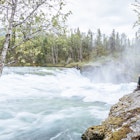
Mar 14, 2022 • 7 min read

Jan 31, 2022 • 6 min read
Create an account
Start your adventure today.
Already a member? Login

Tour du Mont Blanc Guide: Here’s Everything You Need to Know
Quick navigation, the basics of the tour du mont blanc, how to prepare for the tour du mont blanc, best time to hike the tour du mont blanc, tour du mont blanc elevation, tour du mont blanc map, tour du mont blanc tours, tour du mont blanc articles, join our newsletter.
Get a weekly dose of discounts and inspiration for adventure lovers
The Tour du Mont Blanc ranks as one of—if not the—best long-distance treks in Europe. Revel in unobstructed views of the European Alps as you circumnavigate the Mont Blanc Massif, traversing three countries en route: France, Italy, Switzerland. It takes most trekkers between eight to eleven days to complete the trek. On top of that, expect an average of 15.0 km of hiking a day, five to seven hours of walking, and around 1,000 m elevation gain. It may sound exhausting, but the hanging glaciers, soaring peaks, and colourful meadows create the ultimate distraction!
Want to know more information? Read on to find out all you need to know about the complete Tour du Mont Blanc Trek !

Accommodations
Tour du Mont Blanc accommodation options are a common theme among TMB hikers. Firstly, you’ll find a wide variety of places to sleep. So, if you want to hike without hurting your wallet too much, you can camp, or you can opt to stay in the many refugios or hotels. A refugio, refuge, or mountain hut is a mountain hostel with relatively basic interiors but typically fantastic food! Note that some have private rooms, but many just offer shared dormitory-style accommodation.
Along with the variety of accommodation options, there are also many ways to arrange the tour. Many opt to do the planning themselves—booking their own hotels and carrying all their clothes with them—but it’s also nice to have a little help.
In peak season (July and August), it may be better to have someone arrange the accommodation bookings for you and the luggage transfers. However, making reservations is not without challenges as it commits you to a route and doesn’t account for health issues or delays, such as muscle strains or blisters.
Outside of peak season, we typically make reservations day-to-day. This allows us to listen to our bodies and plan each day based on our feelings. We cover which refuges/refugios to consider, camping options, and discuss private rooms in our article that details accommodations along the Tour du Mont Blanc .

Col de Baume on Tour du Mont Blanc in France
Ah yes, the big ole’ question: how much does the Tour du Mont Blanc cost? We could spit out a number, but the calculation takes a little more thought. First, you’ll have to consider your hiking style—are you more rustic and prefer camping? Would you rather alternate between hotels and refuges? Or stay in refuges and refugios (Italian version) whenever possible? Or kick back and relax in a private room as much as you can? Will you travel alone? Take public transportation throughout? So many things to consider! Here’s a quick snapshot:
Let’s say you’re setting off from Les Houches in a counterclockwise direction, staying ten nights, might consider transportation due to weather or tiredness and plan to stay in refuges as much as possible while enjoying the half-board option offered at most. How much will your trip cost? It could cost around 800 euros, give or take a couple of hundred euros, this includes breakfast, snack, and drink considerations. Our article on how much the Tour du Mont Blanc costs offers a more precise picture of the price you may have to pay.

Elisabetta Hut on Tour du Mont Blanc trail
The Tour du Mont Blanc spans 170.0 km , granting plenty of time to bask in the wild, undulating scenery stamped by the intoxicating Mont Blanc Massif . Most trekkers complete this incredible outdoor adventure in 8 to 11 days, but transportation assistance can shorten your time. Taking alternate routes along the trail may also manipulate how long you spend trekking. Those hoping to camp the whole time will have to take alternate routes to meet their tenting goals. Discover more info via our article on how long it takes to hike the Tour du Mont Blanc .
Something else TMBers are quick to mention is the food along the Tour du Mont Blanc. Stop at one of the mountain huts along the way for an espresso and a croissant!
It may be beneficial to carry around snacks or energy bars for lunch, and you can always check in with a mountain hut to see if they’re offering lunch. Some huts may even provide a packed lunch to overnight guests before they set off for the day.
It is hard to overstate how wonderful it is to be sitting outside on a sunny summer day with a cold beer, a freshly baked margarita pizza and staggering views of sheer cliffs and pointed peaks. It is one of the real treats of the trek.
As we mentioned, mountain huts offer the option of half-board or full-board. If you opt for the latter, all three meals will be provided in many cases. And one of the biggest culinary benefits of walking through three different countries is that your meals will each reflect the unique cultural and regional gastronomy. We always love staying at the high Italian refugios and getting good red wine and hearty, delicious pasta. After this, we come down to Switzerland and a steaming pot of delicious fondue.
While most serve excellent food, some mountain huts don’t have the most outstanding cuisine reputation, so try not to go in with high expectations every day.

Meal on Tour du Mont Blanc trek
Transportation
Find transportation assistance all over TMB, from gondolas to shuttles to buses; there’s almost always a way to get you from A to B if you’re not in the mood to hike or want to avoid the rain, etc. Most buses and shuttles run every 30 minutes to an hour during peak season, with cable cars going around 20-30 minutes. Expect to pay more for cable cars and chairlifts, around 10 EUR to 25 EUR, whereas buses often go for under 10 EUR. You’ll find some form of transportation in each stage as you trek!
Preparing for a trip can be stressful, especially a hiking adventure such as the Tour du Mont Blanc. First things first: you’re in the backcountry, you’re on your feet all day, you’re moving. This means one thing—fitness is key! What else can you do? It’s helpful to do whatever you can do to prepare for the Tour du Mont Blanc to ensure ultimate enjoyment and little stress. Take a look at some tips below:
- Start training!
- Book your accommodations super far ahead of time
- Secure travel insurance
- Find out the documentation you might need
We could go on and on, but thankfully, we don’t have to since we’ve already discussed how to prepare for the Tour du Mont Blanc in detail here !

Mountain Views Baby
What to pack
Put your hand up if you despise packing. Most of us can relate! Packing can be a punishing task. Should I bring ten pairs of pants? What if one gets ripped? I have an accident in another? The other gets soaked? And cue the endless “what ifs.” We’ve compiled a list of items to consider taking with you, with some of the essentials being:
- Your passport (international travellers) or ID (those from the European Union)—make sure it’s updated and not about to expire
- High-quality backpack—consider ventilation, weight, a padded hip strap, and a rain cover (to name a few things) when shopping for the best hiking backpack
- Clothing—fleece or wool fabric for warmer clothes, raincoat, quick-dry/lightweight material for everyday clothes, merino wool for socks, change of clean clothes for the evenings, flip-flops or comfortable shoes for the evenings (these are just some items to consider)
- Hiking boots
- Cash as most refuges don’t take credit cards, but take note of the ATMS in Chamonix, Les Contamines, Les Houches, Argentière, La Fouly, Courmayeur, Champex-Lac
- Power adapter
- First-aid kit
- 2L water bottle
- Consider a solar-powered battery pack
- Earplugs for the noisy refuges
- Refuges also require you to bring a sleeping bag liner
- Microfibre towel
- Hiking poles
Our article on what to pack for the Tour du Mont Blanc provides a bigger, more detailed list on all the essentials!
Mont Blanc’s landscape morphs from a wildflower wonder and explosion of colours to a misty white blanket of snow, making it a marvel to visit year-round.
Embarking on the Tour du Mont Blanc in July and August heightens your chances of booking a refuge since they are open, hitching a ride via public transport. Still, the trail is busier, and the weather is slightly rainy in the afternoon. If you want to hike in June, expect lingering snow in areas and lower trail congestion!
Most people choose to hike in July and August, but the brave ones can take off beneath the snow-swept skies. However, even experienced hikers (or skiers) should consider booking a guide in winter. The conditions can be treacherous! Plus, it’s more difficult to find an open mountain hut during the winter or running transportation.
Spring may be the time for flowers to blossom, but melting snow brings an increased risk of avalanches on the mountains. Therefore, we advise you to avoid trekking around Mont Blanc in March and April! May can bring warmer temperatures, but the trails can be slimy and not super enjoyable.
One of the best times to complete the Tour du Mont Blanc? September! Most mountain huts remain open until partway through the month, and trail congestion evaporates. The weather can be moody, though! October and November come with chillier temperatures sweeping the region, requiring extra gear and heavier bags. Unfortunately, mountain huts are closed, and the sunlight dips behind the mountains faster, limiting daylight during autumn.
Want to know more? Discover a month-by-month breakdown of the weather, conditions, and more in our article on the best time to trek the Tour du Mont Blanc .
The Tour du Mont Blanc elevation ranges between 1,000 m and 8,743 m , which is high enough to provide a good challenge and some amazing scenery, but not high enough that most people have to worry about acclimatization or altitude sickness. The Col des Fours in France and the Fenêtre d’Arpette in Switzerland are the official highest points on the trail. Total elevation gain: 705 m .

Elevation graph on Tour du Mont Blanc trek in France and Italy
The typical TMB starts in Chamonix and works counterclockwise. So, instead of starting in Chamonix, you’ll take a bus to Les Houches to begin and end the trek here, as it’s a gentler ascent. This also saves the views across the valley of the Aiguille Verte and Mont Black for the finale of the hike. And it avoids the knee crunching descent down the Les Houches, which has stopped many hikers on Day 1 with blisters and knee pain.
The majority of trekkers prefer to combine refugios and hotels, although, as we mentioned above, camping helps elevate the rustic wonder of this trip and grants a more flexible option. Setting out from Les Houches to Les Contamines for the night, then onto Refuge Les Mottet, stopping at Refuge de Bonhomme for lunch. Then proceed to Refugio Elisabetta – a wonderful stop for the night, even if it’s a short day. Usually, we make sure to pick up some cake at Rifugio Elisabetta en route to Courmayeur for a rest day. We recommend spending an entire day in Courmayeur, roughly halfway through the trek, as it gives you time to do laundry, relax, and soak in some Italian culture (and maybe a relaxing bath!). Also, did we mention eat?!
Continue over a few more passes to Refuge Walter-Bonatti, then head into Switzerland to La Fouly. Be warned: prices in Switzerland are incredibly expensive! Nights in Switzerland will be spent in Champex and Trient, so prepare to have your wallet emptied. Don’t worry–you’ll reap the natural rewards upon entering France over the famous Col De Balme by a fantastic refugio with delicious snacks and coffee. Some people finish the trek down at Argentière. For us, though, one of the highlights is getting up high above Chamonix and looking back at the Mont Blanc Massif and then finishing back in Les Houches.

View of Tour du Mont Blanc trail
The Tour du Mont Blanc is one of the best trekking experiences in the world. The incredible scenery and rich cultural experiences you’ll have in the Alps guarantee that your TMB trek is one that you won’t soon forget! Before you go, amp up your excitement by checking out some interesting facts about Mont Blanc . It never hurts to impress your trekking mates with some fun tidbits!
Have more questions? Find answers to frequently asked questions about the Tour du Mont Blanc here .
Check out our series of articles planning an incredible Tour du Mont Blanc!
- Complete Guide to the Tour du Mont Blanc
- How long does it take to hike the Tour du Mont Blanc?
- How to Prepare for the Tour du Mont Blanc
- Packing List for the Tour du Mont Blanc
- Where to Stay on the Tour du Mont Blanc
- When to hike the TMB?
- Frequently Asked Questions about the Tour du Mont Blanc
- 10 Interesting Facts about the TMB
Top Destinations
Tour activities, top regions, get travel inspiration and discounts.
Join our weekly travel newsletter
Happily Ever Hiker
Tour du mont blanc: our epic guide to all you need to know.
The Tour du Mont Blanc is among Europe’s greatest and most widely known hikes covering an extremely long distance, and completing this hike should be at the top of your travel list.
There’s no denying that doing the Mont Blanc tour can be the most remarkable thing you can plan to do while visiting Europe, which is why we have an epic guide with everything you ought to know about this tour!
Table of Contents
What Is The Tour Du Mont Blanc?
The Tour du Mont Blanc is one of the most famous Mont Blanc trekking trails, and it also happens to belong to the list of world’s oldest trekking trails.
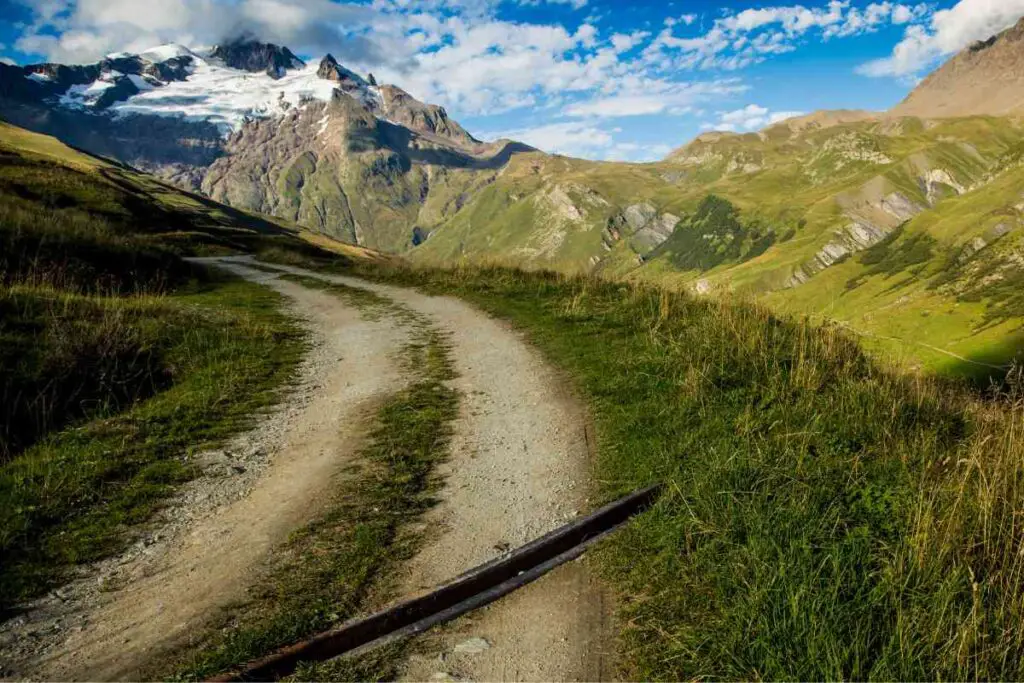
The loop is frequently featured in articles and lists titles as the ’10 Best Hiking Trails In The World,’ which is only fair given how spectacular the trail and its views are.
We’ll talk about the details of the trail later in this article, but expect breathtaking views, delectable food, and authentic mountainous adventures.
On just the first day, you’ll see massive snowy mountains, massive ice caps, majestic streams, and lush greenery.
Who Formed The Tour De Mont Blanc?
The trekking routes that comprise the tour du Mont Blanc loop, similar to the greatest treks in the world, were initially walked by shepherds who used to move their cows from one valley to the other.
However, it was a geologist from Switzerland who popularized this tour in the 18 th century.
The funny thing is that this “discovery” of his happened by accident as what he was trying to do was to figure out how to ascend Mont Blanc.
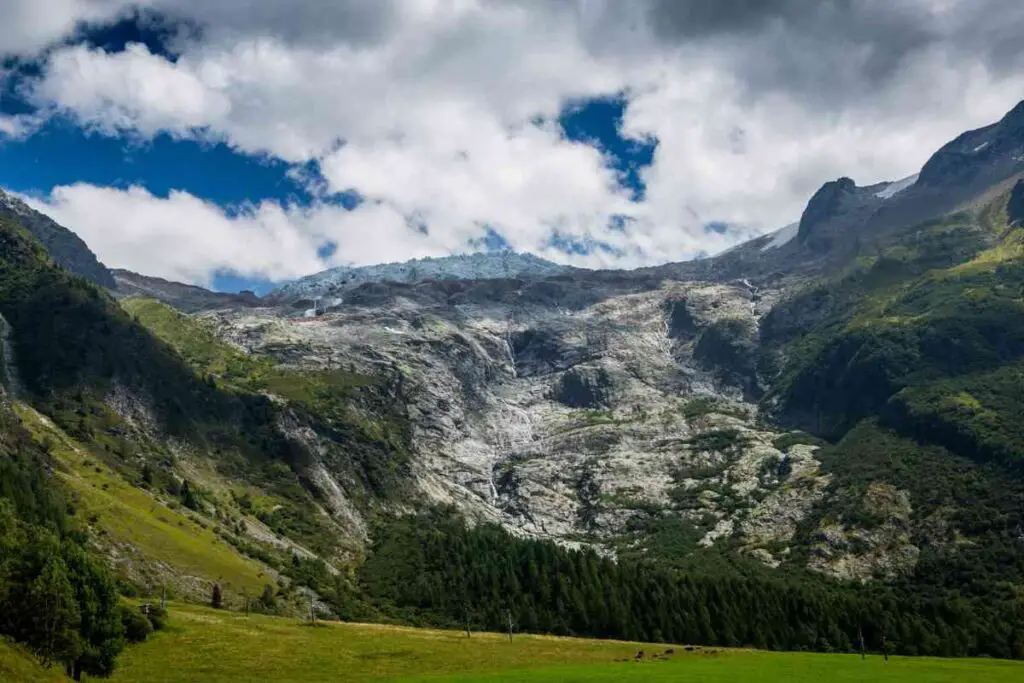
However, he ended up completing a circular trip around the entire mountain searching for the most suitable pathway, and thus was the first one (at least to our knowledge) to walk this trail.
The exact route the geologist followed is unconfirmed, but he went back to the mountain many times, desperately trying to reach the top.
Following several unsuccessful tries and circles around Mont Blanc, promised remuneration to whoever would reach the peak of the mountain.
It was in the late 1780s that two people from Chamonix were given the reward and managed to make the first climb.
He then was the third one to take the same path and reach the top of this famous European mountain.
Historically, Celtic tribal groups and the Roman army had used Col du Bonhomme, a spot located on the tour du Mont Blanc, as a route from which they moved their supplies through the Alpine areas.
Even today, you can discover the tattered remains of the Roman people and armies, with an old bridge built by their army remaining in good condition there, to many people’s surprise.
Where Is The Tour Du Mont Blanc?
TMB circumnavigates the mountain range, passing through Switzerland, Italy, as well as France.
Despite the fact that the trail does not reach the summit, everybody is familiar with Mont Blanc, and its name draws thousands of backpackers, hikers, and mountaineers each year.
How Long Is Tour Du Mont Blanc?
The Tour du Mont Blanc loop is a circuit that is 170 kilometers long and circles the Mont Blanc Mountain range.
Tour Du Mont Blanc Hike

Tour Du Mont Blanc Starting And Finishing Point
The Tour du Mont Blanc starts and finishes in Chamonix, an alpine town and adventure sports mecca on the French side of the Alps.
Despite its small size, Chamonix has always been overflowed with tourists and people looking for adventure thrills.
It is also a highly regarded ski retreat at the bottom of Mont Blanc, which means that there are many skiers and outdoor enthusiasts of all levels, as well as a booming mountaineering community and an abundance of trekking and mountain-bike paths to explore once the snow melts in the warmer months.
Chamonix is only 90 kilometers from the Geneva Airport and has numerous transportation choices available, rendering it a very accessible Alpine town.
The drive takes slightly more than an hour, bus services approximately 2 hours, and trains take closer to 3 hours, contingent on connections.
This town is also known as the World’s Capital of Adventure thanks to its busy rhythms, a plethora of fun activities, and simply stunning mountain ranges right next to it.
Tour Du Mont Blanc Route/Trail
The route follows a long loop of secluded pathways that circumnavigate the Mont Blanc massif in an anti-clockwise direction.
Of course, you have the option to follow the path in a clockwise direction, but the majority of people tend to go the other way around, and this is one of those cases where it’s preferable to go with the flow.
The trail is not challenging if you have prepared and trained right for it, but there are a lot of steep ascents.
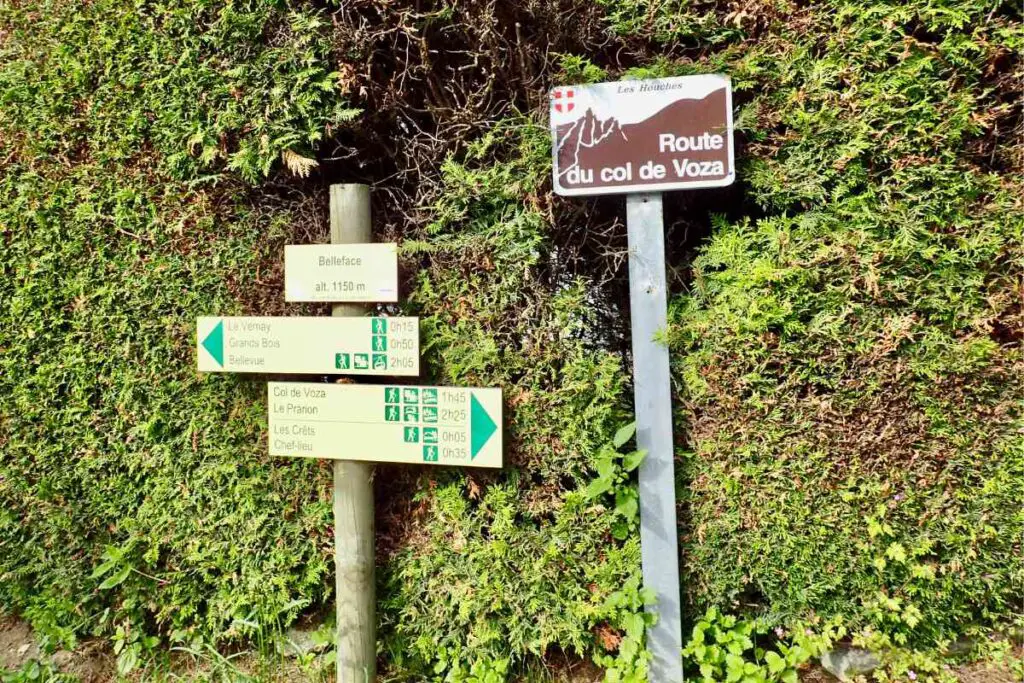
Nevertheless, there are also many variants and easier routes to take, so you can take paths that are slightly more demanding and then continue an easy downhill.
Moreover, the Tour du Mont Blanc trekking trail includes forest areas, desolate rugged terrain, and extensive green hillsides.
You’ll also be surrounded by the ultimate combination of majestic scenery and snow-covered highs above, with each day being unique.
However, if there’s one thing the majority of your tour days have in common, it is the fact that you will be following the same pattern of hiking across hilly areas, or mountain passes, before going down to a Refugio or hotel to rest.
Similarly, your days will begin with an enjoyable uphill walk to a picturesque point where you can enjoy your snack or meal while gazing at the scenery, and then continue with your final hike downhill for a hearty evening meal and some fresh beer.
Tour Du Mont Blanc Altitude
Mont Blanc, Western Europe’s highest mountain, is 4.808 meters above sea level, making its altitude one of the greatest and most challenging ones.
However, as we have previously mentioned the Tour De Mont Black does not involve ascending to its top.
In fact, the highest peak along the standard route is 2.537 meters above sea level, which is considerably lower than the top of the mountain.
This peak is at the Grand Col Ferret, which also serves as a frontier between Italy and Switzerland. Nevertheless, a few alternative routes can take you to the greatest heights.
So, for example, you also have the option of going higher up to enjoy the beautiful scenery from 2.665 meters above sea level. on the Col des Fours or Fenetre d’ Arpette,
Tour Du Mont Blanc Itinerary
Because of the long distance of the trail, most people complete the Tour du Mont Blanc route in 7 to 10 days.
Below you can find the itinerary for a 10-day hiking trip, and which is typically the one most people follow when doing the Tour du Mont Blanc for the first time!
10-Days Itinerary
Day 1: chamonix – les contamines.
On the first day, you’ll take the minibus to Les Houches and start your tour.
This first stage from Les Houches to Les Contamines is filled with lovely pine forest pathways, steep uphills and downhills, and areas of low trees and bushes carpeted with wild blueberry shrubs.

Nevertheless, you won’t be able to avoid the steep hills for the first hour, and if you choose to go from the variant, you can expect approximately 1500 meters of elevation, compared to the 650 meters of the standard route.
If you choose the challenging path, stop for lunch at the Refuge de Miage for some delicious and nourishing salad, and then continue your hike to Les Contamines for a night’s rest and more food.
Elevation Profile (Gain): 1500 meters of elevation gain for the variant, 650 meters of elevation gain for the standard route
Day 2: Les Contamines – Les Chapieux
After spending the night in a chalet, you’ll start the second day of the tour with an uphill trek up to the renowned Col du Bonhomme.
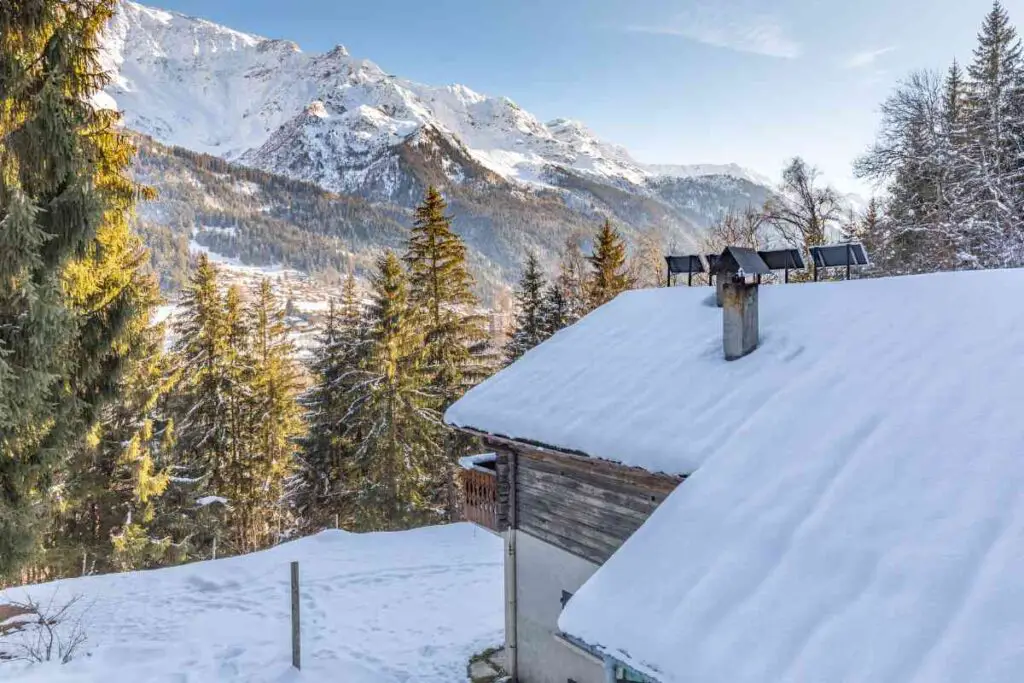
A few hours later towards the late afternoon, you’ll hike across the Croix de la Bonhomme and head straight to Les Chapieux.
This stage of the tour offers much better scenery and is less challenging, so you will certainly enjoy it more.
Les Chapieux is so small that it hardly qualifies as a town, but it’s quite lovely. There are a few guesthouses nearby. There also is a local products shop, where you must absolutely try their goat cheese!
Elevation Profile (Gain): 1300 meters of elevation gain
Day 3: Les Chapieux To Rifugio Monte Bianco
The third day will get you to Italy as you will be on the Col, which is approximately 1000 meters higher than the starting point.

The hike begins with a mild uphill through the valley, followed by several steep hills to the col’s summit. Although there is some altitude gain, this col is among the easiest ones to reach.
After you cross the col and until you reach Refugio Elisabetta it’s an enjoyable downhill. There you can spend some time enjoying some comfort food, and if you choose to stay the night, you’ll get a large dinner and an incredible view of the sunset.
Elevation Profile (Gain): 1000 meters of elevation gain
Day 4: Rifugio Monte Bianco – Courmayeur
This is undoubtedly the simplest hiking day.

An easy walk down the route to Courmayeur (that is nonetheless more than 4 hours long), a little town with many tourists, and you can have a nice break there, dine, enjoy a drink, and walk around the town.
Day 5: Courmayeur – Val Ferret
The fifth day begins with 800 meters of walking up a steep hill for approximately 2 hours, which is not that challenging.
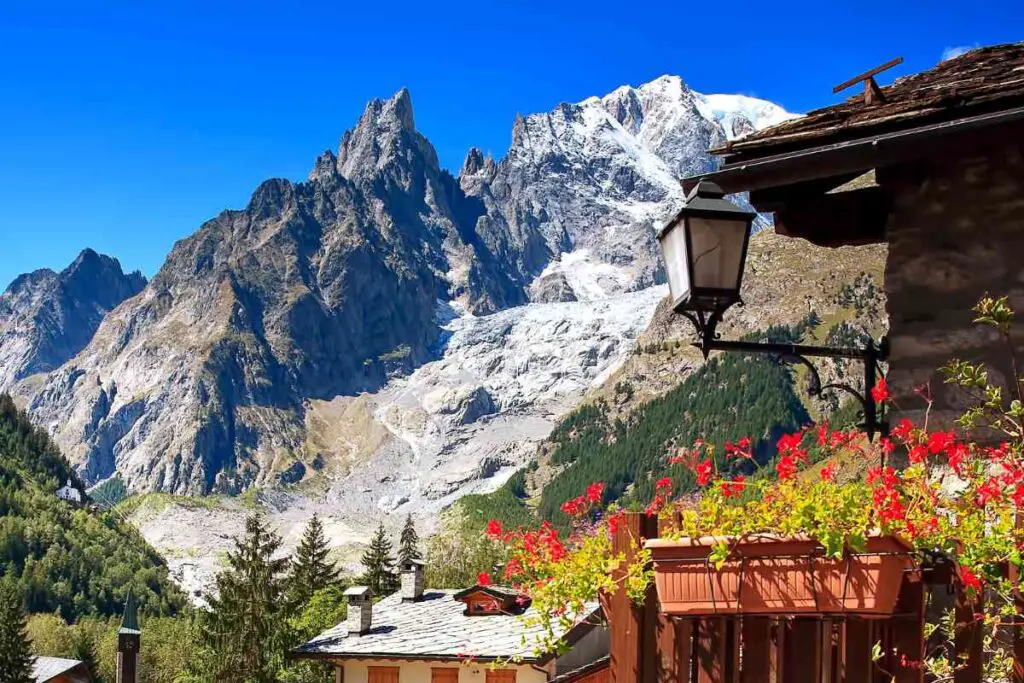
The hike from Courmayeur, at 1224 meters, to Refugio Bertone which is at 1996 meters, is mostly through a lovely forest area full of pine trees and it takes you along the Val Ferret, in between Italy and Switzerland.
When you get to the Refugio at the top, you can decide whether or not to complete the variant, which goes up 500 meters more and is 100% worth it.
Elevation Profile (Gain): 800 meters of elevation gain
Day 6: Val Ferret – La Fouly
On your sixth day, you’ll walk an easy 4-hour trail from Col Ferret to the little town of La Fouly, where you can try the delicious local cheese and other delicacies they offer.

An easier uphill walk all the way to a col will have you literally standing between France and Switzerland! As you descend, you’ll realize that the meal prices in the different Refugios skyrocket but spending some money on food there is worth it.
Day 7: La Fouly – Champex-Lac
This is a pleasant day with a hike through beautiful alpine grasslands and Swiss rural areas. You’ll finish your day in Champex-Lac, an idyllic Swiss settlement with a lovely lake where you can swim on a hot summer day!
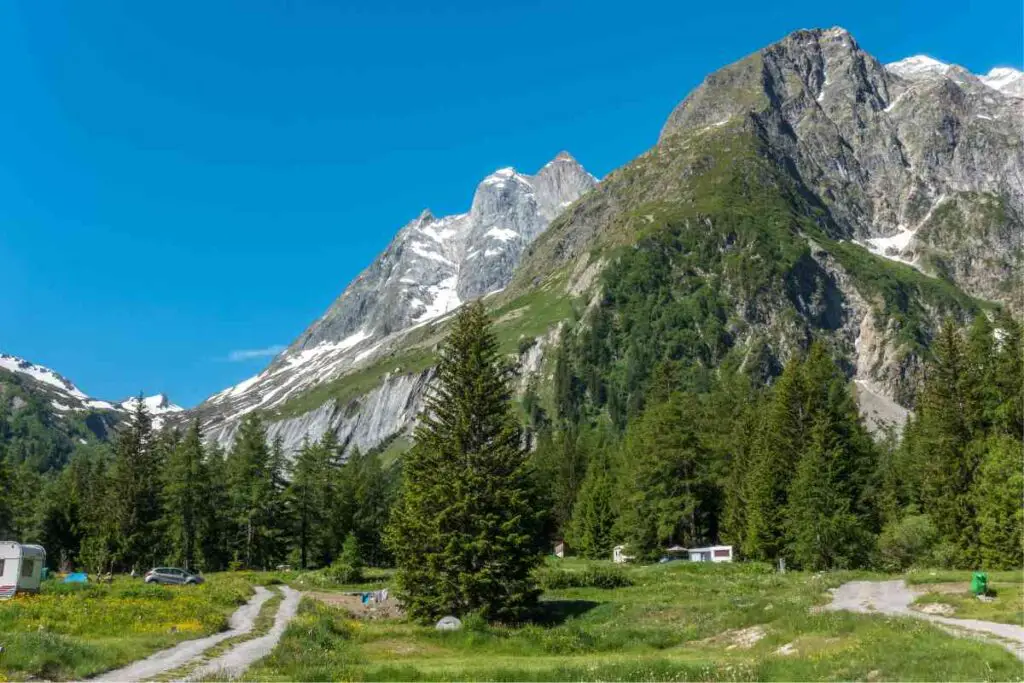
There are also many towns to stop in between, so despite the relatively short hike (in comparison to the 8-hour ones on other days), you need to take into account the hours you’ll spend exploring the towns.
Elevation Profile (Gain): 637 meters of elevation gain
Day 8: Champex-Lac – Trient
After a wonderful night in Champex, you can move on with your journey and begin the long but easy ascent to Bovine. From that point, you can descend to Trient via the Col de la Forclaz.
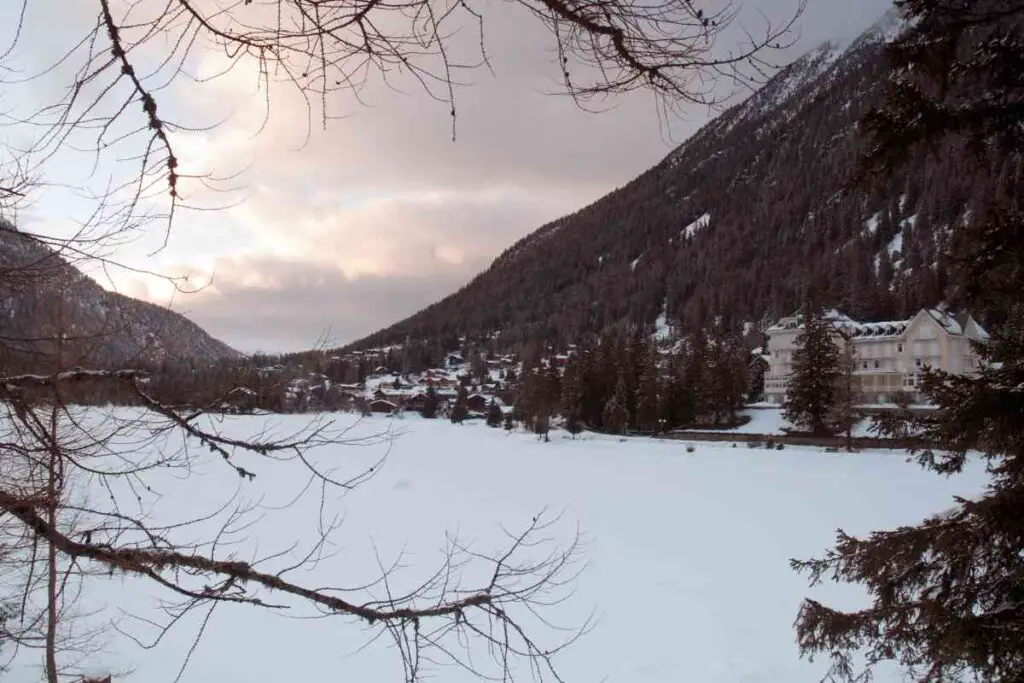
This day begins fairly flat before climbing approximately 1200 meters. The 1200-meter climb isn’t too difficult, and when you get to the top, there is also a cute spot to eat lunch and take in the views.
There are no grocery stores in Trient or La Peuty, so restock in Champex or enjoy your meals in any of the Refugios along the way.
Elevation Profile (Gain): 1200 meters of elevation gain
Day 9: Trient – Argentiere
The penultimate day starts early in the morning with an uphill trek up to Col de Balme, which offers Mont Blanc on a plate.

There’s also a variant that takes you up to Col des Possettes and the Aiguillette des Possettes peak that you can take, while the downhill to La Tour will mark the end of the hiking part of the day, leaving you time to relax and unwind.
Elevation Profile (Gain): 1180 meters of elevation gain
Day 10: Argentiere – Chamonix
The last day of your tour offers either the chance to ascend over Lac Blanc on some daring stairways or choose the standard and easier route.
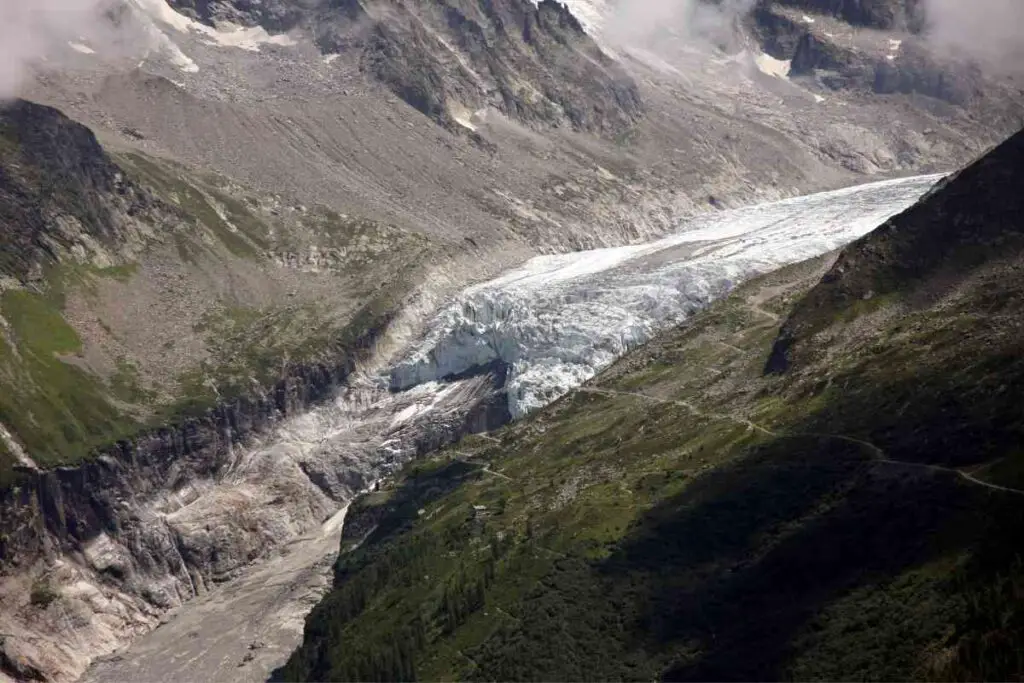
Some of the most breathtaking views are being enjoyed in this last stage of the trip, which will finish with a downhill walk with Chamonix as the final destination.
Elevation Profile (Gain): 1260 meters of elevation gain
Tour Du Mont Blanc Tour Options
There are both guided and self-guided tours you can join to complete the Tour du Mont Blanc, and depending on what you choose to do, the costs will be different.
Here are some examples of guided and self-guided tours offered:
- Macs Adventure Tour
- Tour Du Mont Blanc Holiday
- Alpine Treks
- Wildland Trekking Tour
Tour Du Mont Blanc Map
Mont Blanc Treks offer several maps such as those of the easterly and westerly circuits as well as one of the full circuits around Mont Blanc, and a chart of the elevation profile of the tour.
Tour Du Mont Blanc Packing List
If you are planning on camping throughout the tour, you need to make sure you are packing as light as possible as you will be carrying the extra camping equipment with you which includes a tent and a sleeping bag , as well as a sleeping pad.

The rest of the things you need to carry are:
- Water bottle
- Clothes: fleece or sweater (depending on the weather), extra socks and underwear, shirts and shorts, and long trousers.
- Accessories: bandanas, caps, headlamp
- Microfiber towel
- Power adapter
- First-aid kit
- Passport and/or ID
When To Hike the Tour Du Mont Blanc?
The best time of the year to walk the tour du Mont Blanc is in the summertime when the climate is softer, the sun is up, and all ice has melted.
Given its high altitude and Alpine winters, going there in the summer can guarantee you a good night’s sleep when you choose to camp for the night as well as warmer weather for your hike.
Training For Tour Du Mont Blanc
Depending on which path you take, you should train and get ready for a little more or a little less strain on your legs and work accordingly on your cardio fitness level.
Read next – Is hiking good cardio?
No matter how many variants you choose to hike and how fast or slow you choose to go, you need a great fitness level, so you either have to train consistently for months, even years, before embarking on your journey, or be very athletic and fit.
Previous experience with long-distance hikes will also make this trip easier, but this does not mean you won’t need to prepare for it just because you hiked coast to coast in the UK years ago!
Tour Du Mont Blanc Accommodation
A common question and topic of discussion among hikers to-be of the Tour du Mont Blanc is that concerning the lodging options.
To begin with, there are numerous places to spend the night. If you have a lot of money, you have a plethora of choices.
However, if you’d like to complete your journey without breaking the bank, you can either choose camping or stay in one of the many refugios or guesthouses.
- Find the most affordable places to stay at booking.com
Tour Du Mont Blanc Refuges
A Refugio is a refuge, also called a mountain hut. It is basically a mountain hostel with simple interior decoration and amazing food!
Many Refugios offer private rooms, however, some of them only provide shared hostel-style lodging.
Tour Du Mont Blanc Camping
You also have the option of setting up camp every night. Clearly, it will be the most cost-effective option, but it is also one that allows you to experience this adventure in the best way possible, as it kind of completes the overall experience.
Furthermore, you won’t have to worry about making any reservations, as you can simply arrive at the campground and find a spot to set up your tent.
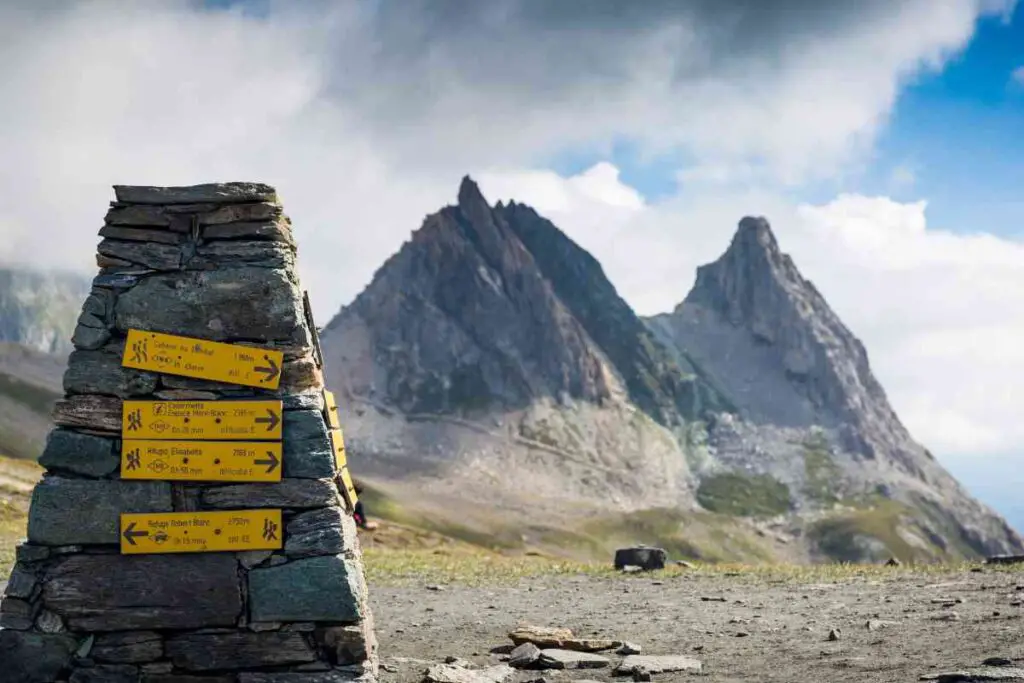
There are numerous ways to organize your trip, in addition to the several accommodation alternatives.
Many people prefer to schedule and plan things on their own, including booking their own accommodation and transporting all their belongings, but sometimes it is better to have some assistance.
During the peak tourist season, which is in July and August, it is preferable to let somebody else book your accommodation and luggage transfers.
Even so, keep in mind that if you choose to stay in accommodations rather than go camping, that means you’ll have to pay in advance and do your best to stay committed to the planned itinerary.
Any delay or injury incident might mean you can lose a night’s stay and, hence, money spent on a room you won’t stay in after all.
On the other hand, if you do the hike off-peak season, you can always make a same-day booking as it is always available in most hotels and guesthouses.
Either way, this website of the Tour De Mont Blanc is very useful for planning your stay throughout the tour.
You can select your intended destination and a precise date, and it will display a list of accommodation options you can stay in, which would include the walking distance from one to the other.
The Bottom Line
The Tour du Mont Blanc is without a doubt an epic multi-day hike on this planet and experiencing this journey is something you will remember forever.
The good thing is that you can always visit this destination again and if you go there on a guided tour the first time, challenge yourself by going on a self-guided tour the next one!
Leave a Reply Cancel reply
Your email address will not be published.
Save my name, email, and website in this browser for the next time I comment.
Latest from Blog

Will Snakes Cross a Rope? Debunking Common Myths
Yes, some snakes can cross ropes, especially if they’re good climbers and the rope provides enough

What to Do if You See a Deer While Hiking: Safe Wildlife Encounters
If you spot a deer while on a trail, the first step is to maintain a

Are Timberlands Good for Hiking? Evaluating Durability and Comfort
While fashion-forward individuals often sport Timberlands in urban settings, a question looms for outdoor enthusiasts: Are

How to Get Better at Hiking Uphill: Techniques for Mastery
Mastering the art of uphill hiking can transform your outdoor experiences, offering not only breathtaking views

Is Hiking Aerobic or Anaerobic: Understanding the Exercise Classification
Often, hiking is primarily an aerobic activity, especially when you engage in it over an extended
Privacy Policy
- Mont Blanc Tunnel closed from 2 Sept to 16 Dec 2024
- Skier 25, dies on Aiguille Verte after 500 meter fall
- Magic Mont-Blanc, from Thursday 11 to Sunday 14 April 2024
- In Chamonix, which ski resorts are open for spring skiing?
- Refuge Grands Mulets opens 4 April 2024 and conditions for ski ascent of Mont Blanc
At the foot of Mont Blanc (4808m or 15,770ft), the highest mountain in western Europe, Chamonix's alpine town atmosphere

The resort of Chamonix has three 5 star hotels, eleven 4 star hotels, twenty two 3 star hotels, thirteen 2 star hotels

TransferFix, we help you find your Chamonix transfer

Opening Dates 2024

Since 1934, Snell Sports has been the largest mountain shop in the Chamonix Valley.

Compare & Book Online with Chamonix.net
Tour du mont blanc hiking - routes, maps and itineraries.
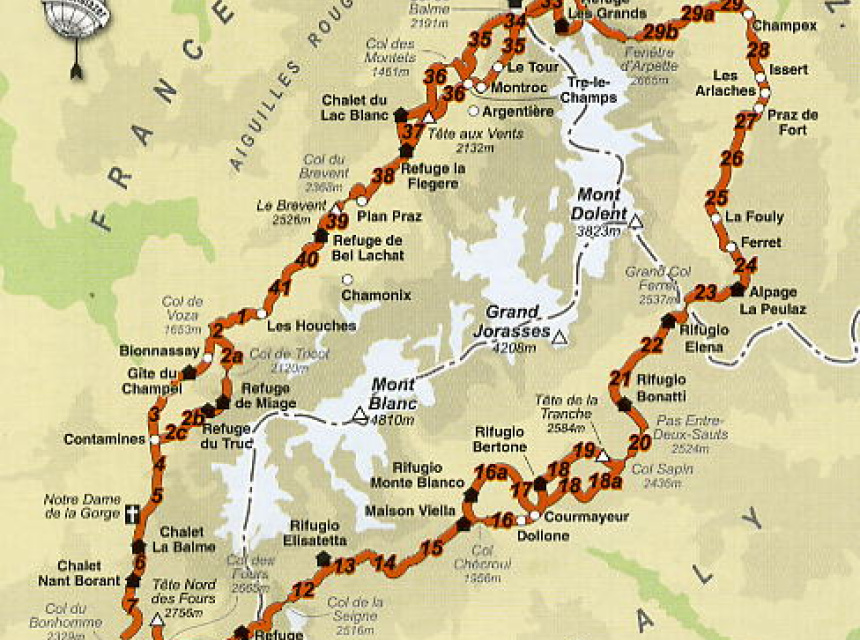
The Tour du Mont Blanc is a 170 km trek that encompasses the whole of the Mont Blanc Massif; with nearly 10 000m of cumulative descent and ascent it is usually completed in a number of days.
The TMB has a variety of accommodations along its way (hotels and mountain huts with possibility for vehicle support) that allow you to really enjoy the scenery, take lots of photos and walk each day with just a light pack.
Alternatively, the TMB can be done completely self-sufficiently: you carry all your own food and camping gear. This gives you a better sense of freedom and the ability to go where you please whenever you want.
Tour of Mont Blanc General Information
Mont Blanc Tour mountain huts are open, in general, from mid-June until the first or second week in September. It is advisable to reserve a bed, particularly in the high season of mid July to mid August.
Early in the season is the quietest and most beautiful, but beware of old snow on the higher paths which could be icy and dangerous and would make an ice axe essential.
For additional safety or to just show you the way you could hire an Independent Trek Leader .
Wildlife on the Tour du Mont Blanc
Have a look at the Chamonix.net nature, faune and flora page for more information on wildlife you might encounter on the Tour of Mont Blanc. Chamois, deer, eagles and a range of beautiful alpine flowers can all be seen and photographed.
Tour du Mont Blanc Maps, Kit List and Equipment
Lightweight boots and shorts are sufficient as long as there are warm clothes in your backpack. Waterproofs are essential and trekking poles useful. Here are some of the best mountain equipment shops in Chamonix .
Do not forget sunglasses, skin and lip protection. Always carry drinking water and check the Chamonix weather forecast before starting your journey.
Maps for the Tour of Mont Blanc:
Tour of Mont Blanc - Route Descriptions
You have plenty of options: from 4 day sportive hikes to leisurely 12 day cultural experiences; there is not only one way to do the Tour of Mont Blanc. Here are a couple of different suggestions which may help you make up your mind on your particular style.
- You can go on your own with your own GPS track (book here online) , or benefit from a mountain leaders ' experience
- You can carry your own gear or hike with a light pack with vehicle support (book here online)
- You can sleep and eat in the refuges or carry a tent (book here online)
Here is a list of contact information for the various mountain huts .
4 day trip: Not quite racing - but fast enough: For the hardcore hiker
This itinerary follows pretty much in the footsteps of the Ultra Trail race (which varies slightly from year to year). This is for very fit hikers and is done with only a light day pack, eating and sleeping in huts and is basically the run/walking version of the Tour du Mont Blanc. The times noted are for fit spandex-wearing (not obligatory!) hikers.
7 day trip: Hiking the Tour of Mont Blanc - hiker
Start with the previously mentioned itinerary and break up the days a bit depending on where you would like to spend the night.
For people who carry their own gear, plan on a 7 day trip.
9 to 11 day trip: Taking the time to look at the scenery
Of course if you really do have time, you can expand the experience. Here's an example of a slower pace, with time to veer a little off the path. This is described as an 11 day trip, but it would be really easy to knock off the first and last days as those days are dedicated to trekking in the Chamonix Valley.

At the end of August, each year, the trails around the Mont Blanc get really busy for one of the most amazing competitions ever organized - The Ultra Trail du Mont Blanc - so keep this in mind when planning your hike of the Tour du Mont Blanc.
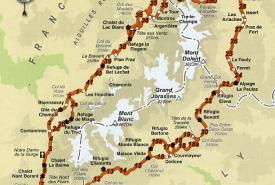
Social Networks

Latest News


- Trip Finder
- Newsletter Signup
- Request a call
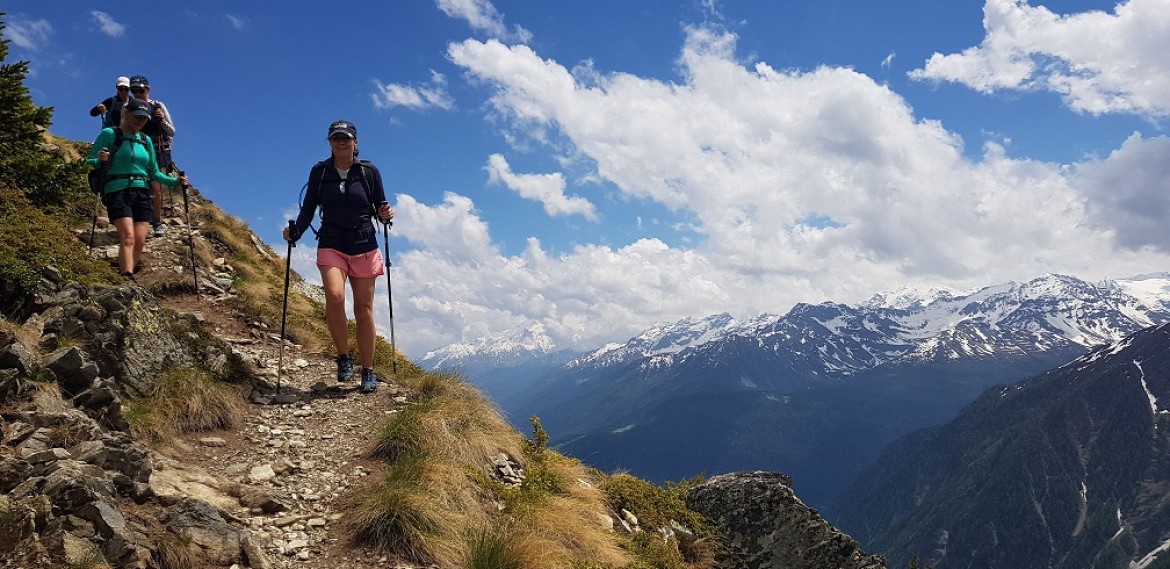
Tour du Mont Blanc - Deluxe, Guided Edition
Europe's most popular trek. Without huts, with luggage transfers and expert guides
Down from Mont Chetif along the Tour du Mont Blanc trail.
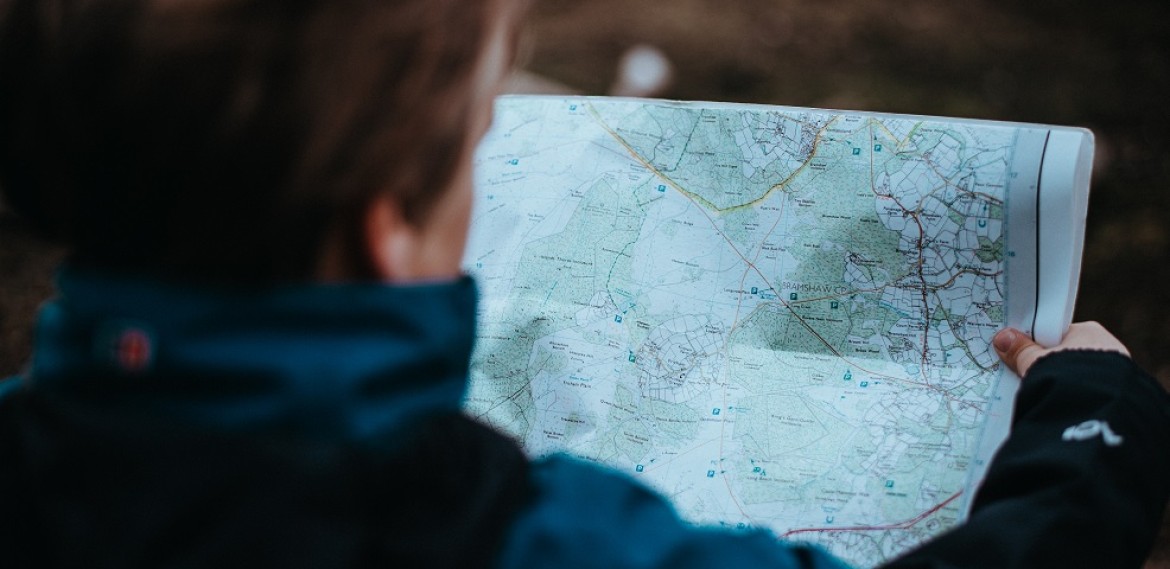
Self-Guided Tour du Mont Blanc
Self-Guided Trekking for the Independent Traveler
Photo by Annie Spratt
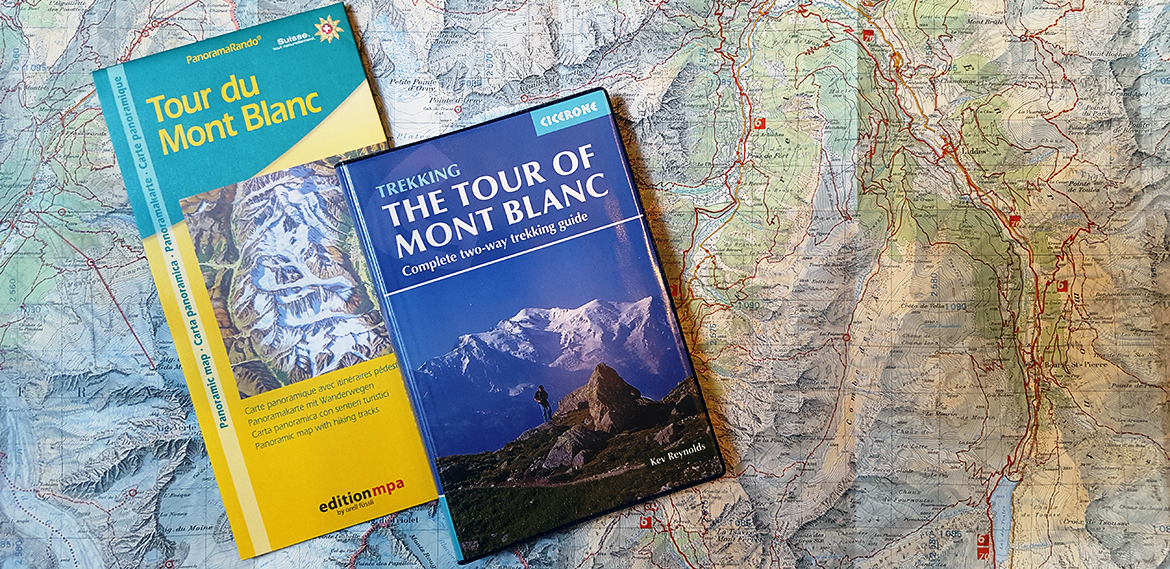
Maps, Books, and Gear
Go prepared with everything you need for a perfect trek
Some of the available maps and books on the Tour du Mont Blanc. Photo by Alpenwild

Tour du Mont Blanc Trekking
Guided and self-guided alpenwild tour options.
Hike and Trek around Mont Blanc, which rises over 15,770 feet (4,808 meters) above sea level, and is the snow-capped queen of the Alps. Its flanks, glaciers, and deep valleys straddle three countries—France, Italy, and Switzerland. Hiking the Tour du Mont Blanc is the trip of a lifetime. As you circle the base of Mont Blanc you’ll experience the immense snowfields, hanging glaciers, wild-flowered meadows, and dense forests that decorate its walls. More than just a single peak, the Mont Blanc Range, which we compass, contains ten other major summits—each over 4,000 meters high. And with all that elevation you’ll find abundant glaciers, including the Mer de Glace and the Miage Glacier—the longest glaciers in France and Italy, respectively.
A classic Alps adventure awaits as you join one our guided or self-guided Deluxe Tour du Mont Blanc treks.
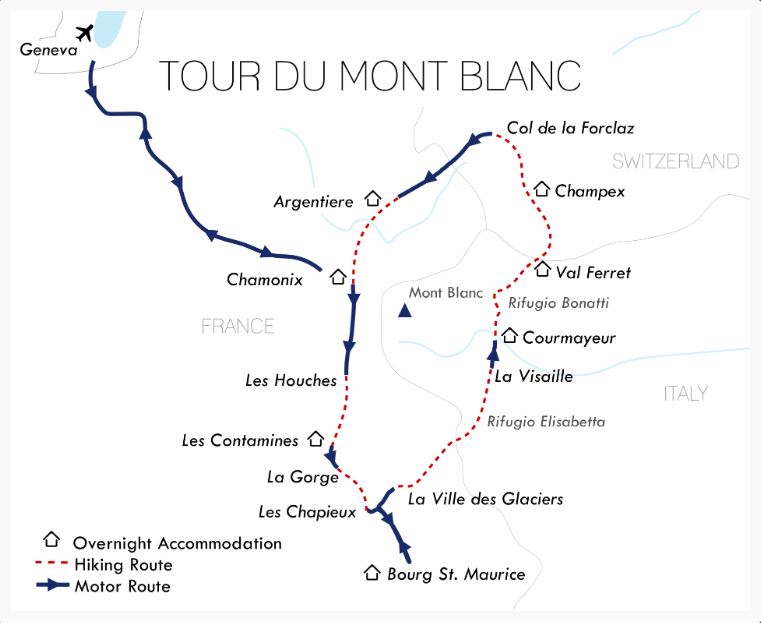
Starting in Chamonix, France, the 12 days and 11 night Deluxe Tour du Mont Blanc Alpenwild trek includes:
- Handpicked inns and hotels (no huts)
- Luggage transfers
- Experienced and qualified guide
- Incredible meals
- Transportation to and from the airport and during the tour
- Les Hauches cable car
- Bioonassay suspension bridge
- Visit the 15th century baroque chapel of Notre Dame de la Gorge
- Courmayer rest day
- Skyway Monte Bianco – cable car
- Courmayer nature gardens
What are you waiting for? Come join us on the Tour du Mont Blanc this summer!
Do you have any questions or concerns? Talk with an expert (who has actually done the tour) email [email protected] or call 801-226-9026.
Tour du Mont Blanc: A Trek of a Lifetime
With nothing to do but book flights and get in shape for this classic trek, prepare to have the adventure of a lifetime. At Alpenwild, we are Tour du Mont Blanc tour experts. You will thoroughly enjoy the trails, accommodations, meals and comradery along the trail.
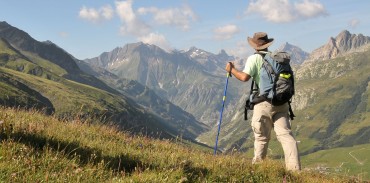

Tour du Mont Blanc Overview
Let’s start planning your Tour du Mont Blanc hike with the basics. Where. When. How.
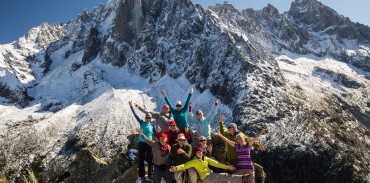
A Mont Blanc Trek Above the Rest
Discover what features make Alpenwild's Tour du Mont Blanc stand out from the rest.
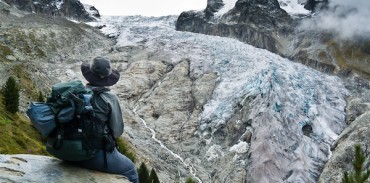
Trek Packing List
We've been there, done that and share our packing list so you can go there, without forgetting that.
The Perfect Way to See the Alps
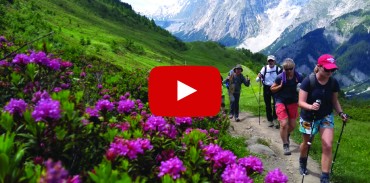
Tour du Mont Blanc
Be a part of the Tour du Mont Blanc for just 4 minutes in this new Alpenwild video
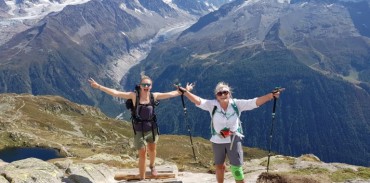
Guides and Trip Leaders
Alpenwild guides are the best in the Alps. Meet them. Read their stories. See what our guests say about them.
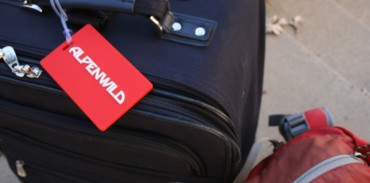
Luggage Transfers and Shuttles
Hike light and enjoy the trek. Luggage transfers make all the difference
The Tour du Mont Blanc is a classic inn-to-inn alpine trek—one which Alpenwild has refined with many creature comforts, exquisite cuisine, and superb accommodations. As you trek the Tour du Mont Blanc, you’ll experience the culture, the rich history of the Alps along with the stories of how this massive mountain has beckoned hikers and mountaineers for over 250 years. Our 12-day guided trip sets a new standard, and on our self-guided treks you can adjust the itinerary to perfectly suit your skills and interests.

See our Privacy Policy.
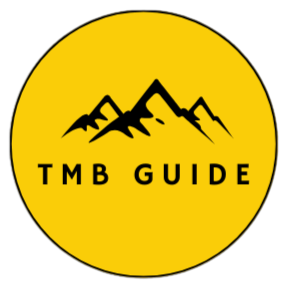
Tour du Mont Blanc in 7 Days: Map, Stages & Accommodations
The Tour du Mont Blanc is an epic hiking experience that takes you through three countries – France, Italy, and Switzerland – in an intense week. This adventure invites you to measure yourself against the majesty of the Alps, crossing mountain passes such as the Col du Brévent, the Col de la Seigne, and the Col des Fours, while admiring the grand landscapes of Mont Blanc.
The route offers exceptional flexibility, allowing hikers to adjust the difficulty of their journey by varying the number of days. A seven-day tour represents a considerable challenge, with some long and strenuous stages, but offers unmatched rewards in terms of satisfaction and breathtaking panoramas. For those who prefer a gentler adventure, a ten-day tour provides a more relaxed alternative.
Accommodation along the route is varied and abundant, with a wide choice ranging from comfortable hotels to quaint gîtes, traditional mountain refuges , and even bivouac sites for the more adventurous. Prepare for total immersion in the wild splendor of the Alps, facing the vastness of Mont Blanc.
Day 1 (Option 1): Les Houches – Refuge de la Balme
Download the GPX track of the stage: https://www.visugpx.com/mSlFmJ4Qro
Elevation gain, altitude, and mileage of the stage

Elevation +

Elevation –

Max. Altitude

Min. Altitude
Stage Summary:
The first stage of the Tour du Mont Blanc is a 25-kilometer adventure that starts at Les Houches and ends at the Refuge de la Balme. After about 2h30 of walking from Les Houches, you will reach the Col de Voza, an initial challenge that will get you into the swing of things with about 660 meters of positive elevation gain over a distance of 6 to 7 kilometers, depending on your starting point. This first part of the route offers an impressive introduction to the beauty of the Alps and a first leg-stretcher for the rest of the tour.
After the Col de Voza, you will descend about 11 kilometers, with a negative elevation change of around 800 meters, to arrive in Les Contamines. This charming town is an ideal place to take a break, refresh with a local beer, and even spend the night if you prefer not to continue to the Refuge de la Balme. For those who choose to continue, there are still about 7 kilometers and 550 meters of positive elevation gain to reach the Refuge de la Balme. There, you can choose to sleep in the comfort of the refuge or experience a more rustic stay at the bivouac area.
Points of Interest for the Stage
Col de Voza
Where to Sleep?
Refuge de la Balme Bivouac area of Refuge de la Balme Possible to stop earlier in Les Contamines (camping or hotel)
Day 1 (option 2): Les Houches – Refuge de la Balme via the Col de Tricot variant
Download the GPX track of the stage: https://www.visugpx.com/rFQWJMXPXN
Summary of the Stage
The first stage of the Tour du Mont Blanc offers an exciting variant that goes through the Col du Tricot, adding an extra dimension to this alpine adventure. The first part of the stage remains the same as the classic route, with a walk of about 2h30 from Les Houches to the Col de Voza. This section of the route includes about 660 meters of positive elevation gain over a distance of 6 to 7 kilometers, depending on your starting point.
Once at the Col de Voza, you will have the choice of staying on the classic route or taking the variant via the Col du Tricot. If you choose the latter, you should prepare for about 600 meters of additional positive elevation gain over a distance of 6 kilometers to reach the Col du Tricot. This variant offers a more demanding hiking experience, but also more rewarding, with spectacular panoramic views of the Alps.
From the Col du Tricot, you have several options for the rest of your day. You can continue to the Refuge de la Balme to spend the night, offering a longer but also more rewarding end to the day. Alternatively, you can turn towards Les Contamines to shorten your day and spend the night there.
Col de Voza Col de tricot at 2120m
Day 2 (option 1): Refuge de la Balme > Chapieux > Les Mottets
Download the GPX track for the stage: https://www.visugpx.com/pubLJ5t1su
The second stage of the Tour du Mont Blanc begins at the Refuge de la Balme and ends at the Refuge des Mottets. It follows the classic route of the tour.
The departure from the Refuge de la Balme leads to a climb of 650 meters of elevation gain over a distance of 4 kilometers to reach the Col du Bonhomme. Once at the pass, you will continue on the classic route of the tour, without taking the variant via the Col des Fours.
After the Col de la Croix du Bonhomme, you will begin a descent of 4 kilometers with a negative elevation change of 800 meters to arrive at Chapieux. From there, you will continue calmly for about 6 kilometers to the Refuge des Mottets. Along the way, you can stop at the Ville des Glaciers, where it’s possible to stop at the alpine pasture to stock up on local cheese, a true delicacy of the region.
Once arrived at the Refuge des Mottets, you will have completed this stage of the tour. This is your last stop before crossing into Italy the next day. It is recommended to book in advance if you plan to sleep in the refuge. It is important to note that it is forbidden to bivouac on the refuge property, which is quite large. However, you can pitch your tents before the refuge at the level of the ruins (about 5/10 minutes before the refuge) or after starting the ascent towards the Col de la Seigne, just behind the first “peak” that is visible from the refuge.
Col du bonhomme Col de la croix du bonhomme
Refuge des Mottets Bivouac before the Refuge des Mottets at the level of the ruins. Set up your tents quickly as it fills up very fast. Bivouac after the Refuge des Mottets (directly after the first ascent towards the Col de la Seigne)
Day 2 (option 2): Refuge de la Balme > Col des Fours > Les Mottets
Download the GPX track for the stage: https://www.visugpx.com/URWmZQHWLG
The beginning of the stage is the same as the classic route, starting from the Refuge de la Balme and ascending 650 meters of elevation gain over 4 kilometers to reach the Col du Bonhomme.
Continuing towards the Col de la Croix du Bonhomme, you will then choose the variant that leads to the Col des Fours. This variant takes you to an altitude of 2665 meters, offering spectacular views of the surrounding mountains. Before embarking on this variant, it is essential to check the weather and the trail conditions in advance. Depending on the season, there can be a lot of snowfields, making some passages dangerous even in summer.
Once at the Col des Fours, you will begin a descent of 5 kilometers with a negative elevation change of 900 meters to arrive at the Ville des Glaciers. You can stop at the alpine pasture to stock up on local cheese, a true delicacy of the region, before continuing to the Refuge des Mottets.
The Refuge des Mottets is your last stop before crossing into Italy the next day. It is recommended to book in advance if you plan to sleep in the refuge. It is important to note that it is forbidden to bivouac on the refuge property, which is quite large. However, you can pitch your tents before the refuge at the level of the ruins (about 5/10 minutes before the refuge) or after starting the ascent towards the Col de la Seigne, just behind the first “peak” that is visible from the refuge.
Day 3: Les Mottets > Courmayeur
Download the GPX track for the stage: https://www.visugpx.com/Twvax7D6iA
The third stage of the Tour du Mont Blanc will take you from France to Italy, crossing spectacular alpine landscapes. The stage begins at the Refuge des Mottets, and after only 4 kilometers and about 600 meters of positive elevation gain, you will reach the Col de la Seigne. This pass, perfect for waking up, marks your entry into Italy and offers breathtaking panoramic views of the surrounding mountains.
After the Col de la Seigne, you will continue for about 9 to 10 kilometers through the beautiful Italian valley. This part of the route takes you through varied landscapes, including the picturesque Lake Combal and several mountain refuges. Each step of this stage offers a new view of the Alps, with constantly changing panoramas and opportunities for memorable photos.
Finally, you will begin a descent of 11 kilometers with a negative elevation change of 1260 meters to arrive in Courmayeur. This Italian town is a welcome resting place after this long stage. Courmayeur is full of hotels, perfect for recharging and preparing for the next stage of your adventure. Whether you choose to relax in a spa, taste local Italian cuisine, or simply rest, Courmayeur offers a perfect end to the day for this third stage of the Tour du Mont Blanc.
Col de la Seigne Lake Combal
Hotels in Courmayeur
Campings outside Courmayeur
Day 4: Courmayeur > Refuge Elena
Download the GPX track for the stage: https://www.visugpx.com/B3MhnslfBa
The fourth stage of the Tour du Mont Blanc is a day that offers a mix of challenges and relaxation. Your day begins with a climb of about 800 meters of positive elevation gain over a distance of 4 to 5 kilometers, depending on your starting point. This initial climb is an excellent way to wake up and prepare for the day ahead.
Once this climb is completed, the rest of the day is relatively “quiet” compared to other stages. You will continue for about 12 kilometers, with 330 meters of positive elevation and 600 meters of negative elevation. This part of the route takes you through the beautiful Italian valley, offering spectacular views and a relaxing hiking experience.
Before arriving at the Refuge Elena, you will have about 2 kilometers and about 300 meters of positive elevation gain left. This last climb is a final challenge before ending the day. The Refuge Elena is a popular place to spend the night, offering spectacular views of the surrounding mountains.
It is important to note that you will need to book in advance to sleep at the Refuge Elena, as it fills up quickly and there are not many sleeping options in the vicinity. In Italy, bivouacking is prohibited below 2500 meters in altitude, so it is essential to plan ahead. This fourth stage of the Tour du Mont Blanc offers a balanced hiking experience, with physical challenges, beautiful landscapes, and moments of relaxation.
Italian Valley
Where to sleep?
Refuge Elena
Day 5: Refuge Elena > Champex
Download the GPX track for the stage: https://www.visugpx.com/v4RKRYwRg3
The fifth stage of the Tour du Mont Blanc, from the Refuge Elena to Champex-Lac, is a hiking day that offers both challenges and moments of relaxation. Although this stage is quite long and some parts may not be the most attractive of the tour, it nevertheless provides a rewarding hiking experience.
The day begins with a beautiful climb of about 500 meters of positive elevation over 2 kilometers to reach the Grand Col Ferret. This ascent marks your crossing into Switzerland, a moment to celebrate, but also to consider for your phone’s internet data, as Switzerland may not be included in your European plan depending on the operator.
From the Grand Col Ferret, a descent of about 20 kilometers and 1600 meters of negative elevation awaits you. This descent brings you closer to Champex-Lac, your destination for the night. It’s worth noting that part of this stage can be done by bus by taking the shuttle at Ferret or La Fouly, which can be an attractive option for those wishing to save some energy.
You then have 6 kilometers and 600 meters of positive elevation remaining to reach the Relais de l’Arpette, where you will spend the night. It is also possible to sleep at the Camping des Rocailles in Champex, which is located about 45 minutes before the Relais de l’Arpette.
Grand Col Ferret (Italy/Switzerland border) Option to take the shuttle at Ferret to Champex and avoid walking for 4 hours Supermarket in La Fouly to restock if needed
Relais de l’Arpette Camping des rocailles (in Champex)
Day 6 (option 1): Champex > Col de Balme (via La Forclaz) > Tré le Champs.
Download the GPX track for the stage: https://www.visugpx.com/f8P8nDc8xt
The sixth stage of the Tour du Mont Blanc, from Champex to Tré le Champ, is a quite hard hiking day even without taking the variant via the Fenêtre d’Arpette. This stage also marks your return to France.
Your day begins with a climb towards the Col de la Forclaz, followed by another ascent to the Col de la Balme. The Col de la Balme is a highlight of this stage, offering spectacular views of the surrounding mountains. The refuge here is a beautiful place to take a break and enjoy the scenery. The passage at the Col de la Balme also marks the border with France, another significant milestone of your journey.
After enjoying the Col de la Balme and a drink at the refuge, you will begin a descent of about 6 kilometers with 700 meters of negative elevation to reach Tré le Champ and the Auberge de la Boerne. This descent offers another opportunity to enjoy the alpine landscapes while approaching your destination for the night.
It’s important to note that you need to book your night at the Auberge de la Boerne in advance, as it fills up quickly. The bivouac area is not the largest, so it’s advised to set up your tents quickly. Once settled, you can enjoy a wonderful meal at the inn and take advantage of the showers if you wish.
Col de la Forclaz Col de la Balme
Auberge de la Boerne (hostel) Auberge de la Boerne (camping)
Day 6 (option 2): Champex > Col de Balme (via Fenêtre d’Arpette) > Tré le Champs
Download the GPX track for the stage: https://www.visugpx.com/iIoAINv20C
The sixth stage of the Tour du Mont Blanc, from Champex to Tré le Champ with the variant via the Fenêtre d’Arpette, is considered one of the hardest of the Tour, but also one of the most beautiful and rewarding.
Starting from Champex, you’ll begin a climb over 6 kilometers with an elevation gain of 1100 meters. This ascent is a challenge in itself, with some complicated passages to reach the Fenêtre d’Arpette, and the trail can be difficult to follow. It’s essential to be cautious on the way, check the weather and trail conditions beforehand carefully. Some passages may still be snow-covered and dangerous if the weather is not favorable.
Once you reach the Fenêtre, take the time to rest and savor your accomplishment. You then have a descent of about 4 kilometers with 1000 meters of negative elevation before arriving at the Chalet des Glaciers. Here, you can reward yourself with a cheese crust and a good beer.
After a well-deserved break, you’ll embark on another ascent to the Col de la Balme, about 2 kilometers with approximately 600 meters of elevation gain. The view and refuge here are magnificent, and it’s recommended to make the most of it.
Finally, you have “only” 6 kilometers and 800 meters of negative elevation to reach Tré le Champ. As always, make sure to book your night in advance, whether in a refuge or bivouac, as these places fill up quickly. The bivouac area is not the largest, so it’s advised to set up your tents quickly. Once settled, you can enjoy a wonderful meal at the inn and take advantage of the showers if you wish. This stage of the Tour du Mont Blanc offers an unforgettable hiking experience, with physical challenges, breathtaking views, and well-deserved moments of relaxation.
Fenêtre d’Arpette Col de la Balme
Day 7: Tré le Champs > Les Houches
Download the GPX track for the stage: https://www.visugpx.com/3kIaPa8PzP
Congratulations! You’ve reached the seventh and final stage of the Tour du Mont Blanc, from Tré le Champ to Les Houches. It’s a flexible day, adaptable to your needs and desires, whether in terms of accommodation, transport, or difficulty level.
If you choose to descend to Les Houches, prepare for a full day. However, many “exits” are available along the way, allowing you to adjust your day according to your physical condition and desires.
You have the option to take the cable car from La Flégère to Chamonix, offering a quick descent and a stunning view of the valley. Another option is to take the cable car from Brévent to Chamonix, another way to enjoy the view without the effort of descending.
If you feel up to it, you can also choose to walk down to Chamonix before the ascent of Brévent. This option allows you to fully enjoy the natural beauty of the route, while offering one last physical challenge.
During this day, you will pass through the Aiguillette d’Argentière and its ladders, as well as the Col du Brévent. Both points offer spectacular views and are highlights of this final stage.
Whichever option you choose, this last stage of the Tour du Mont Blanc is an opportunity to celebrate your achievements, enjoy the last beautiful views, and finish your adventure in style.
Aiguillette d’Argentière Col du Brévent
Les Houches Chamonix Option to take the cable car from La Flégère to Chamonix Option to take the cable car from Brévent to Chamonix Option to walk down to Chamonix before the ascent of Brévent (expect 1h30 to 2h of steep descent)
Submit a Comment
Your email address will not be published. Required fields are marked *
Please enter an answer in digits: eight − 3 =
Submit Comment
- Follow Follow
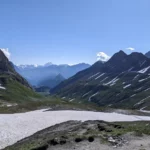
This article was written by Hugo, a hiking enthusiast and co-creator of TMB-Guide.com. This site is your gateway to your adventure on the Tour du Mont Blanc. We strive to share as much information as possible about the Tour to help hikers prepare for their trips.

Planning for the Tour du Mont Blanc
After reading this Trek article almost two years ago, I put the Tour du Mont Blanc on my bucket list and mostly forgot about it. Until this past November, when I started longing for warmer weather and snowless hiking. As I tend to do when I’m nostalgic for my hiking fix, I started researching potential trips. Since I had finished my section hike of the Appalachian Trail in August 2017, I needed new trips to obsessively plan while I was in the throes of winter depression. I decided that for this summer, I wanted a hike that was something I could do in one shot and not have to break into sections. And I really liked the idea of getting out into the larger world, and backpacking around the Alps sounded like a blast. So I started planning. All I can say is, thank goodness for Google Translate.
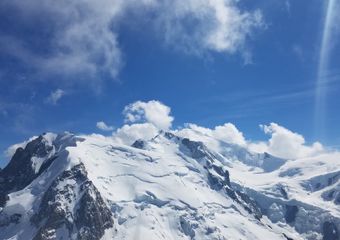
How to Hike Tour du Mont Blanc
1: overview.
The Tour du Mont Blanc (TMB) is a loop hike of ~110 miles with ~30,000 feet of elevation gain (and subsequent loss) that circumnavigates Mont Blanc massif, a 16,000-footer in the Alps. The trail’s highest point is 8,700 feet, which is not high enough to cause altitude sickness in most people. It’s easiest to fly into Geneva (though there are many other options for transportation if you want to get creative and fly into other parts of Europe), and then take a bus or shuttle the 1.5-hour drive to Chamonix (pronounced sha-mo-nee), France, where most people start and end their hike. The trail goes through France, Italy, and Switzerland. It’s typically hiked counterclockwise, to make the elevation more gentle and put better views at the end. The trail has a classic route, with many variants as options to make it more challenging or, in one case, to avoid a section with metal ladders.

Courtesy of Flickr
It’s a popular trail for Europeans going on vacation during their summer break – July and August. Some Brits go adventuring on the Tour du Mont Blanc as well, but it’s pretty uncommon for Americans. Of the people who hike the Tour du Mont Blanc, something like 95 percent of them are either on a guided or self-guided tour. Unsurprisingly, it costs a lot to pay someone else to plan this for you; I saw anywhere from $1,000 to $5,000 beyond the actual costs of the reservations. Many places offer the option of having your bag carried from hut to hut by donkey. If you’d like to pay REI $5,400 (doesn’t include transportation costs), you can do the Alps in style.

It’s worth noting that none of the guided trips and very few of the self-guided trips I found offer the option to hike the entire Tour du Mont Blanc . Almost every single one cuts out portions of it, and uses chairlifts to avoid longer ascents or descents. This didn’t sit well with me; I wanted to hike the entire Tour du Mont Blanc end to end, and I wanted to know where we were going and why. And I’m very frugal and the idea of paying someone else to plan my trip was physically painful to me, so I dug into it on my own.
The most popularly recommended guide book by far is The Tour of Mont Blanc: a complete two-way trekking guide by Kev Reynolds . It’s a comprehensive guide to hiking the Tour du Mont Blanc, offering a lot of description about the trail’s surrounding landscape, with information about lodging, services, and towns. As a whole, they mainly offer phone numbers for each place of lodging, though sometimes websites are noted as well. I would recommend purchasing the book ($18) if you’re thinking about doing the Tour du Mont Blanc – it is worth the money. However, as a number-crunching hiker, it didn’t offer me quite what I wanted. The distance was only provided as totals for each section and the elevation profiles were so small, they were relatively worthless. I wanted something like The AT Guide or the Thru-Hiker’s Companion . As I couldn’t find this information anywhere, I ended up making my own mileage and elevation tables in Excel. I also ended up purchasing this map ($20); it took me a bit to find the Tour du Mont Blanc on the map, but once I did, it helped me with my planning process. There is also a really helpful interactive map here on the Autour du Mont-Blanc website.

For those who might want to tent camp the Tour du Mont Blanc, know that it’s more complicated than it might first appear. Not only can it be challenging to bring camping gear on an airplane, it’s illegal to wild camp along the entire TMB, except in emergency situations above 2,500 meters, including outside a hut. While there are often campgrounds in or near towns, it can make your mileage more complicated. Or you could do dispersed camping and risk the consequences of being caught – $650 fine per tent. Besides, who wants to carry a heavy pack when you really don’t have to? And showers every day can be so nice! There are a number of online resources available discussing the Tour du Mont Blanc as a tenting vacation, if desired. If I like the TMB, I may return in the future with a tent, but for now, I’d just as soon reduce the number of things that I need to worry about.

2: Transportation and Travel Dates
So first things first – what time of year to hike the Tour du Mont Blanc? Most hostels don’t open until mid-June, because there can still be substantial snow in the mountains up until the beginning of June. If you’re hiking the Tour du Mont Blanc in June, it’s recommended that you check that huts and hostels will be open and bring traction devices like Microspikes. Yearly snowfall makes a difference, and if it hasn’t melted yet, some sections of the Tour du Mont Blanc can be completely impassable in June. July through mid-August are busier times of year, with Europeans on break, and July gets more rain than August or September, though all services are open and you’ll have warmer weather. Mid-August through the mid-September are generally nicer, with less people, less rain, and cooler weather. However, many hostels close in mid-September, so it can cut down on your lodging and refueling options if you go any later than that. And oh, there’s also an ultramarathon of the TMB each year in mid- to late August, so you may want to avoid those dates; it will be an absolute zoo. I had wanted to hike in mid-June but due to work and other summer hiking plans, I was locked into hiking this trip in mid- to late-July.
I used Google Flights , Scott’s Cheap Flights , and FareCompare to track the cost of various flights. Google Flights is a good tool to compare different departure locations; for my location, Boston was by far the cheapest. I kept an eye on the deals and jumped at round trip tickets for $633 per percon back in January. Most flights to Europe during the summer quickly work their way towards $1,000+ for a round-trip ticket. Buy earlier, and keep your eye out for flash sales.
Our economy tickets include one free checked bag. For the flight there and back, I’ll be putting my backpack inside a duffel bag that can be packed down once we arrive. The first hostel we’re staying at in Les Houches will hold a small bag for a euro per day, so we may leave the packed duffel bags and some town clothes in a small bag with them and retrieve them when we stay there again on our next-to-last night.

Something that came up for me as I began preparing my supplies was realizing that international travel can make it challenging to take medication. As someone who needs to inject medication, it was that much more complicated. So, the bottom line is this: for traveling to Europe, all prescription medication should be in its original container with the prescription label noting it’s yours. For traveling with syringes, you will also need to have a letter from your physician noting the medical necessity or they could be confiscated.
Shuttles Between the Airport and Chamonix
Most round-trip shuttles between the airport and Chamonix cost between $140 and 175. I found this prohibitively expensive, so I explored my options for bus and train travel. As best as I can tell, there isn’t a train station at the airport, so you would need to travel from the airport to a local train station. There are more public buses leaving from the Geneva bus station, but that’s a few miles away from the airport. I ended up settling on the Ouibus , as it’s $47 for a round-trip ticket and they leave from the airport every two hours and drop off in Les Houches and Chamonix. They also offer free rescheduling of your ticket if you reschedule 30 minutes or more in advance of the bus’s departure, and have a handy app to help you navigate that process. It does mean that we’ll end up returning to the airport for our flight home maybe an hour earlier than required, but it’s worth the price differential.

Reservations
I flailed around for a while, trying to figure out the best way to put in reservations for lodging on the trail. I was overjoyed when I found the Autour du Mont-Blanc . This is a wonderful site, and it’s almost everything you need to plan lodging for trekking the Tour du Mont Blanc. They help you plan an itinerary , based on where you’ll be starting and which direction you’ll be going. Once your starting point and direction are established, it will show you the nearest hostels and huts by walking distance, and also provides a lot of information about the services at the huts and hostels. Once you create an itinerary, it will assist you in reserving space at all of those places that offer online reservations. It will also tell you which places you must contact directly. Between this website, Google, and Kev Reynolds book, I was able to locate email addresses for all lodging that didn’t take online reservations, and placed all my reservations without making any phone calls. Before leaving on the trip, be sure to print out your reservation emails as proof. I read stories of people’s private room reservations not being respected because they hadn’t followed the directions to print out their reservation email as proof.
For Chamonix and Courmayeur, I found hotels through online searches. I found the hotels search within Google Maps to be the cheapest and most thorough option. For Courmayeur, we’ll be staying at Hotel Berthod ; in Chamonix, we’ll be staying at Le Vert Hotel . They were among the least expensive options, and both have excellent ratings on Google and TripAdvisor.
When I placed my reservations, I paid 335 euros and 20 CHF to reserve or pay in full for lodging; six of the 13 locations did not require any payment to make a reservation. Only two places required full payment up-front, and those were the two hotels (Courmayeur and Chamonix). All said and done, it was $800 each for me and my partner to get lodging, dinner, and breakfast for 13 nights; for three of those nights, we paid a bit extra for a private room. Other locations offered private rooms, but they were substantially more expensive than the basic hostel option, and we were unwilling to pay the difference.

Travel Sheets
Travel sheets are mandatory and very much desired for staying in huts and hostels in Europe. They provide pillows and blankets but do not provide sheets. Since there will be lots of people before and after you, it’s really the best idea to bring travel sheets with you. I purchased these synthetic ones for $20 and my partner purchased these silk ones for $33.
Most hostels have a place to handwash clothes and let them dry. We expect that we’ll be able to use a washer/dryer at the two hotels we’re staying at, and other than that, we’ll be handwashing everything. In looking for unscented laundry soap to bring with us, I found these dry laundry soap sheets. They don’t count against your liquids and can’t spill in your luggage. They can be cut or torn into smaller pieces for handwashing in a sink, and one sheet will take care of a small to medium load of laundry.

4: Safety and Communication
Mountain insurance.
When hiking in more mountainous places like the Alps, mountain insurance is recommended, which will cover things like the costs of a rescue team or a helicopter rescue, should you or anyone in your party get hurt badly enough they can’t self-rescue. It can also cover the cost of repatriation, which is the cost to return you to your country in case of serious injury.
After considering my options, I went with a yearly membership to the Austrian Alpine Club’s UK branch . They openly accept applicants from the US, and mailed me my membership cards. Membership includes mountain insurance, discounts at many huts and hostels, as well as a quarterly magazine. An adult membership starts at $60. They offer a variety of discounts for seniors, young adults, teens, and children. I ended up paying ~$110 for my partner and me, as they offer a discount for people who live together. With the discounts we receive at huts and hostels, it will pay for itself on our trip.

Health Insurance
You don’t want to be left holding the bill if something goes wrong overseas. Both me and my travel partner checked with our health insurance companies, to be sure that they cover medical care outside of the US. I was able to confirm it through their website, while my partner had to call the insurance company directly.
Plug Converters
For this trip in Europe, a Type C (‘Europlug’) converter will meet your needs, as it can be used with plug types E, F, J, K and L . I purchased this one for $12. You should check on your device or charger to be sure it offers both 110 and 220 volts (generally noted as 110-220 on the plug or device). Most items will have no problem with using a basic plug converter and don’t need a voltage converter (unless they’re high-powered appliances like hair dryers), but it’s worth double checking before you leave.
Phone Connection
While most hostels offer Wi-Fi, most huts do not. Given the complexity of this trip, I decided that I’d prefer to have full use of my phone during my trip and opted for a 30-day international phone pass. AT&T offers both a $10 per day and a $60 for 30 days international phone usage passport add-on, though it does need to be arranged prior to your departure.

I did research into currency exchange and found that ATMs and banks are your best bet for withdrawing money in the local currency. Airports do offer it, but will charge a huge percentage on top of the actual exchange rate. I will be getting a few hundred euros from AAA before we leave, just to tide us over and make sure we have something in case of emergency. There are ATMs available in: (France) Chamonix, Les Houches, Les Contamines, (Italy) Courmayeur, and (Switzerland) La Fouly. You’ll need to call your bank to make sure your ATM card will work. Check if your credit card company needs to be notified about you leaving the country or traveling. Most hostels require cash; maybe three to four hostels (all in Switzerland) take credit cards.
On the Tour du Mont Blanc, the predominant language is French; Italian, German, and English seem to be the next most-common. Since neither of us speak French, we worked on our basics using Duolingo. It won’t be enough to carry on full conversations, but we’ll be able to have some basic exchanges. From what I read, making an effort to speak at least some French is much appreciated by the locals.

5. Trip Cost
Our round-trip flights cost $633 each, and included one free checked bag; the Ouibus cost $47 each for a round-trip ticket. Total cost for 13 nights and 14 days in Europe came out to $1,535 per person, excluding incidentals and lunch, including RT flight, RT bus between airport and Chamonix, mountain insurance, and lodging with dinner and breakfast included.

*Featured image thanks to Flickr

This website contains affiliate links, which means The Trek may receive a percentage of any product or service you purchase using the links in the articles or advertisements. The buyer pays the same price as they would otherwise, and your purchase helps to support The Trek's ongoing goal to serve you quality backpacking advice and information. Thanks for your support!
To learn more, please visit the About This Site page.
Hi y'all, I'm Aubri ('Data'). I'm a queer, nonbinary hiker, backpacker, and trail runner (they/them pronouns, please). I've thru-hiked the AT ('13-'17), the Tour du Mont Blanc ('18), the Vermont Long Trail ('18), the John Muir Trail ('19, '21), the Tahoe Rim Trail ('19), and the New England Trail ('12-'17, '21), and summited all of the Winter New England 67, and completed the New England Hundred Highest and the Northeast 115 peaks. I've also run multiple 50ks, three 50-milers, and one 75-miler. I'm about 50% done with the PCT. This summer, I'm hiking the JMT with my partner, and section hiking more of the CA PCT. This winter, I'll be working on hiking the New England Hundred Highest. I'm hoping to thru-hike the Walkers Haute Route in Switzerland and section hike the rest of the PCT next year. At my day job, I'm a data-crunching research nerd, researching everything from medical outcomes for hospitalized patients to social determinants of health. During the week, I'm trail running, reading, and doing trapeze, and on the weekends, I'm generally out hiking some mountain somewhere. You can find trip reports and ramblings at https://transcendingmountains.blog/
This is a really informative post. Thanks for pulling all this together and sharing it.
Thanks for all the effort you have put into this; it will be a big help to many. Will look forward to reading about the trip after you return home…

You did a great job researching your trip and finding a way to keep the costs down. It’s hard to do all of this sight unseen.
I hiked part of the Tour du Mont Blanc when I did the GR5 (Holland to Nice, France). The Alps are amazing! Be prepared to be blown away by the beauty of it all. And I loved staying in the hostels on the trail. Les Houches (“lays hoosch”) sounds very familiar to me, so I assume I stayed there.
Please post a follow up report after your adventure. We’re all living vicariously through you.
Great post! Hope your trip was a blast.
Very informative, comprehensive and meticulous. Looking forward to your post on experience after the adventure !
Fantastic post! I’m planning my solo TMB for first week of july and I had very useful information from you. Thank you very much.
Very informative blog. We are doing the hike in August 2019 and done with most of our reservations. I wish I had come across your blog earlier. It would have saved us so much time 🙂
What Do You Think? Cancel reply

Well and Good Travel

The Foolproof Tour du Mont Blanc Itinerary: 10-Days
10 days of hiking in the Alps – the ULTIMATE wellness trip if you ask me. This Tour du Mont Blanc self-guided itinerary follows the traditional TMB route, includes tips, daily trail specs, and accommodation suggestions, and addresses some of the most common questions you might be asking yourself as you begin planning your tour.
The Tour du Mont Blanc, or the TMB, is a 105-mile (170 km) trail that circumnavigates Mont Blanc, the highest peak in Europe. The TMB is often considered one of the most beautiful through-hikes in the world, introducing hikers from around the globe to the exquisite and dramatic scenery of the Alps.
👉 Don’t forget travel insurance for this trip! I always use SafetyWing !
Want to save yourself a lot of planning time? Check out Skyhook Adventures’ 10-day guided trek if you want all of your accommodations, food, and transportation taken care of!
Tour du Mont Blanc Itinerary 10 Days

This itinerary does not include, but I recommend, staying in Chamonix for a couple of days before and after your tour, first to acclimate and then to relax.
The TMB is broken up into “stages”. Traditionally, there are 11 stages but depending on how many days you want to trek you can find different versions of the stages.
During your planning, and your trekking, take all distance, time, and elevation markers or estimations with a grain of salt. Mileage on GPS and in guidebooks and blogs rarely match up, and there are a lot of variables that affect the accuracy of the time estimations. The trail markers seem to allot 30 minutes for every mile, but depending on your age, the weather, and what shape you’re in, that will be different for every person. For your own sake, just always assume you’ll have an additional mile or 30 minutes 🙂
Tour du Mont Blanc Trek Specs:
- Distance: 105 miles / 170 kilometers
- Route Type: Loop
- Starting Point: Les Houches (traditionally)
- Direction: Counter-clockwise (although it can also be hiked clockwise)
- Total Elevation Gain/Loss: 33,632ft / 10,251 m
- Maximum Altitude: 8,500 ft / 2600 m
- Days To Hike: 7-12 days
- Countries: France, Italy, Switzerland
- Difficulty: Difficult (never flat, always up or down)
Tour du Mont Blanc Itinerary Disclaimers:
- Most stages have alternative route options, or “variants”, as they are called. This itinerary follows the traditional TMB route, except for day 10. Refer to the recommended guidebooks for variant options.
- Some stages have options to use public transport and lifts/gondolas to accelerate and shorten the path. This itinerary discloses any shortcuts by calling out *SHORTCUT*.
- There are many mountain huts/refuges along the TMB to choose from. This allows for total personalization of your trek. The huts recommended in this 10-day tour du mont blanc itinerary are huts that I stayed in and will provide my honest opinion about.
Day 1: Les Houches to Les Contamines

Do not get off at the first stop in Les Houches – stay on until you see the Office de Tourismo (on your left). Here you will see the TMB starting point arch. Take a photo and walk onward for about 10 minutes until you see the “Telecabine Bellevue”. *SHORTCUT* This will cut off a 2600 ft / 800 m climb through the forest. Begin your trek at the top of this cable car.
You’ll pass through many towns and villages today, and you won’t feel very “out there”. The signage is decent, just make sure you pay attention and don’t pass any turnoffs. Use the guidebooks and GPS for support.
✔ Mileage: 9 miles / 14.5 km (if you take the cable car, 11 if you don’t)
✔ Elevation Gain: ~ 1000 ft / 300 m (if you take the cable car, 3550 ft if you don’t)
✔ Estimated hiking time: 5 hours (with cable car)
💤 Where to stay: Gai Soleil

Gai Soleil is a quaint and quiet hotel just off the main road in Les Contamines. There is a lovely yard to relax in after hiking all day. The rooms are basic but very comfortable with amazing views. Breakfast was great and there is wifi. I would recommend staying here.
Day 2: Les Contamines to Les Chapieux
💪 This is one of the most challenging days of this 10-day tour du mont blanc itinerary.

Today you will climb over two Cols (mountain passes). You will see fewer towns and be pleasantly surprised by the beauty that is everywhere. Be prepared for lots of elevation gain and possible weather. It can get very cold (and wet!) at the top of the cols.
When you begin to descend from the second col, you’ll pass Croix du Bonhomme – a refuge. Stop here for hot chocolate or coffee but DO NOT stay here (outhouses, flies, no showers, etc).
BONUS: Look out and listen for lots of Marmots as you descend from Croix du Bonhomme!
✔ Mileage: 14 miles / 22.5 km
✔ Elevation Gain: 4500 ft /3000 ft down
✔ Estimated hiking time: 7 hours
💤 Where to stay: Auberge de la Nova
You will see the Auberge immediately as you descend into Les Chapieux (there isn’t much else here!). Try to get a private room if you can – unless you are fully comfortable sleeping in dorms. The dinner was one of the best dinners of the trek! Hot showers but no wifi or service.
Day 3: Les Chapieux to Rifugio Cabane du Combal
🌀 One of the most beautiful days of the trek!

Today you will get your first view of Mont Blanc from the trail and cross over into Italy via Col de la Seigne. To begin, take a bus from Les Chapieux to Les Mottets (NOT Ville des Glaciers). *SHORTCUT* This will cut about an hour and a half of walking on a skinny paved road which made sense to us (and most others).
There is a small wooden information center in Les Chapieux, just outside Auberge de la Nova. You can buy bus tickets here – try and buy them the night before in order to get the first bus, otherwise, you may have to wait until the 9 am bus (or just walk).
BONUS: When you get to Cabane du Combal, continue on another 10 minutes to see Lac Miage and the adjacent moraine – you’ll see the signs outside the rifugio. If you sit and listen at the top, you’ll hear small rockslides happen every few minutes as a result of the melting glacier.
The All Trails map linked below maps you to Rifugio Elisabetta. A lot of people like to stay here but I saw the sleeping area and would highly recommend continuing on to Cabane du Combal. It’s another 30 minutes and 1.5 miles on FLAT gravel road. Definitely stop at Elisabetta for a cappuccino though. You’ll have to climb up their long and steep driveway but it is worth it!

✔ Mileage: 10 miles / 16 km
✔ Elevation Gain: 3400 ft / 1036 m
✔ Estimated hiking time: 5.5 hours
💤 Where to stay: Cabane du Combal

Cabane du Combal is a very sweet rifugio with large, clean rooms and the dinner was really very good. They tend to get herds of ibex hanging around (hence their logo), so be on the lookout! We saw several here 🙂 Lastly, there is no wifi or service here.
Also read: Tour du Mont Blanc Refuges: Everything You Need to Know
Day 4: Cabane du Combal to Rifugio Maison Vieille
🌀 One of the most beautiful days of this tour du mont blanc itinerary!

This was one of my absolute favorite days. It was a short day but SO beautiful. On several days you trek through villages and towns, but this day you are just in the mountains the entire time. You’ll be walking at eye level with glaciers and alongside grazing sheep and cows. Take your time and admire the beauty in every direction.
ALTERNATIVE ITINERARY: As much as we loved Maison Vielle, I recommend continuing past Rifugio Maison Vielle and booking a hotel in Courmayeur. Courmayeur is the largest town you will go through and a great opportunity to stay somewhere nicer, and it will balance out the distances on days 4 and 5. The Alltrails map below goes to Courmayeur.
✔ Mileage: 6 miles / 9.6 km (to Maison Vieille)
✔ Elevation Gain: 1900 ft / 600 m
✔ Estimated hiking time: 3 – 4 hours
💤 Where to stay: Rifugio Maison Vieille

As I mentioned, I would continue on to Courmayeur. However, if you choose to stay at Maison Vieille you can spend the afternoon lounging in lawn chairs and sipping on cold beers. This is a popular lunch stop for day hikers so it’s very busy and fun. They only have dorms – no private rooms, FYI. But, they do have wifi.
Day 5: Rifugio Maison Vieille to Rifugio Walter Bonatti

Maison Vieille is situated at the top of a ski lift. When you depart on day 5 you can either sleep in and wait for the ski lift to open at 9 am to take you down to Dolonne or you can walk down the very steep descent which will take you about 2 hours. * This is another reason to stay in Courmayeur because you can take the ski lift down in the afternoon the day before.
*SHORTCUT* We chose to save our knees and took the ski lift as soon as it opened. You have to take a Gondola following the lift which drops you in Dolonne. You’ll walk about 10 minutes to Courmayeur. Build in some time to walk around and get some coffee if you can because it’s very cute here.
Next, begin your ascent through a paved neighborhood and then into a popular wooded hiking area. Stop at the top at Rifugio Bertone for a snack and beverage and then continue on. Today is another day of hiking eye to eye with massive glaciers… in fact, you’ll be sleeping directly across from one at Rifugio Bonatti!
✔ Mileage: 9 miles / 14.5 km (from Maison Vieille)
✔ Elevation Gain: 3600 ft / 1100 m
✔ Estimated hiking time: 6 hours
💤 Where to stay: Rifugio Walter Bonatti

Rifugio Bonatti is situated directly across from a massive glacier – it is an unbelievable location. The rifugio is a little newer and offers dorms and private rooms that are quite comfortable and clean. The dinner was pretty good. You have to get a coin for the shower and only get 4 minutes. There is no wifi, but some service. Although, if you ask nicely the staff might share the wifi password.
Day 6: Rifugio Walter Bonatti to La Fouly

On day 6 of this Tour du Mont Blanc itinerary, you’ll cross over into Switzerland. This is an absolutely stunning day of hiking, especially the climb to Grand Col Ferret (tough!). Prepare to see lots of rolling green hills, glaciers, cows, and sheep.
✔ Elevation Gain: 3200 ft. / 975 m
💤 Where to stay: Auberge des Glaciers

This Auberge is right in the center of town – as soon as you enter La Fouly you will see it. The rooms were cute (private) and the showers were hot! Dinner was delicious but it was an expensive auberge/refuge. Conveniently, there is a market right next door if you need to stock up on snacks.
Day 7: La Fouly to Champex

Day 7 is one of the easier days of this Tour du Mont Blanc itinerary. You will be in the forest most of the time. Look for wooden animal carvings along the whole trail. This day was very rainy for us – several people ended up taking the bus from La Fouly to Champex to avoid hiking in the rain. We were soaked by the time we got to La Fouly but ultimately we were glad we didn’t take the bus. You’ll pass through some really interesting and tiny Swiss towns today – not the most exciting day though.
✔ Mileage: 9 miles / 14.5 km
✔ Elevation Gain: 2000 ft. / 609 m
✔ Estimated hiking time: 4.5 hours
💤 Where to stay: Hotel Splendide

I had originally booked Hotel Belvedere, but when we arrived I was informed I accidentally booked it for the night before. They didn’t have room for us the night we needed it but it ended up being a BLESSING IN DISGUISE. Belvedere was very dark and dingy and the husband of the husband-wife combo was RUDE. We went next door to Hotel Splendide which happened to have a cancellation. It was such a treat to stay there. The rooms are sweet and gorgeous – amazing views and breakfast!!
Day 8: Champex to Trient

This day was challenging for us, mentally. Not incredibly tough but it felt very long. This was the easiest stage to get lost, in my opinion. When you leave Champex Lac, stay on the main road through town, following the TMB signs. If you turn off the road too soon you’ll find yourself in a maze of trails and the GPS is unreliable here. You’ll see a large boulder with “bovine TMB” painted on it. This is where you turn off.
When you reach Trient, continue on another km (15 minutes) to reach Le Peuty – it’s on the map.
BONUS: If you do the main route and not a variant, you’ll pass by Alp Bovine, a small unassuming rustic restaurant in the hills. The homemade tarts are AMAZING. The views and atmosphere are warm and authentic. A must-stop.
✔ Mileage: 12.5 miles / 20 km
✔ Elevation Gain: 2800 ft. / 853 m
💤 Where to stay: Le Peuty

I booked Le Peuty on a whim because it looked unique and fun and wow am I so glad I did. This was one of, if not the top place of all the places we stayed in this tour du mont blanc itinerary. The atmosphere and vibes here are unbeatable. There is a dorm above the kitchen, a huge field for camping, and one private yurt. I booked early enough that I was able to get the yurt and it was awesome. The BEST part of our stay though was hands down the food. Dinner was cooked fresh from scratch and could have come from a multi-star restaurant. Breakfast was equally as delicious. Best food and best vibes of the trip.
Day 9: Trient to Tre le Champ

This was one of our favorite days of the TMB. Our bodies felt conditioned to the daily grind and the weather and views were gorgeous. You’ll return to France today, via Col du Balme. It’s a steep ascent to the top so stop at the top for a coffee or beer (and photos!). As you reach the top you regain an unobstructed view of Mont Blanc and it remains in site the rest of the trek.
✔ Mileage: 10.5 miles / 17 km
✔ Elevation Gain: 3400 ft. / 1036 m
💤 Where to stay: Auberge la Boerne

The location of this Auberge is great, it’s very cute and rustic, unique, and has a very cool history. However, the dorm we stayed in was literally the size of a closet (not joking see pictures). It was fine – just funny. The dinner was also not very good – maybe the worst of the whole trip. All part of the experience though! I’d probably choose to stay here again versus hiking down into Argentiere if that’s any consolation.
Day 10: Tre le Champ to Chamonix

The final stretch! Today you will go through the “ladder section” which you will hear about during your TMB planning. It is a little nerve-wracking, but totally doable so don’t be deterred. If you have an intense fear of heights, you can avoid the ladders by doing the Col Des Montets variant.
We decided to take our first variant today and go to Lac Blanc. It adds on another hour or so and a bit of elevation gain but the views are worth it in my opinion. And the hike out of Lac Blanc is very cool and different from much of the rest of the path.
When you reach the ski lift, take it down to La Flegere, then continue on the TMB path to the Plan Praz gondola. This will drop you in Chamonix! Below is the trail map to La Flegere. If you want to do the Lac Blanc variant, just follow the signs once you get to the top of the ladder section.
There are a number of options to descend into the Chamonix valley (i.e. at La Flegere, Plan Praz, or further along) so decide what is best for you. We felt strong when we reached La Felgere so we decided to continue to Plan Praz. You do NOT need to buy lift cable car tickets ahead of time. However, make sure you get there before they close (5 pm).

✔ Mileage: 11.5 miles / 18.5 km
✔ Elevation Gain: 3200 ft. / 990 m
💤 Where to stay: Grand Hotel des Alpes

Treat yourself! Stay at the Grand Hotel des Alpes , in the center of Chamonix. They have an amazing spa with a gorgeous sauna and hot tub area (this was the major selling point for me). The rooms are stunning and the beds are amazing just stay here!!
Tour du Mont Blanc Itinerary Planning Resources
Blog posts, facebook groups, the official TMB website, GPS and weather apps, and guidebooks are all of the resources you will need to plan and hike your tour du mont blanc itinerary.
This Facebook group is very active and super helpful. People share their experiences, share all sorts of tips, and provide a decently accurate picture of what the current conditions and situation is on the trail.
I carried Jim Manthorpe’s Tour du Mont Blanc guidebook (2nd edition) with me and while it is not always 100% accurate, the detailed maps and elevation and distance charts were really helpful. He also covers all of the different variants available to you.

The official TMB website is a somewhat helpful planning resource. It is also the only way to book some of the refuges so if you plan on staying in mountain huts you will need to utilize this site.
Meteoblue is a helpful weather app to have – again, not always accurate of course but it’s more detailed than weather.com.
Tour du Mont Blanc Alltrails
While not always accurate, alltrails was the best GPS app for us. There are a number of route options that are downloadable. This way, if you don’t have service (which you won’t) you can still use the map. Alltrails has all of the traditional stages mapped out, as well as variants, alternative stages, and the entire loop even.
You will need to create an AllTrails account. Search for your desired stage, crosscheck it with guidebooks to make sure it’s accurate, and then download it. While you are hiking you will be able to go into the app and click on the respective stage and the app’s GPS will follow along the route.
FAQs About the Tour du Mont Blanc Hike
If you are just getting started with your TMB planning, I’m sure you have a LOT of questions. Don’t worry, everything will start to make sense and come together. It seems more daunting than it actually is. Hopefully, this FAQ gets you off to a good start!
What is the best time to hike the Tour du Mont Blanc?
August. I hiked this tour du mont blanc itinerary August 13th-22th and it rained two of those days. Earlier August you may see less rain, but I think generally anytime in August is a great time to hike the TMB. It was in the 80s in Chamonix, but higher up on the trail it was perfect hiking weather (60s and 70s).
If you go in June, you may encounter remnants of winter, in July it may be scorching hot, and in September it could snow. That being said, the trail will be busy June through September.

How much water should I carry on the TMB?
At least two liters. Although, you may need three liters during the hottest months or if you are planning on hiking longer distances than most people each day.
I carried two 1 liter Nalgene’s (I am not a fan of camelbacks) and never ran out of water. There are several water troughs along the route to refill if you are running low, although I recommend that you never begin the day with less than two liters just in case.
There are some occasions, particularly towards the end of summer, when the water is not flowing in all of the troughs along the trail. That being said, we found at least one water refill trough at every stage – and usually several.
How far in advance should I plan my Tour du Mont Blanc Itinerary?
Approximately, 6 to 10 months. If you plan on staying in refuges/mountain huts along the trail, you’ll need to book them well in advance. I booked all of our accommodations about 7 months ahead of our trip. If you plan on camping you have some more freedom to start your planning later.

Do I have to start the TMB in Les Houches, Chamonix?
No, absolutely not! Les Houches is the “official” starting point, and made the most sense for us because we wanted to spend time in Chamonix before and after our trek. However, there are several other starting points – pretty much any main town along the path can be a starting point. The only other starting point I would consider, personally, is Courmayeur.
How do I book the refuges?
The refuges, also called mountain huts, rifugios, and auberges, depending on what country you’re in, can be somewhat challenging to reserve. They need to be booked early if you want a guaranteed spot, and they all have different booking processes. For more information on how to book the refuges, refer to my post Refuges: Everything You Need to Know .
What gear do I need for the TMB?
See Tour du Mont Blanc Packing List [COMING SOON].
What To Expect on The Trail
- A variety of weather! Make sure you pack for every condition.
- Wildlife! Specifically, marmots, ibex, chamois, vultures, deer, sheep, cows, and goats.
- Crowds. The TMB is one of the most famous treks in the world, you are going to be hiking with a lot of people. There are days when you may not see many people, but most days you will see a lot. One positive is that it makes the trek feel very safe and is a great option for solo female hikers.
- Wild berries! You will find wild blueberries along much of the route, and occasionally some wild raspberries.
- Water refill stations. As I mentioned earlier, there are several water refill troughs along each leg of the hike. Make sure to always pack enough water for the day in case they are dry. Check Facebook groups to know the status of the water before you go.

Wrap-Up: Tour du Mont Blanc Itinerary 10 Days
So, if you are on the fence about hiking the TMB, let me just give you a little push. Allow yourself to breathe in the freshest of air, to gravel at the massive glaciers all around you, to sleep in places so remote that the stars seem brighter and more abundant than any place you’ve ever been. Give yourself a screen break, clear your head, and meet amazing people from around the world. Eat fresh homemade food every day, and drink untouched mountain spring water.
Use this Tour du Mont Blanc itinerary as a starting point – take what works for you and customize the rest to your needs.
Jade Gershen is the founder of Well and Good Travel. She has lived on three continents and explored more than 20 countries in the past 10 years. U.S. based, she also shares her favorite places to go and things to do in the States. Having experienced the impacts of chronic stress Jade has a particular interest in using travel and outdoor adventure to improve well-being and shares that with her readers.

Everything You Need To Know About Hiking The Tour du Mont Blanc
A s an avid hiker, you’ve probably heard of the Tour du Mont Blanc or TMB hiking trail. You might even have plans to conquer this popular hiking destination one day. If so, here’s everything you need to know before you go.
In 1760, a Swiss Geologist and physicist, Horace-Bénédict de Saussure, then living in Geneva, discovered the TMB hiking trail. Saussure wanted to explore the Mont du Blanc Mountains to examine and document plant specimens. Also called the Mont Blanc massif, the mountain range is 60 miles by 20 miles long, with 11 summits over 4,000 meters high. Though he discovered it in 1760, Saussure first walked around the entire TMB hiking path in 1767.
Unfortunately, the Swiss scientist failed to climb one of its peaks on that initial journey around the path. The first to achieve this feat were Michel Paccard and Jacques Balmat. The two found a path to the apex in 1786 through the Grands Mulets route. Sausurre became the third person to reach the summit shortly thereafter.
Trail Overview
Though Pacard and Balmat first reached the peak of the Mont Blanc massif via the Grands Mulets route, the Gouter route is today’s standard path. This trail is 105 miles long and passes through 3 countries: France, Italy, and Switzerland . The Gouter Route (also known as the Voie Des Cristalliers and Voie Royale) is one of the two most commonly utilized routes to reach the summit of Mont Blanc in the Alps. Though the Gouter route reaches an elevation of 15,774 ft, it is considered the most straightforward ascent. The route lies on the north side of the mountain, in France, seeing thousands of mountaineers annually.
The Tour du Mont Blanc difficulty level is somewhat subjective to the hiker. The Gouter route is relatively easy because it takes about two days to reach the ascent and does not require extensive technical skills. Nonetheless, it is physically demanding and mentally challenging if you lack athletic ability. The most difficult aspect of this route includes a narrow passageway of unstable rocks on the mountain’s edge. Seventy-four have died, and 180 were injured in accidents along this dangerous segment between 1990 and 2011.
Once passing this tricky part, the Gouter route is smooth sailing. It steadily increases in steepness while crossing exposed terrain. Hazardous weather conditions are the most dangerous aspects that remain. Cold and wet conditions can cause hypothermia and frostbite. Therefore, visiting the Tour du Mont Blanc for Summer hiking, Mid-June to mid-September, is safest. During the summer, temperatures will range from 40 degrees at night to 80 degrees during the day. Some days require shorts beneath a warm, sunny sky ; others might entail brisk, wet conditions.
Permits And Regulations
No permits are required for the TMB and there are no regulatory restrictions. However, some believe a technical skills test could reduce deaths and injuries along the path. Additionally, residents are disturbed by the amount of trash that hikers inevitably abandon to lighten their loads on the ascent. What’s interesting about the Tour du Mont Blanc is that there are many comforts along the path in the form of hotels and huts. Several companies offer self-guided packages that include accommodations, detailed hiking guides, and set itineraries.
Trail Highlights And Points Of Interest
The Tour du Mont Blanc hike is considered one of the world’s top ten “bucket list” hiking trails. In addition to the soothing sounds of waterfalls , there are glaciers, streams, high alpine meadows, and the natural beauty of the Mont Blanc landscape. Among the most beautiful and visible flora are the rare Slipper Orchid, the Martagon Lily, Aquilegia Alpha, the famous Edelweiss, and rare Campanula thyrsoides. Though heavily impacted by human presence, the animals that remain in the wilderness of the Mont Blanc massif include Marmots, Ravens, Goats, Mountain Hares, Vultures, and Eagles, among others.
Safety Considerations
On the Tour du Mont Blanc hiking trail, the most important considerations will be comfortable shoes and a good quality backpack with appropriate dimensions and weight. What qualifies as an appropriately sized bag will depend on whether you stick to hiking the trail or detour slightly to local huts and hotels. The former will require a 60L bag, and the latter will require a 30L bag. Remember to break in your footwear a few months in advance and buy shoes larger than usual to accommodate swollen, achy feet. Trekking poles will help lessen aches and pains experienced in the knee and leg muscles. Hiking crampons are a “better safe than sorry” item to add to your Tour du Mont Blanc packing list. They will help maintain balance and avoid slipping across waterways and snow patches, which might even save a life!
In case of an emergency, administer first aid, note location and grid reference on a map, call for help (cell phone service is generally available along the TMB). If no phone is available, blow a whistle or flash a flashlight six times. If there is an injured person, carefully consider whether to go for help or stay with the injured. If the injured party stays behind, leave them with food, water, and warm clothes.
Planning and Preparation
Being physically prepared for the TMB hike is a necessary safety precaution. Training should start at least three months in advance and should be in layered clothing, hiking boots, and a fully packed backpack to best simulate trail conditions. Other things that require planning include booking accommodations along the trail and deciding how many days to stay. An itinerary will vary depending on whether two days, two weeks, or even two months are set aside to experience the beauty of TMB.
Most hikers can ascend the Tour du Mont Blanc self-guided if interested. The trail is easy to follow, with well-maintained paths, directional markings, and clearly understood signs. However, map reading skills are essential, and hikers should also carry a guidebook.
People Ask: Hiking the Tour du Mont Blanc
Q: What is the Tour du Mont Blanc hiking trail?
A: The Tour du Mont Blanc is a 170-kilometer hiking trail that circles the Mont Blanc massif in the Alps, passing through France, Italy, and Switzerland.
Q: How long does it take to complete the Tour du Mont Blanc?
A: The entire trail takes about 10 to 12 days to complete.
Q: What is the best time of year to hike the Tour du Mont Blanc?
A: The best time to hike the Tour du Mont Blanc is from mid June to mid September, when the weather is typically mild and the trails are clear of snow.
Q: Are there any accommodations along the trail?
A: Yes, there are many accommodations available along the Tour du Mont Blanc, including hotels, hostels, and mountain huts.
Q: Is it necessary to hire a guide for the hike?
A: No, it is not necessary to hire a guide for the hike. The trail is well-marked and there are many resources available for hikers.
Q: How difficult is the hike?
A: The hike is considered to be moderately difficult, with some steep ascents and descents.
Q: What should I pack for the hike?
A:You should pack appropriate hiking gear, including sturdy boots, warm clothing, and rain gear. You should also bring a map, a compass, and plenty of water and snacks.
Q: Are there any safety concerns I should be aware of?
A: Yes, there are some safety concerns to be aware of, including potential hazards such as steep drops, loose rocks, and unpredictable weather. It is important to stay on the marked trail and to be prepared for changing conditions.
Q: Can I hike the trail in sections?
A: Yes, it is possible to hike the Tour du Mont Blanc in sections, with many hikers choosing to focus on one or two sections at a time.
Q: What are some of the highlights of the hike?
A: Some highlights of the Tour du Mont Blanc include stunning views of the Alps, charming mountain villages, and the opportunity to experience the unique cultures of France, Italy, and Switzerland.
The Tour du Mont Blanc is a renowned hiking trail accommodating hikers from across the globe. It is mentally and physically challenging, but efforts will be rewarded with breathtaking views along the route. The TMB is accessible with or without a guided tour, as there is food, water, emergency services, accommodations, and other modern amenities along the path. With a reasonable amount of advanced preparation, physical training, thoughtful packing, and a conscientious “Leave no trace” mindset, this unforgettable journey is worth experiencing for yourself.

Sending email...
Email sent!
You are using an out of date browser and this website will not function properly.
Please upgrade to Edge or Chrome browsers.

+33 (0)781586903
montblanctreks
- Dates & Prices
Celebrate Earth Day this April. MBT will be donating a portion of each booking, to our conservation partner, EOCA. Book now for 2025!
Tour du Mont Blanc Map

If you look at a map of the area, the Mont Blanc range forms a compact mass of complex mountain structures, passable via a circular route making use of its surrounding valleys and relatively low level cols or mountain passes.
Traditionally, the Tour du Mont Blanc starts and finishes in the Chamonix Valley and moves anti-clockwise through France, Italy and Switzerland and returns in to the Chamonix valley for the last few days of the trek.
Over time, all manner of variants have been included. For example, Col de Tricot from Les Houches to Contamines or Fenetre d'Arpette from Champex-Lac to Trient. Often these variants make the Tour du Mont Blanc more challenging with more height gain and descent and tougher terrain.
The Tour du Mont Blanc full circuit is often undertaken in reverse and can seem very different when done in the opposite direction.
Scroll down to view the full circuit, easterly and westerly routes.
Tour du Mont Blanc Full Circuit Map
Approximately 170 kilometres in length with an accumulation of 9,500m of height gain. The Tour du Mont Blanc full circuit starts and finishes in the Chamonix valley the route circumnavigates the Mont Blanc Massif taking in some of the most spectacular alpine scenery through France, Italy and Switzerland.
Click the route sections on the map for more info
Chamonix to Les Houches
Distance: 13k | Height gain: +700m | Descent: -1500m
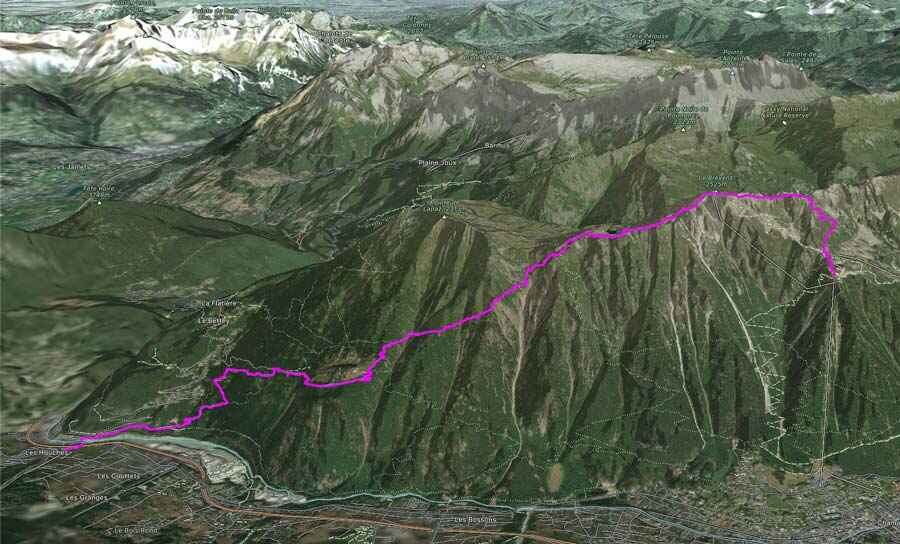
We commence the Tour Mont Blanc full trek from Chamonix taking the cable car to the Planpraz at 2000m, from here we take the TMB route to the Col du Brevent, Brevent 2525m and descend along the stunning ridge to Refuge Bel Lachat. From the refuge, we make the long and tough descent via Parc Merlet to Les Houches and our hotel accommodation for the night.
Accommodation
3* Hotel, private en-suite rooms, evening meal & breakfast
Guide notes:
This day often feels one of the toughest on the trek generally because people are not fully acclimatised. The descent can be punishing & is probably the most difficult during the trek due 1500m sustained down hill & at times rocky terrain. Walking poles are recommended to save the knees!
Les Houches to Les Contamines
Via Bionnassay: Distance: 15k | Height gain: +100m | Descent: -700m Via Col du Tricot: Distance: 13k | Height gain: +800m | Descent: -1300m
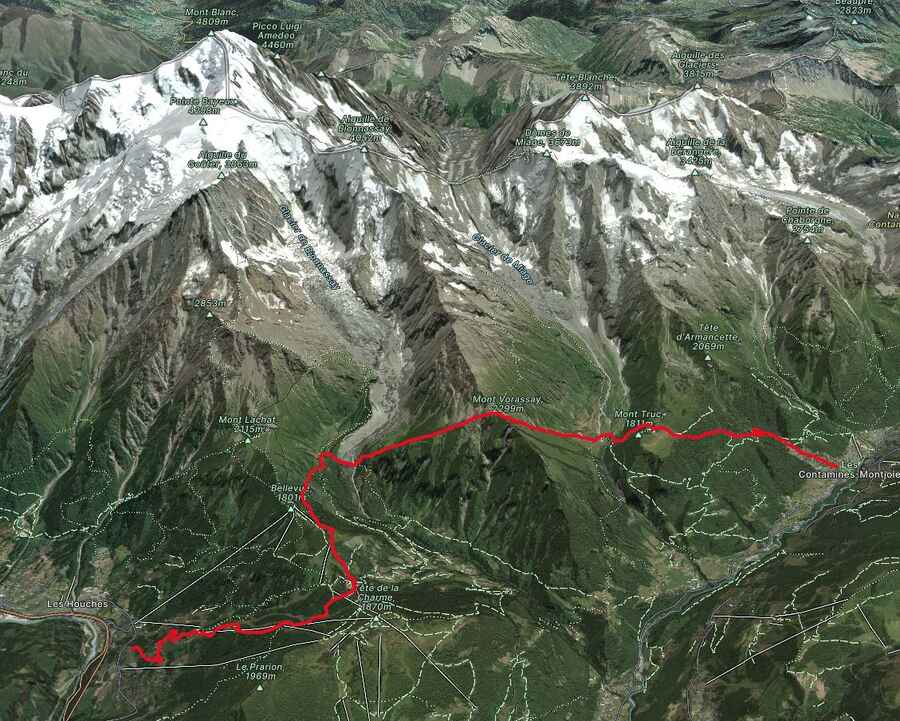
Our day starts with a cable car ride to the Bellevue 1802m with stunning views of the Mont Blanc range from high above the westerly end of the Chamonix valley. We then have a choice of routes to Les Contamines via Bionnassay and Chapel or the Col du Tricot and Chalets des Miage.
3* Hotel, private en-suite rooms, evening meal and breakfast
Day two and you are probably feeling a little tiered from the first day. The terrain is very different today, less rugged and more green as you will be trekking though high altitude pastureland. If you are trekking via the Col du Tricot check out the Blueberry pie at the Chalets des Miage, very memorable and delicious!
Les Contamines to Refuge Mottets
Distance: 20k | Height gain: +1500m | Descent: -900m
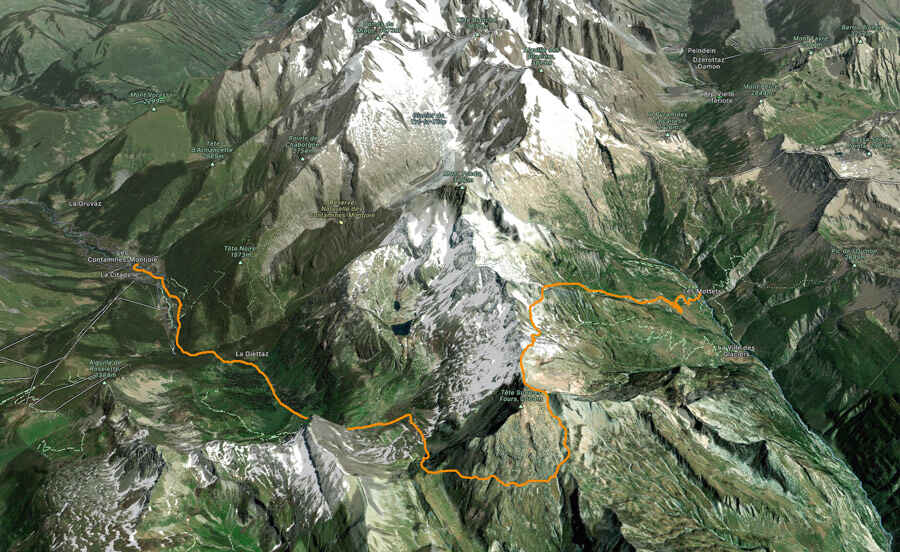
A great day ahead awaits and we make our ascent through three cols, Col du Bonhomme, Col de la Croix du Bonhomme and the Col des Fours 2665m. Descending steeply through the wild and remote landscape to Ville des Glaciers and our rest stop for the night at the atmospheric Refuge Mottets.
Dormitory (upgrade possible), evening meal & breakfast
On paper this looks like one of the longest and toughest days on the trek but don’t worry its very doable. There is a fair amount of height gain but it is integrated with sections of gentle terrain, which make the day more manageable. The key is to start early & allow plenty of time.
Refuge Mottets to Courmayeur
Distance: 14k | Height gain: +700m | Descent: -700m
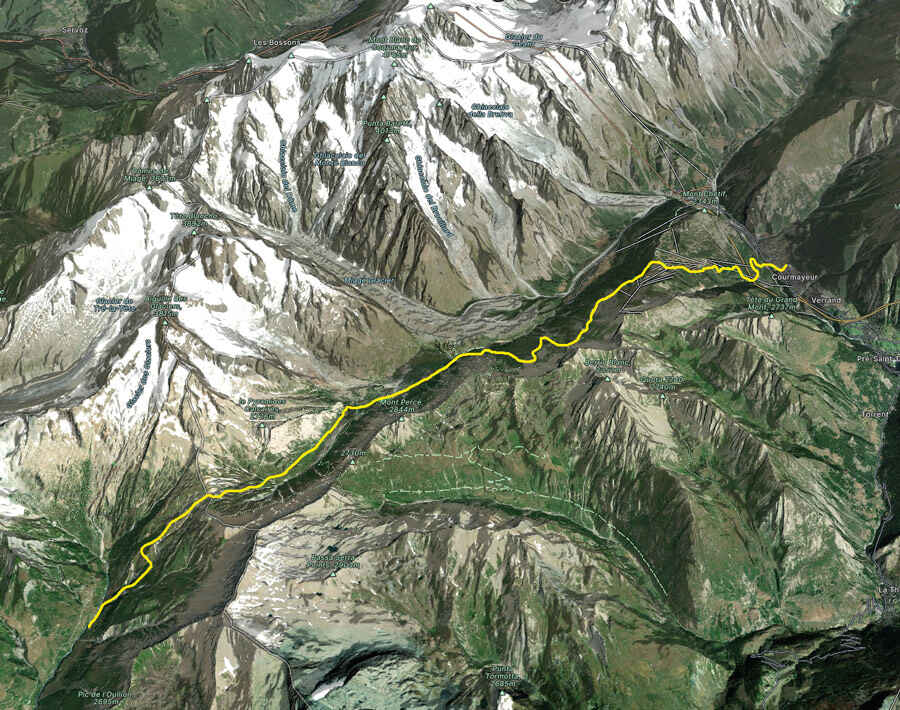
By staying at the Refuge Mottets it gives us a great position below the Col du Seigne 2516m, although we climb steeply at times we soon find ourselves over the col and across French/Italian border into Italy. We then make a descent into the stunning Val Veny with easy walking through the hanging valleys to Lac Combal. From here we descend La Visaille and take the shuttle bus to Courmayeur.
3* Hotel, private en-suite rooms, B & B
One of my favourite days on the Tour du Mont Blanc, the views from the Col du Seigne is second to none! Once you are at the col and if the weather is right rest for a while and take in the far-reaching views in to Italy & Switzerland, just wonderful!
Courmayeur to Refuge Bonatti
Distance: 17k | Height gain: +750m | Descent: -50m
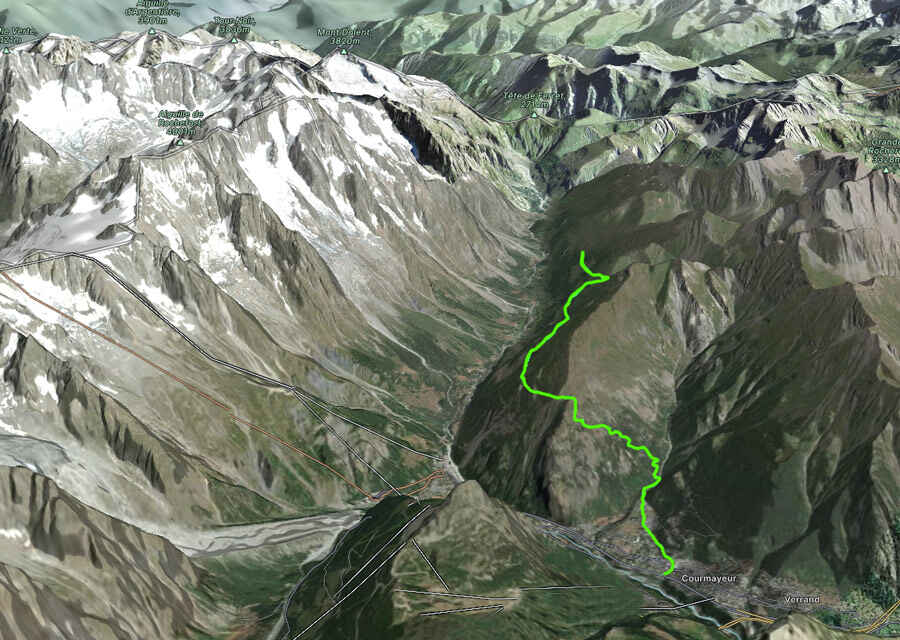
Fully refreshed we make our ascent to the Refuge Bertoni and enjoy amazing views of Mont Blanc and Courmayeur down below. We spend the rest of the day on a lofty traverse from high above the Val Ferret with stunning views of the Italian side of the Mont Blanc before reaching our accommodation at the beautiful Refuge Bonatti 2056m.
A steep but steady climb up to the Refuge Bertoni, it’s worth it because the coffee is fabulous & the views just stunning, elevenses’ here is a must! Fabulous views of some of the most famous peaks in the European Alps including Mont Blanc and the Grand Jorasses. And for the refuge Bonatti... its just fabulous, if the night is clear go our side after dinner and just 'be' in this impressive location.
Refuge Bonatti to La Fouly
Distance: 20k | Height gain: +900m | Descent: -1400m
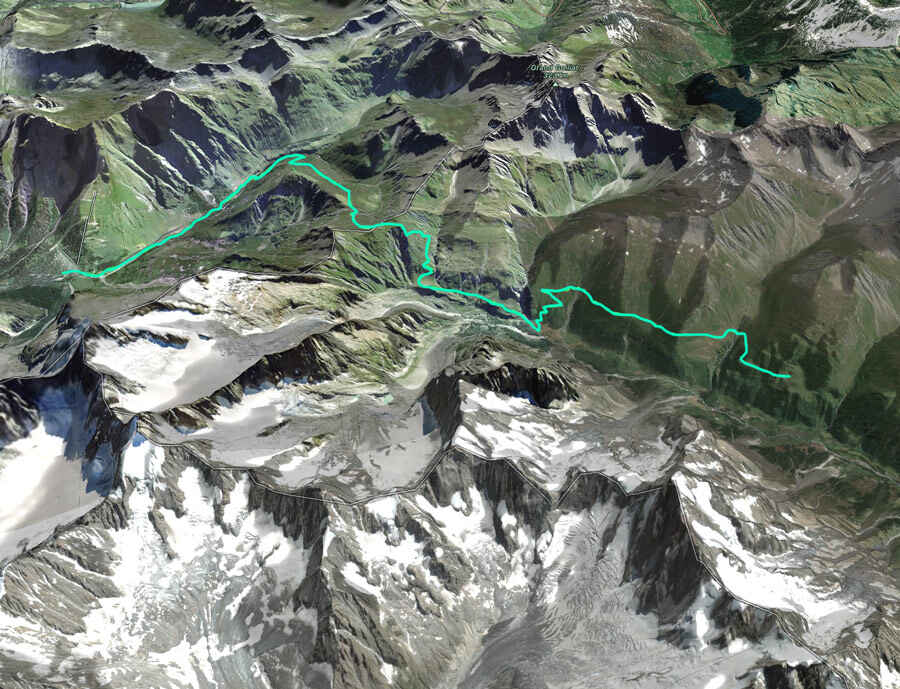
An early start and a new country awaits, we continue through the Val Ferret to Arnuva before making our long ascent to the Grand Col Ferret 2537m via the Refugio Elena and the Italian/Swiss border. We then make a relatively easy and enjoyable descent via la Peule, Ferret to La Fouly and our hotel accommodation for the night.
3* Hotel private en-suite rooms, evening meal & breakfast
Again this day looks tough but the hard bits are nicely spaced with less challenging terrain & once at the Col stare in wonder at the view looking back at your last 3 days of trekking towards the Col du Seigne & over the boarder into Switzerland. The descent is long but at an easy angle & the path is good. Plenty of opportunity to stop for refreshments at Arnurva, Refuge Elena & La Peule.
La Fouly to Champex Lac
Distance: 18k | Height gain: +750m | Descent: -950m
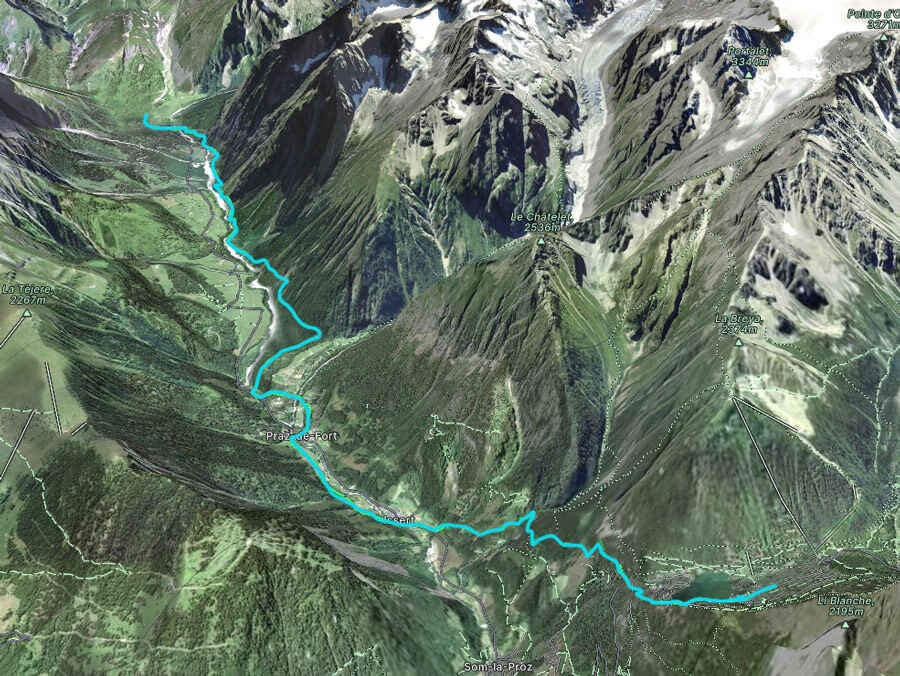
An easy day in comparison walking in the beautiful Swiss Val Ferret. We then pass through the Swiss villages of Praz de Fort and Issert before make our ascent to the charming village of Champex-Lac and our resting place for the evening.
Auberge with private rooms & shared facilities, evening meal & breakfast
The Bovine route is a fabulous day not too tricky over lovely terrain. Lunch stop at the high alpine farm at Bovine is a must, you can purchase local food or even eat your own picnic on the terrace as long as you buy a drink. Amazing views across to Lac Leman & down the Rhone valley.
Champex Lac to Trient
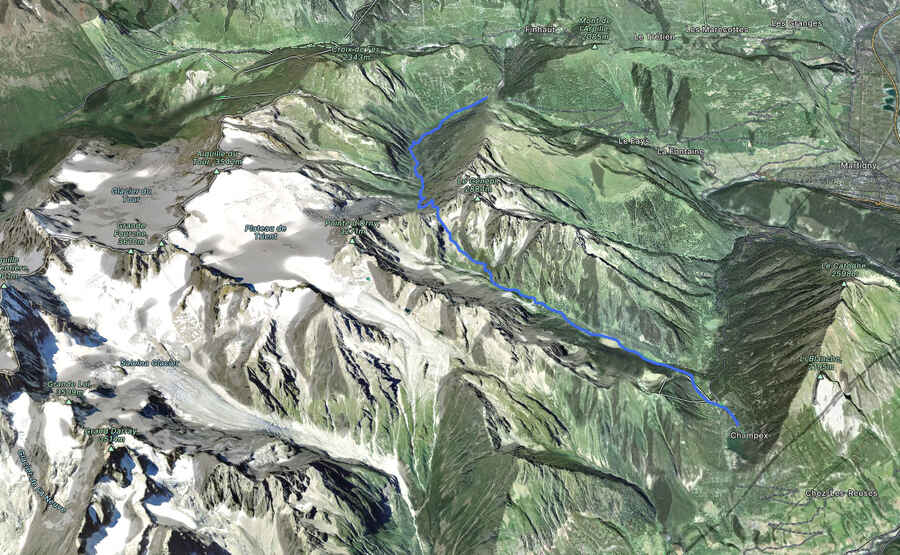
An initial easy start to the day is to be had as we wind our way on easy paths to Plan de l'Au. We then climb up steadily to the Alpage Bovine 1987m and enjoy fabulous views over Martigny and the Swiss Valais. We spend the rest of the day making our descent to the Col du Forclaz 1526m with a final descent to Trient.
Auberge with private rooms and shared facilities, evening meal and breakfast
The Bovine route is a fabulous day not too tricky over lovely terrain. Lunch stop at the high alpine farm at Bovine is a must, you can purchase local food or even eat your own picnic on the terrace as long as you buy a drink. Amazing views across to Lac Leman and down the Rhone valley.
Trient to Argentière
Direct via the Col du Balme: Distance: 13k | Height gain: +900m | Descent: -900m Via Catogne & the Col du Balme: Distance: 15k | Height gain: +1000m | Descent: -1000m
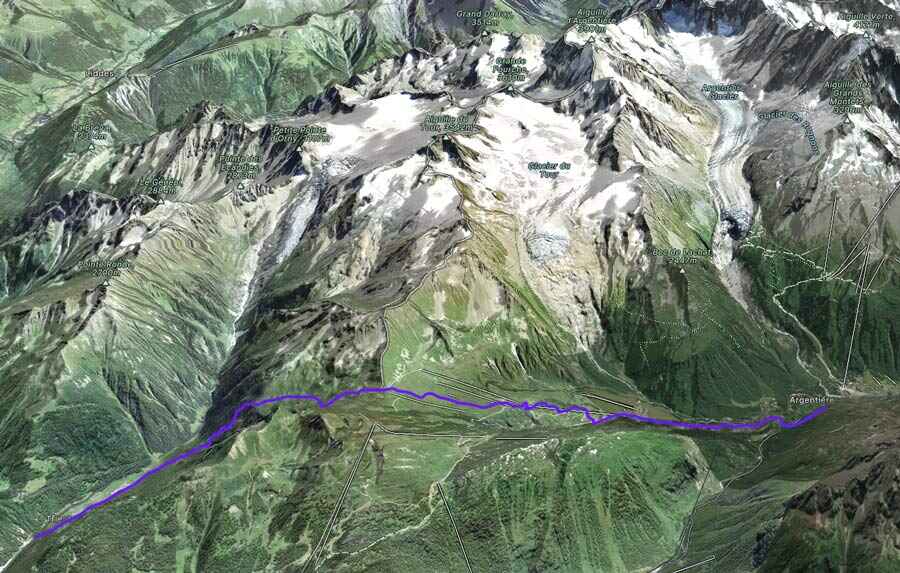
Today we have two options as we can take the route directly to the Col du Balme from Trient or through alpine woodland to the Alpage of Tseppes, Catogne and on to the Col du Balme 2191m and the Swiss/French border. From the Col, we then make our descent to the hamlet of Le Tour and across pastureland to the village of Argentiere and our hotel accommodation for the evening.
4* Hotel private en-suite rooms, B & B
Personally unless the weather is bad take the route via Catogne, the views are far superior as one up high you take a lofty traverse with excellent views over towards Emossom dam & the Aiguille Rouges nature reserve.
Argentière to Chamonix
Distance: 14k | Height gain: +1200m | Descent: -500m
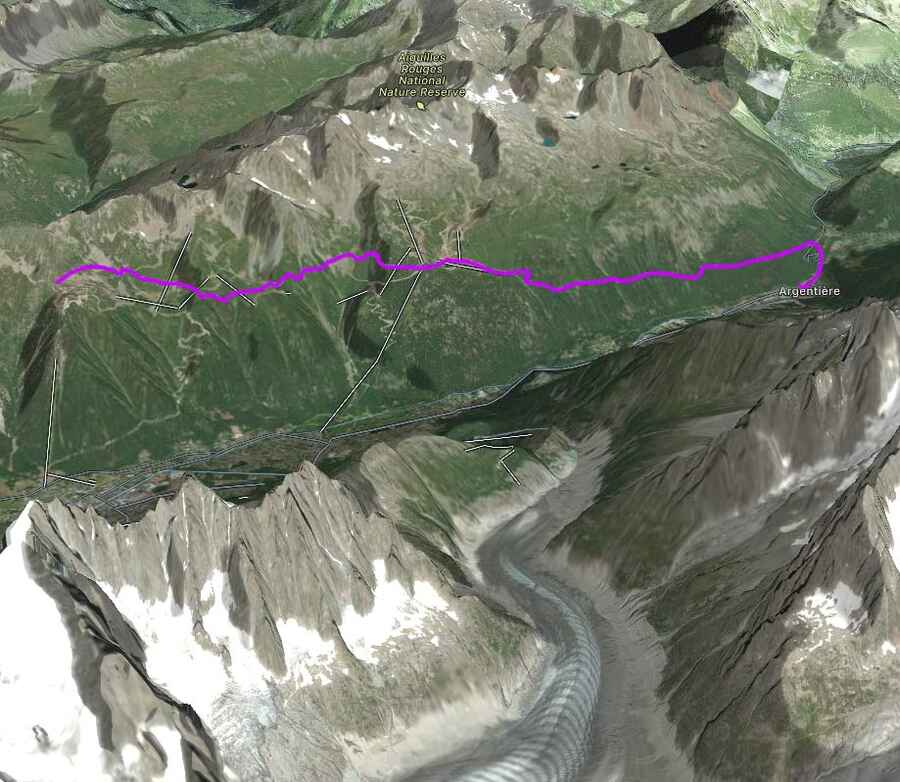
Our final day and a fitting end to the trek takes us back into the Aiguille Rouges to the stunning Lac des Cheserys and Lac Blanc 2352m. We then make a descent to Flegere and take the balcony path traversing high above the Chamonix valley to Planpraz at our starting point 11 days earlier completing the circuit. A final decent via the cable car back to Chamonix in time for a celebratory drink as you have just completed the Tour du Mont Blanc, one of the best multi day treks in the world. In the event of lift closures, we make our descent back to Chamonix via Flegere.
3* Hotel private en-suite rooms, B & B
A fitting end to the trek back in the Aiguille nature reserve with pristine views of the Mont Blanc massif and all its peaks and glaciers. Visiting the iconic Lac Blanc is a must and stop for refreshments in the refuge. It gets busy with day walkers in August so make an early start if possible.
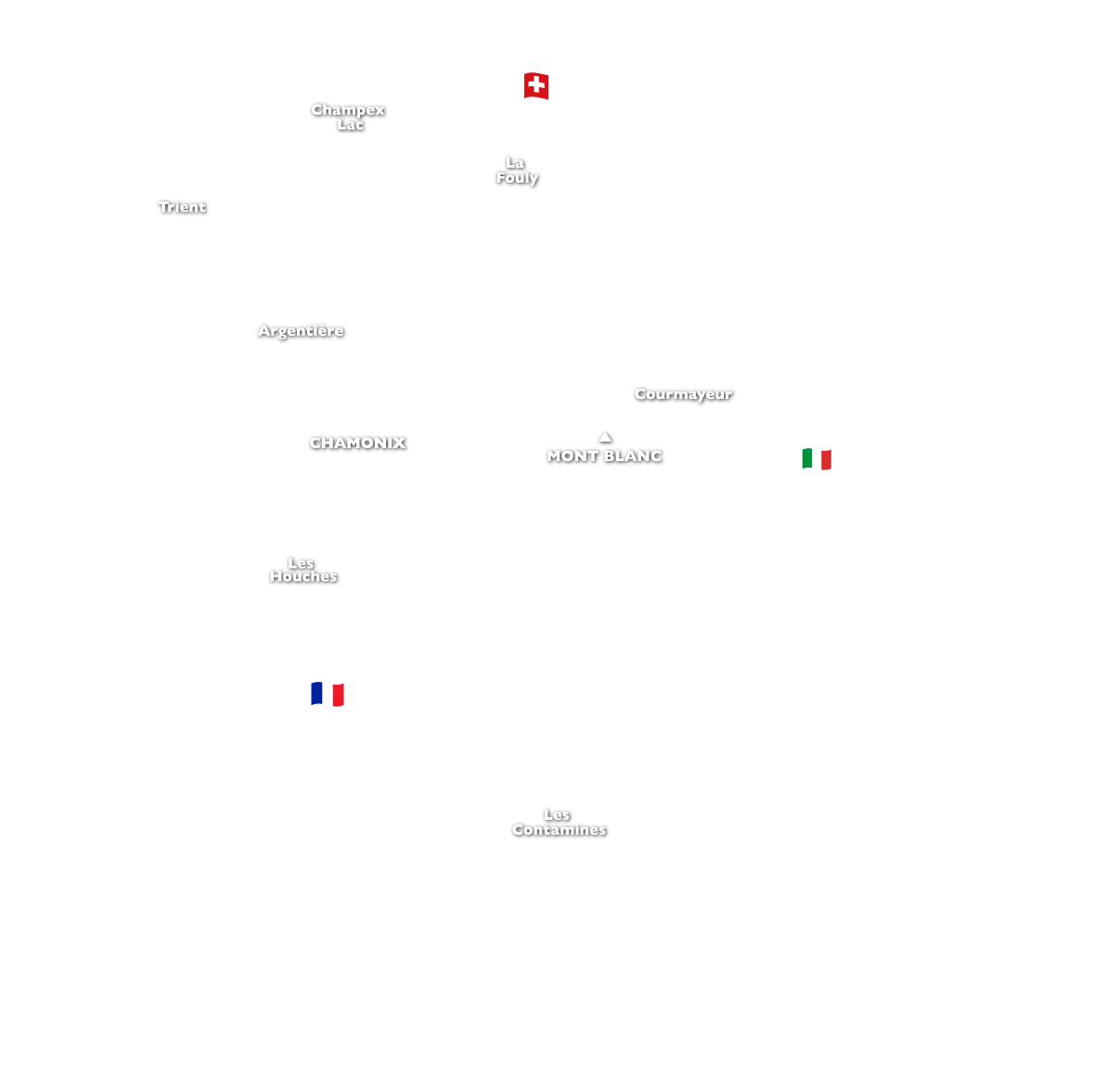
- 1. Chamonix to Les Houches
- 2. Les Houches to Les Contamines
- 3. Les Contamines to Refuge Mottets
- 4. Refuge Mottets to Courmayeur
- 5. Courmayeur to Refuge Bonatti
- 6. Refuge Bonatti to La Fouly
- 7. La Fouly to Champex Lac
- 8. Champex Lac to Trient
- 9. Trient to Argentière
- 10. Argentière to Chamonix
Tour du Mont Blanc Easterly Circuit Map
The Tour Mont Blanc easterly trek starts in Courmayeur and takes in half of the classic route anti-clockwise to Chamonix. It is a 6 day trek that covers approximately 100 kilometers through the Italian, Swiss and French alps. This walking holiday in the alps is ideal for those wanting to experience the Tour du Mont Blanc in a shorter period of time.
We make our ascent to the Refuge Bertoni and enjoy amazing views of Mont Blanc and Courmayeur down below. We spend the rest of the day on a lofty traverse from high above the Val Ferret with stunning views of the Italian side of the Mont Blanc before reaching our accommodation at the beautiful Refuge Bonatti 2056m.
- 1. Courmayeur to Refuge Bonatti
- 2. Refuge Bonatti to La Fouly
- 3. La Fouly to Champex Lac
- 4. Champex Lac to Trient
- 5. Trient to Argentière
- 6. Argentière to Chamonix
Tour du Mont Blanc Westerly Circuit Map
The Tour du Mont Blanc westerly route starts in Chamonix and takes in half of the classic Tour du Mont Blanc route anti-clockwise to Courmayeur. The route covers approximately 70 kilometers through the French and Italian alps. This trekking holiday in the alps is ideal for those wanting to experience the Tour du Mont Blanc in a shorter period of time.
We commence the Tour Mont Blanc westerly trek from Chamonix taking the cable car to the Planpraz at 2000m, from here we take the TMB route to the Col du Brevent, Brevent 2525m and descend along the stunning ridge to Refuge Bel Lachat. From the refuge, we make the long and tough descent via Parc Merlet to Les Houches and our hotel accommodation for the night.
This day often feels one of the toughest on the trek generally because people are not fully acclimatised. The descent can be punishing and is probably the most difficult during the trek due 1500m sustained down hill & at times rocky terrain. Walking poles are recommended to save the knees!

Tour du Mont Blanc Profile

Sign up to Our Newsletter
Marketing permissions.
Mont Blanc Treks will use the information you provide on this form to be in touch with you and to provide updates and marketing. Please let us know if you are happy to receive emails from us by checking the box below.
You can change your mind at any time by clicking the unsubscribe link in the footer of any email you receive from us, or by contacting us at [email protected]. We will treat your information with respect. For more information about our privacy practices please visit our website. By clicking below, you agree that we may process your information in accordance with these terms.
We use Mailchimp as our marketing platform. By clicking below to subscribe, you acknowledge that your information will be transferred to Mailchimp for processing. Learn more about Mailchimp's privacy practices here.
- Financial Protection
- Tel: +44 1273 256753
Tour du Mont Blanc
Tour du mont blanc packages.
- About the TMB
- Self-Guided Tour
- Guided Tour
- Guided & Self Guided Tour Prices
Client-shot video of the TMB
Highlights of the Tour
Places to stay, nant borrant.
- Eccles Refuge
Style of Trek
- Tour du Mont Blanc – Budget Trek
- Tour du Mont Blanc – Guided
- Tour du Mont Blanc – Self Guided
The Nant Borrant refuge (mountain hut) is situated just over 5km south from the centre of Les Contamines village. It is located directly on the… ...
Located half-way around the Tour du Mont Blanc, hikers often stay in Courmayeur, or one of the surrounding villages, for two days. Normally this is… ...
Located within the commune of Courmayeur, La Palud is a village which serves as a good place to stop for one or two nights when… ...
La Fouly (1600m) is a small village on the Swiss sector of the Tour du Mont Blanc and is at the road-head of the great… ...
Champex Lac is located in the North East sector of the Tour du Mont Blanc. If trekking in a clockwise direction from Chamonix you arrive… ...
Located at the northern end of the Chamonix Valley, Argentiere (1230m) is a large village offering a more peaceful alternative to Chamonix town. There are… ...
News Articles & Blogs
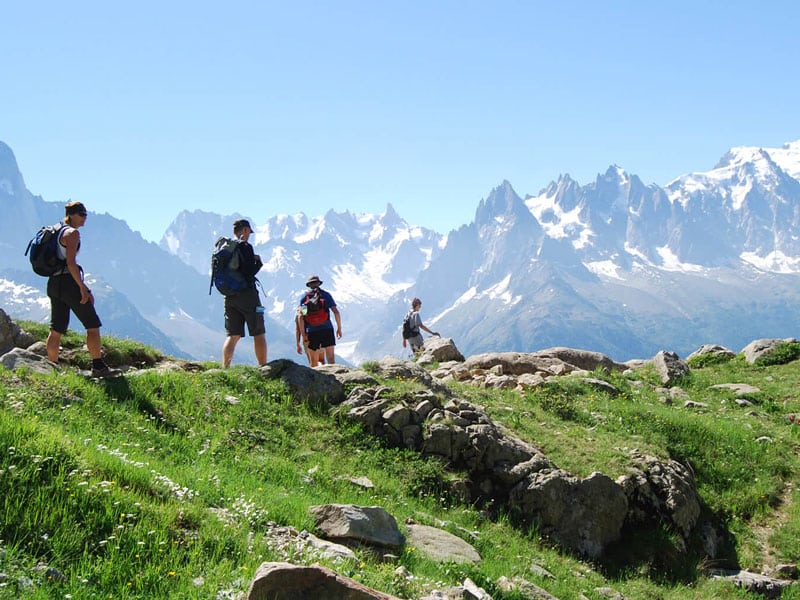
Tour du Mont Blanc Q&As from clients
What time is the airport transfer and planned briefing dinner schedule? Don’t worry about the timing – the driver will be there to pick you up at whatever time is convenient to you. We just need the flight number and arrival time. We don’t do one group transfer on arrival. The same goes for when …
Continue reading “Tour du Mont Blanc Q&As from clients”
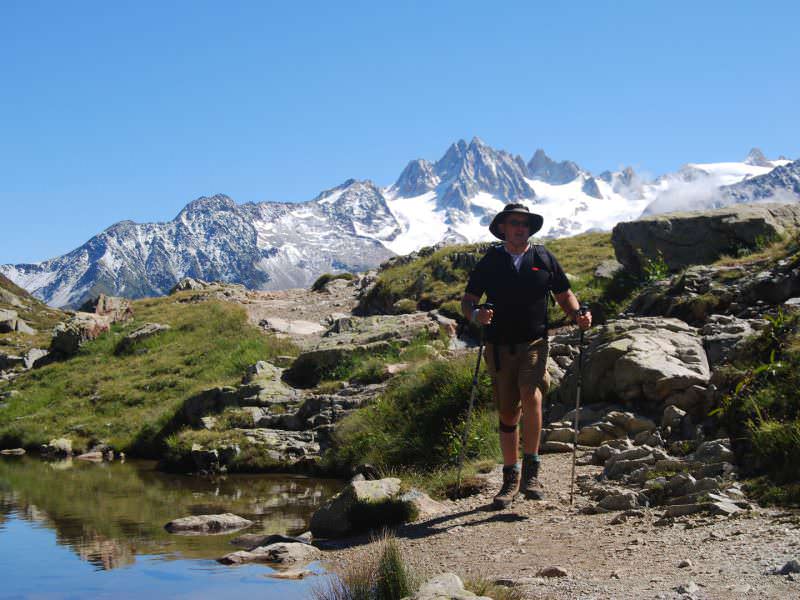
Tour du Mont Blanc – Q & A – Part 1
How much should I budget for dinner when it’s not included? Do you have any recommendations of where to eat? Dinner for the other nights: approx. 25 euros per dinner. The Guide will recommend where to eat. Is there hot water every day to shower? Yes there is. What is the age range on your …
Continue reading “Tour du Mont Blanc – Q & A – Part 1”
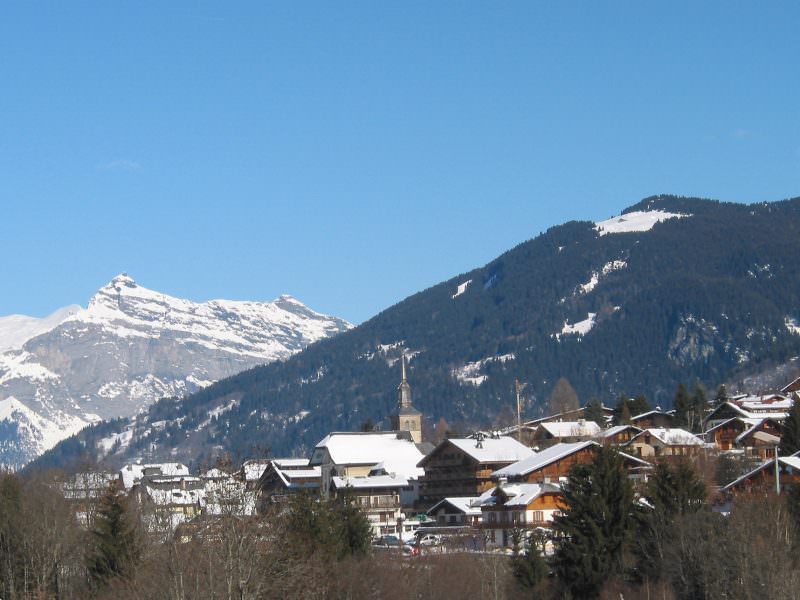
Tour du Mont Blanc: Facts
Tour du Mont Blanc distance The Tour du Mont Blanc is approximately 170km /106 miles long although has some variantes that add to this distance. Most people choose to do the TMB in 8 – 10 days and stay at hotels or refuges en-route. Each daily stage varies in length, but are generally 16-22km / …
Continue reading “Tour du Mont Blanc: Facts “
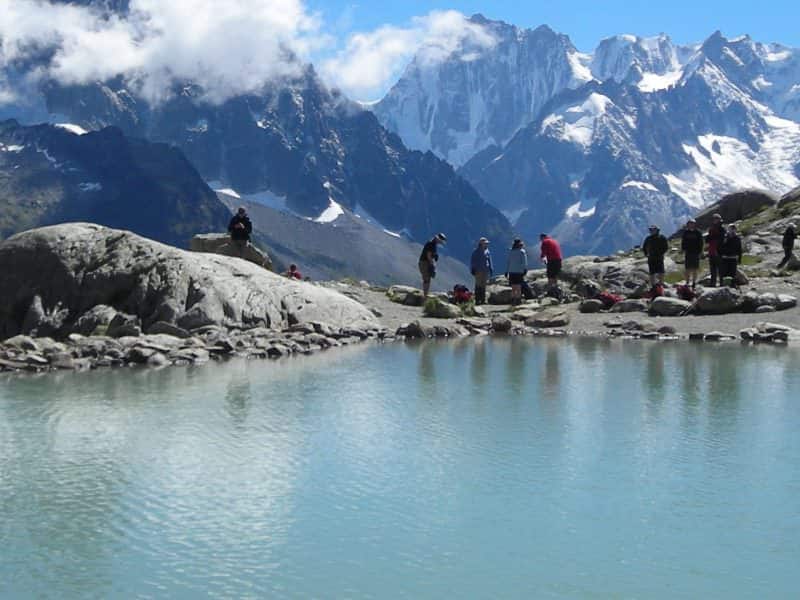
Holidaying in the Tour du Mont Blanc
Tour du Mont Blanc Holiday Highlights The Tour du Mont Blanc is justifiably one of World’s most famous hiking trails. Popular with people from all over the world, notably Europe, USA, Canada and Australasia. Hiking through the Alpine landscapes with spectacular mountain views. Hotels and other accommodation are generally very good for a point to point …
Continue reading “Holidaying in the Tour du Mont Blanc”
What is the Tour du Mont Blanc?
The Tour du Mont Blanc is one of the greatest walks in the world. It is just over 165 kilometres long, crosses at least six big mountain passes and the route makes its way through France, Italy and Switzerland. The scenery, villages, food and culture is interesting and varied. Above all, is the massive feeling of achievement once you have hiked the full circuit of the Mont Blanc massif.
How fit do you have to be to do the tour?
The Tour du Mont Blanc (TMB) is a long-distance hiking route that often forms part of an enthusiastic trekker’s tick-list. Together with other well-known trails such as Everest Base Camp, Machu Picchu and summiting Kilimanjaro, the TMB is a memorable world-class trek. However, unlike the other treks there are no issues with high altitude and so it can be comfortably completed by anyone who is fit.It is easily accessible and takes only one hour from Geneva Airport to the Chamonix Valley where most people begin the trek.
How long is the trek?
Walking, trekking, hiking the Tour Du Mont Blanc can be a challenge. The trek can take anywhere between 5 and 12 days to complete: most people will complete 8 to 10 daily walking sections and cover 12-20km per day. Each day will involve a significant ascent – most often up to 1000 metres – and then a similar descent to your night-stop. And while you trek you will see constant changes in scenery, meet lots of fellow trekkers and feel changes to the temperature. As you climb higher, the air becomes cooler and it is not uncommon to change from shorts and T-shirts into long trousers and a fleece jacket in a matter of minutes. Weather on Mont Blanc can be varied: you can expect warm, sunny days, but it is not unusual to have frontal weather systems bringing cold and wet weather. Thankfully, these are not too common.
Is age a barrier to the Tour Du Mont Blanc?
So long as you are confident of your fitness, enjoy being outdoors for most of the day and love a good trek, the trek is accessible to anyone. Our previous clients have ranged in age from 14 to 82.
What are the best hotels and refuges?
There are a variety of places to stay from simple mountain huts (refuges) with dormitory-style sleeping arrangements to three-star hotels offering rooms with attached bathrooms. Most people are pleasantly surprised at the quality of hotels on the TMB – and it is one of the unique features of this hike. Many other long-distance hikes, such as the GR10 that runs length of the Pyrenees or the GR20 that traverses the spine of Corsica, are fabulous treks, but only offer mountain huts on many of the nights. The Tour du Mont Blanc offers good accommodation on all nights – and it is possible to have twin rooms on all nights. This makes it more attractive to those who want a bit more comfort.
What kind of scenery, flora and fauna will you see?
The high and snow-covered Alpine peaks are spectacular. Many of them are over 4000 metres high and have glaciers tumbling down their precipitous sides. Aside from Mont Blanc itself, you will see famous mountains such as Les Drus, Les Grandes Jorasses, Le Vert and the ominous Aiguille du Midi. All of these have been a magnet to climbers and adventurers for over two centuries: Mont Blanc was first climbed in 1786. For hikers, you find yourself constantly stopping and gazing at the jaw-dropping views.
The wild flowers are beautiful: the best time to come is late June and early July, just as the winter snows have melted, when you are sure to see orchids, gentians and primulas. There are the forests full of rhododendrons and massive conifer trees and you will perhaps eat the blueberries and wild strawberries found by the trail.
Wild and domesticated animals are common place. There are herds of sheep, goats and cows, looked after by farmers and shepherds. But the real fun is when you spot a wild Alpine ibex (bouquetin), mountain goat-antelope (chamois) or perhaps a stoat. The birds are varied and sightings of lammergeyers and eagles are not uncommon.
Should you take a guided or self-guided tour of Mont Blanc?
This is purely a matter of individual choice. Some people prefer to go alone or enjoy the trek with a friend. Others prefer the security and professionalism of trekking with a Guide who will have a good knowledge of the route, take care of the hotels, meals and transport and be able to quickly react if there is an emergency. All trekking guides on the Tour du Mont Blanc have to be fully qualified and part of the governing body called UIMLA: it is a legal requirement in the Alps.

- Start: Les Saisies
- Finish: Les Saisies
- 330 km - 8300 m/d+
- Start 1 : Les Saisies Start 2 : Gd-St-Bernard
- Finish 1 : Gd-St-Bernard Finish 2 : Les Saisies
- Leg 1 : 155 km - 4300 m/d+ Leg 2 : 175 - 4000 m/d+
LE TOUR DU MONT BLANC
You are at the starting line, in the heart of the beautiful ski resort of Les Saisies, it is 4:55 in the morning and you turn on your front light. You listen to the latest safety instructions from the speaker. 4:58 , the departure music starts, a lot of thoughts jump inside your head: “What am I doing here? “Why do I hurt myself like that? “Am I really ready for this huge challenge?” “Why do I do that?”
But you know the answer: To become a Hero! “Hero: person who shows great courage.”
Reference among the ultra events, the Tour du Mont-Blanc Cyclo will require you a flawless preparation, extraordinary courage and push you to exceed your limits to become a hero. Because yes, becoming a hero is the goal of every participant of the Tour du Mont-Blanc. “ The world’s toughest one day bike race ”. This is how the cycling press describes the Tour du Mont-Blanc Cyclo. Indeed, riding 330km and face the 8300m of elevation gain that we offer you, in one day, is not an easy task!
On the program again for the twelfth edition, the crossing of 3 countries, France , Switzerland and Italy . You will once again be confronted with a demanding and ruthless route that will await you with constant strength. A unique experience to be sure.
Epic images

‘Liège-Bastogne-Liège changed my cycling life’ - Wout Poels takes new road to Monument via Tour of the Alps
2016 winner takes inspiration from teammate and last year’s third place finisher Sanitago Buitrago

Wout Poels will be one of a handful of former winners at this year’s Liège-Bastogne-Liège on Sunday, but the Bahrain Victorious rider is taking a new approach to the final Classic of the spring.
The Dutchman has taken inspiration from teammate and podium-finisher in 2023, Santiago Buitrago, by completing five days of preparation for Liège-Bastogne-Liège at the Tour of the Alps before taking on Tadej Pogačar (UAE Team Emirates), Tom Pidcock (Ineos Grenadiers) and Mathieu van der Poel (Alpecin-Deceuninck).
The now-veteran, 36-year-old Poels will make his 11th start at La Doyenne on Sunday, eight years after he took the biggest win of his career in a reduced-group sprint ahead of Michael Albasini and Rui Costa while riding for Team Sky.
He has often completed the Ardennes races as a trio of races but after his Colombian teammate found great form with third in 2023 after racing in South Tyrol and Trentino, Poels has opted to follow suit.
He has not taken a top 10 at Liège-Bastogne-Liège since 2019 but hopes that will change on Sunday, after flying to Belgium from Italy after the Tour of the Alps ends on Friday.
Liège-Bastogne-Liège 2024 - Analysing the contenders
How to watch Liège-Bastogne-Liège 2024
Liège-Bastogne-Liège 2024 Race information
“I hope it's a good prep but it's all gonna be very tight and it's a little bit of a gamble for myself but we will see. Last year it worked pretty well with Santi [Buitrago] so hopefully, it will work well for me also,” Poels told Cyclingnews.
“It’s always nice to go back, Liège-Bastogne-Liège changed my cycling life of course.”
Get The Leadout Newsletter
The latest race content, interviews, features, reviews and expert buying guides, direct to your inbox!
Poels’ only Monument triumph came amid his stint as one of the super domestiques at Team Sky who worked tirelessly to help Chris Froome take four Tour de France titles.
Pinned to his Instagram page is the post from that day in 2016 with the caption “So this was really not a dream…”
It will of course be a tough ask to beat the modern-day superstars of professional cycling but Poels knows just what it takes on those brutally long days in the saddle.
Despite riding a tough wet stage in Austria on Wednesday, Poels joked he wasn’t too eager to get back to racing in Wallonia after seeing the hellishly cold conditions that saw only 44 men finish Flèche Wallonne.
“To win a Monument is really nice to have behind your name so for sure that race is always pretty special,” Poels said.
“But hopefully, the weather is better than Wednesday in Fleche, it was looking really cold.”
If Buitrago’s performance from last year is anything to go off, Poels is well on track to perform at Liège. The Colombian was eighth overall at the Tour of the Alps in 2023 while the Dutchman currently sits equal-third, 48 seconds off the lead of Juan Pedro López (Lidl-Trek) after the Spaniard won stage 3.
He’s also been working for young Italian Antonio Tiberi, with his teammate also 48 seconds off the lead. They’ll have one more chance on Friday to try to snatch the overall victory.
After racing Liège-Bastogne-Liège, Poels will begin his final preparations for the Giro d’Italia, where he will be chasing a stage win to complete the illustrious Grand Tour set after his breakaway successes from the Tour de France and Vuelta a España in 2023.
Poels took two of the finest breakaway wins of the season in 2023, beating Belgian superstars Wout van Aert (Visam-Lease a Bike) and Remco Evenepoel (Soudal-QuickStep) on the summit finish to Saint-Gervais Mont-Blanc at the Tour de France and then the reduced-group sprint to Guadarrama at the Vuelta a España.
He’s a changed rider after swapping his domestique role at Team Sky to follow his own ambitions at Bahrain-Victorious in 2019, but it wasn’t an immediate transition into winning for the Dutchman with a three-year win-drought only coming to an end at the Ruta del Sol in 2022.
“Last year was amazing of course with the Tour and the Vuelta and that was a little bit of the reason why I changed teams,” Poels admitted.
“It took four years to achieve that but it's super nice to have. Of course this year the big goal is going to be at the Giro to have a stage in all three Grand Tours and I think we’re really good on track for that.”

Thank you for reading 5 articles in the past 30 days*
Join now for unlimited access
Enjoy your first month for just £1 / $1 / €1
*Read any 5 articles for free in each 30-day period, this automatically resets
After your trial you will be billed £4.99 $7.99 €5.99 per month, cancel anytime. Or sign up for one year for just £49 $79 €59

Try your first month for just £1 / $1 / €1

James Moultrie is a gold-standard NCTJ journalist who joined Cyclingnews as a News Writer in 2023 after originally contributing as a freelancer for eight months, during which time he also wrote for Eurosport, Rouleur and Cycling Weekly. Prior to joining the team he reported on races such as Paris-Roubaix and the Giro d’Italia Donne for Eurosport and has interviewed some of the sport’s top riders in Chloé Dygert, Lizzie Deignan and Wout van Aert. Outside of cycling, he spends the majority of his time watching other sports – rugby, football, cricket, and American Football to name a few.
Matt Beers: Coming off Cape Epic win, I'm pretty confident for Sea Otter
British science and French panache: Simon Carr finds the perfect balance at Tour of the Alps
Unfinished business and a shot at history – Pogacar and Van der Poel face off at Liège-Bastogne-Liège
Most Popular

IMAGES
VIDEO
COMMENTS
The Tour du Mont Blanc or TMB is one of the most popular long-distance walks in Europe. It circles the Mont Blanc massif, covering a distance of roughly 165 kilometres (103 mi) with 10 kilometres (6.2 mi) of ascent/descent and passing through parts of Switzerland, Italy and France.
Join Mont Blanc Treks for one of the world's most spectacular classic treks around the Mont Blanc mountain range. Choose from full circuit, best of, or western or eastern sections, with professionally guided or self guided options.
The Tour du Mont-Blanc hikers diary. Focus Nature Reserves : good and banned practices summer 2023. Read more. Get ready to go. The route, the safety, the conditions, the equipment: everything you need to know about the Tour du Mont-Blanc. The TMB and the trails around Mont Blanc. Accomodations. Safety.
Learn everything you need to know to plan your Tour du Mont Blanc, the iconic 170 km trekking trail through France, Italy and Switzerland. Find out the best stages, refuges, routes, tips and advice for your TMB adventure.
The Tour du Mont Blanc (TMB) is a captivating multi-day hike that circuits the Mont Blanc massif in usually 10-11 days, passing through France, Italy and Switzerland. The main Tour du Mont Blanc route is 170 km (105 miles) long and involves 10,080 meters (33,071 feet) of elevation gain and loss. The Mont Blanc mountain range takes its name from ...
The Tour du Mont Blanc covers a distance of roughly 170 kilometres and gains more than 10,000 meters of altitude over 11 stages. Most people start their hike in Les Houches, France going in an anti-clockwise direction. During this trek you will hike in the French, Italian and Swiss Alps and spend the night in mountain huts.
The Tour du Mont Blanc is roughly 170 kilometres (110 miles) long with 10,000 metres (6 miles) of ascent/descent as it passes through parts of Switzerland, Italy and France while circling the Mont Blanc massif. As much as some super-hikers like to let everyone know how they raced around it in 7 or 8 days, anyone who says it was easy is either ...
The Tour du Mont Blanc is the most popular long-distance trek in Europe that covers a total distance of approximately 170km depending on which route is taken (some variants can be sorter or longer than the original section). The daily height gain on the Mont Blanc circuit is substantial, and overall the accumulation over the 10 days is in the ...
Circling the largest peak in the Alps, Mont Blanc, the trail covers 170km (105 miles), climbs more than 10,000m (32,800ft) in cumulative altitude, and weaves through three Alpine countries: France, Italy and Switzerland. Typically, the route begins and ends in Les Houches, France, and follows a counterclockwise loop around the mountain range.
The Tour du Mont Blanc (TMB) is a 170-km trek that circles the Mont Blanc massif. The route is traditionally walked in the anti-clockwise direction over 11-stages. The TMB starts and finishes in the French village of Les Houches, which sits adjacent to the popular mountain town of Chamonix.
The Tour du Mont Blanc spans 105.6 mi, granting plenty of time to bask in the wild, undulating scenery stamped by the intoxicating Mont Blanc Massif. Most trekkers complete this incredible outdoor adventure in 8 to 11 days, but transportation assistance can shorten your time. Taking alternate routes along the trail may also manipulate how long ...
Mont Blanc, Western Europe's highest mountain, is 4.808 meters above sea level, making its altitude one of the greatest and most challenging ones. However, as we have previously mentioned the Tour De Mont Black does not involve ascending to its top. In fact, the highest peak along the standard route is 2.537 meters above sea level, which is ...
Tour du Mont Blanc Hiking - Routes, Maps and Itineraries. The Tour du Mont Blanc is a 170 km trek that encompasses the whole of the Mont Blanc Massif; with nearly 10 000m of cumulative descent and ascent it is usually completed in a number of days. The TMB has a variety of accommodations along its way (hotels and mountain huts with possibility ...
The Tour du Mont Blanc is a classic inn-to-inn alpine trek—one which Alpenwild has refined with many creature comforts, exquisite cuisine, and superb accommodations. As you trek the Tour du Mont Blanc, you'll experience the culture, the rich history of the Alps along with the stories of how this massive mountain has beckoned hikers and ...
The Tour du Mont Blanc is a 168 km (104 mile) trail that goes around the Mont Blanc Massif and has a total height gain and loss of 32,000 feet (10,000m) depending on the variants you choose…that's the equivalent of climbing Mount Everest (without the high altitude of course). Mont Blanc isn't solitary. It's surrounded by a breathtaking ...
The Tour du Mont Blanc is an epic hiking experience that takes you through three countries - France, Italy, and Switzerland - in an intense week. This adventure invites you to measure yourself against the majesty of the Alps, crossing mountain passes such as the Col du Brévent, the Col de la Seigne, and the Col des Fours, while admiring ...
The Tour du Mont Blanc (TMB) is a loop hike of ~110 miles with ~30,000 feet of elevation gain (and subsequent loss) that circumnavigates Mont Blanc massif, a 16,000-footer in the Alps. The trail's highest point is 8,700 feet, which is not high enough to cause altitude sickness in most people. It's easiest to fly into Geneva (though there ...
The Tour du Mont Blanc, or the TMB, is a 105-mile (170 km) trail that circumnavigates Mont Blanc, the highest peak in Europe. The TMB is often considered one of the most beautiful through-hikes in the world, introducing hikers from around the globe to the exquisite and dramatic scenery of the Alps.
The Tour du Mont Blanc difficulty level is somewhat subjective to the hiker. The Gouter route is relatively easy because it takes about two days to reach the ascent and does not require extensive ...
The Tour Mont Blanc easterly trek starts in Courmayeur and takes in half of the classic route anti-clockwise to Chamonix. It is a 6 day trek that covers approximately 100 kilometers through the Italian, Swiss and French alps. This walking holiday in the alps is ideal for those wanting to experience the Tour du Mont Blanc in a shorter period of ...
The Tour du Mont Blanc is one of the greatest walks in the world. It is just over 165 kilometres long, crosses at least six big mountain passes and the route makes its way through France, Italy and Switzerland. The scenery, villages, food and culture is interesting and varied. Above all, is the massive feeling of achievement once you have hiked ...
Reference among the ultra events, the Tour du Mont-Blanc Cyclo will require you a flawless preparation, extraordinary courage and push you to exceed your limits to become a hero. Because yes, becoming a hero is the goal of every participant of the Tour du Mont-Blanc. "The world's toughest one day bike race". This is how the cycling press ...
The Colombian was eighth overall at the Tour of the Alps in 2023 while the Dutchman currently sits equal-third, 48 seconds off the lead of Juan Pedro López (Lidl-Trek) after the Spaniard won stage 3.